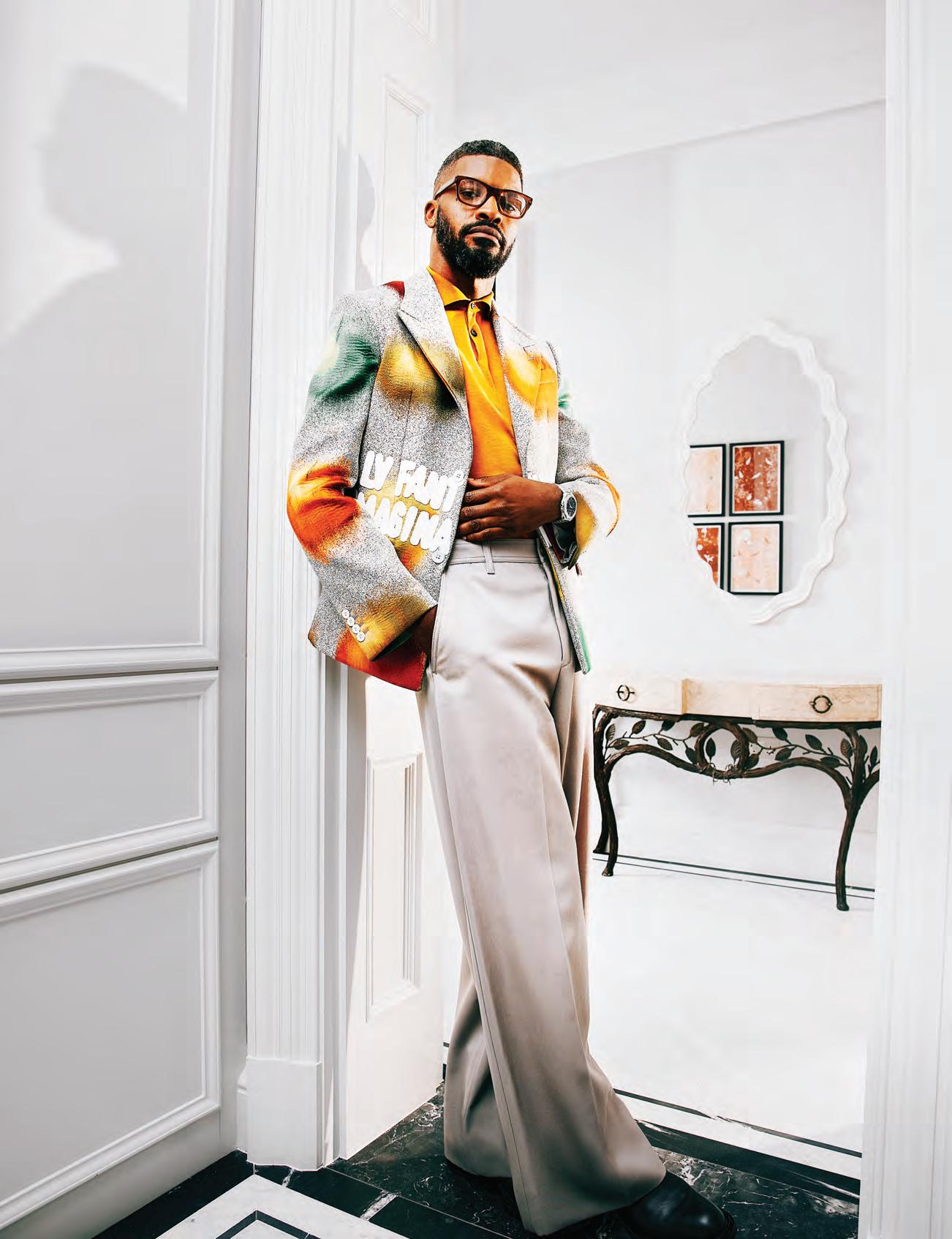


Autumn 2023 £8.00 MAGAZINE THE ISSUE BILLY PORTER, MIRANDA KERR, JEREMY HACKETT & PRIYA AHLUWALIA PLUS: HIGH JEWELLERY, FINE WATCHES, AW23’S BIGGEST TRENDS AND THE BEST NEW FASHION TOMES FOR YOUR COFFEE TABLE FEATURING enduring legacy COCO CHANEL’S style ROLLSROYCE’S electric dream
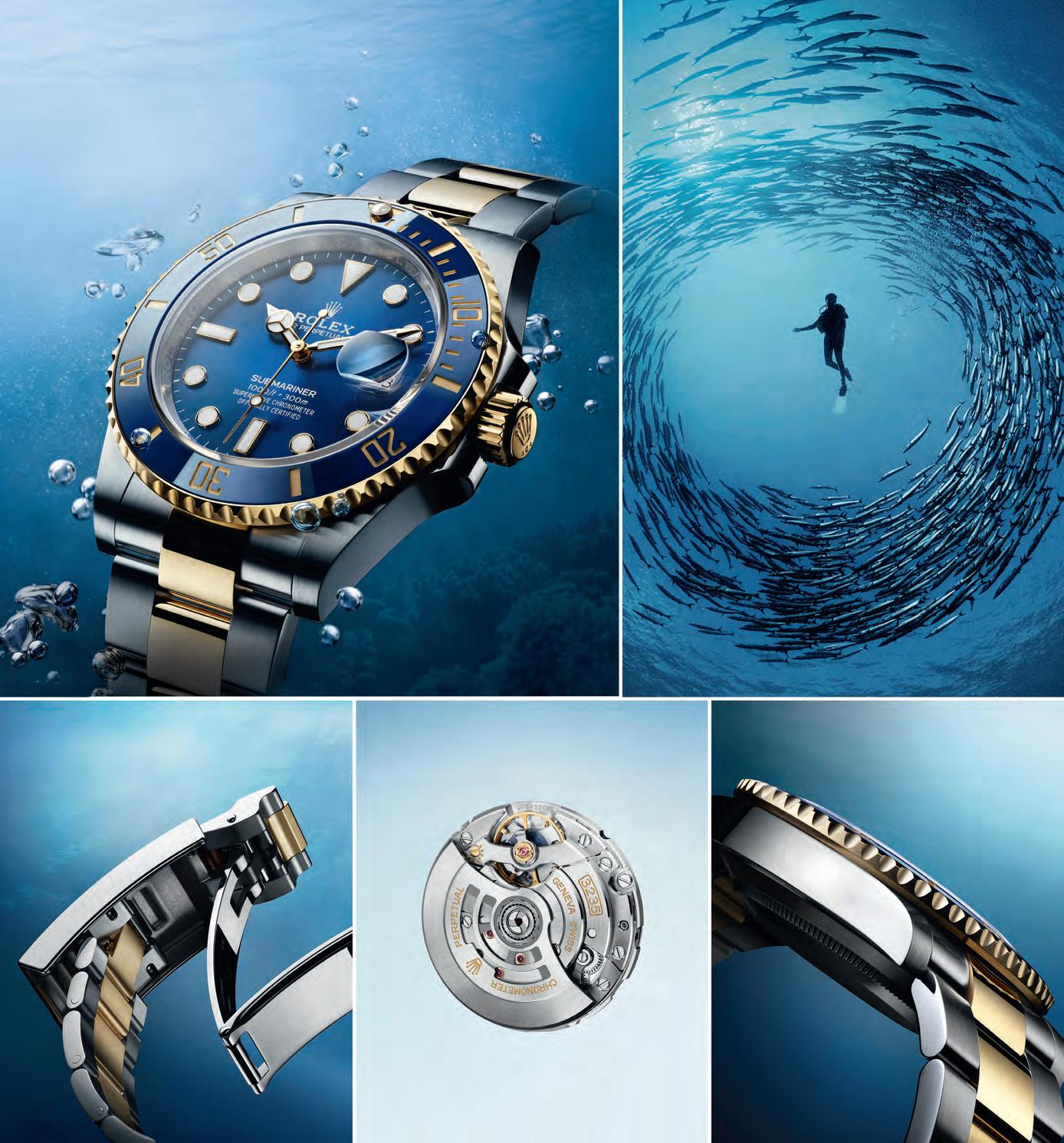





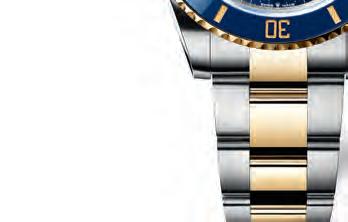


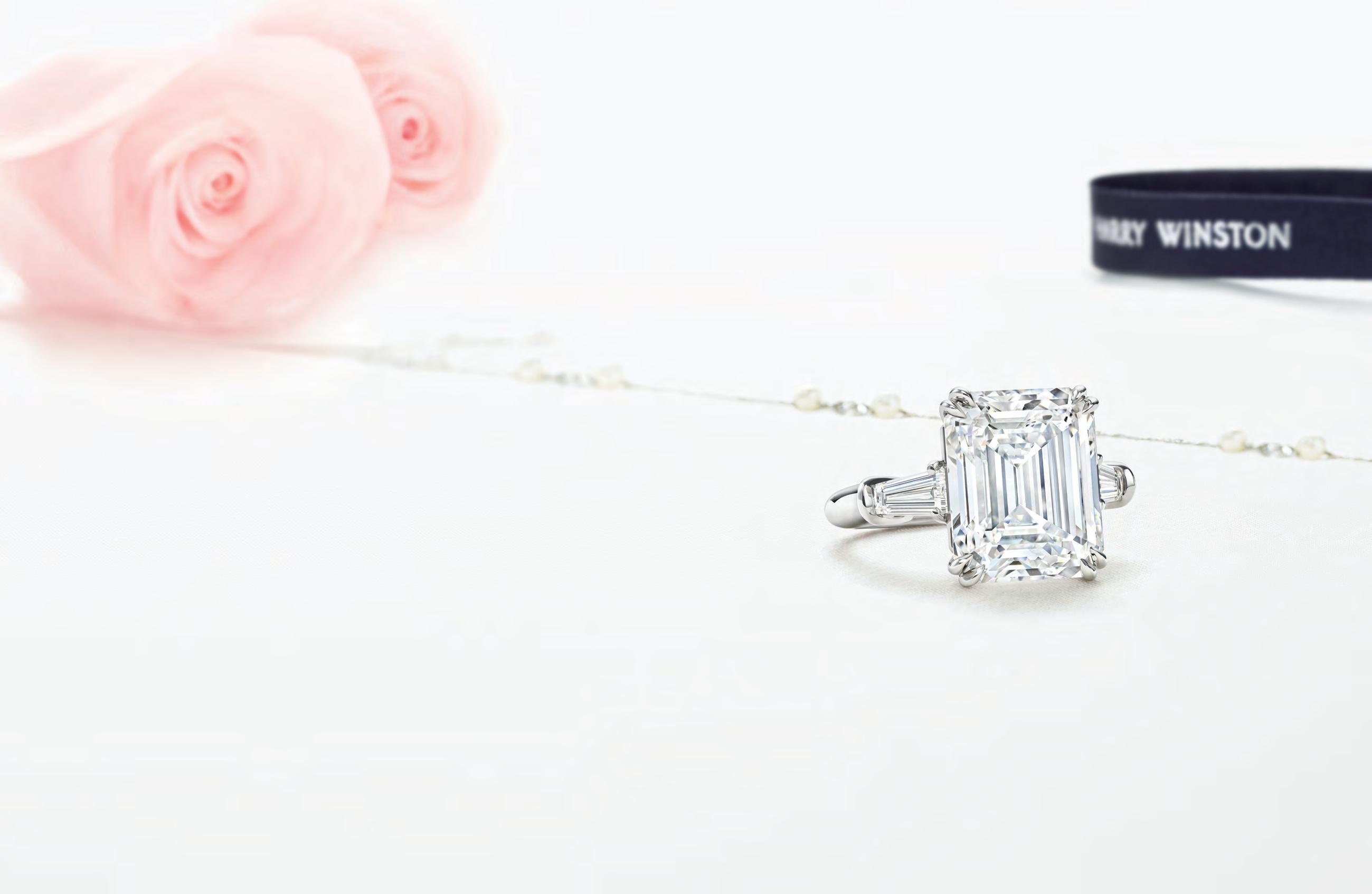



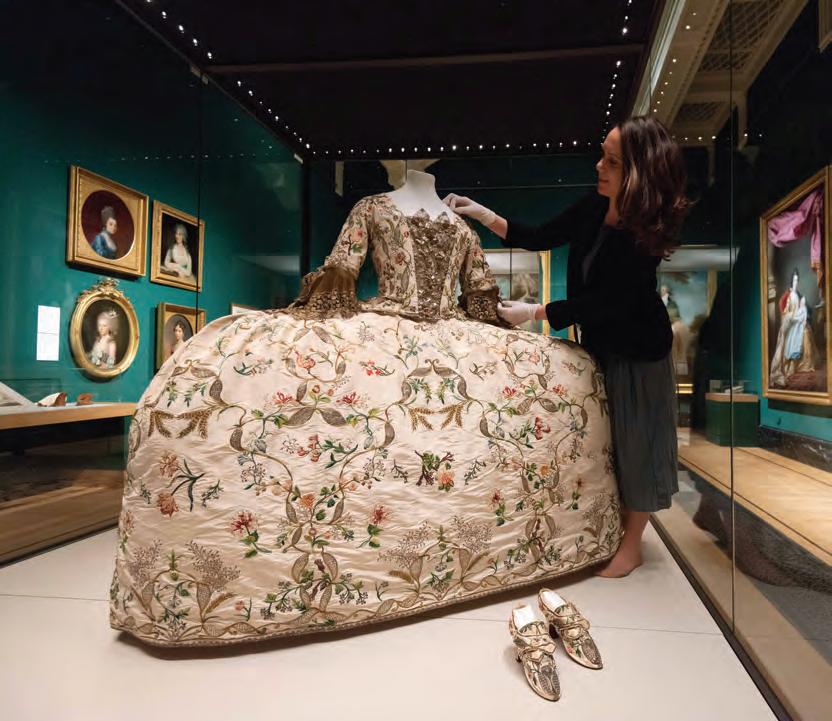

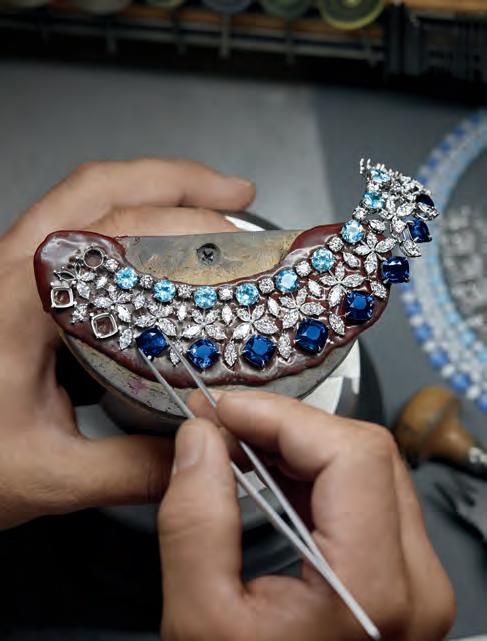
CONTENTS UP FRONT 13 THE BRIEFING The latest news from the world of luxury 32 BILLY PORTER The multi-hyphenate is leaving it all out there CULTURE 38 THE AGENDA Your curated guide to culture in the capital 48 WHO WA S THE REAL OPPENHEIMER? How did the theoretical physicist go from hero to villain? DRIVE 56 HIGH HORSE On the road with the first four-wheel-drive Ferrari 60 POWER TRIP Is the fully-electric Spectre the best Rolls-Royce ever? WATCHES & JEWELLERY 04 ABOUT TIME The latest happenings from the world of haute horology 10 BIG FISH. BIG POND Blancpain’s legendary dive watch, the Fifty Fathoms, turns 70 12 WHAT’S IN A WATCH NAME Is it a coincidence that iconic watches tend to have iconic names? 38 72







30 THE CEO INTERVIEW In conversation with Garrard boss, Joanne Milner 34 ROYAL CONNECTIONS For its latest collection, Harry Winston looks to the past COUTURE 68 STYLE HER What you’ll be wearing this season 72 THE REAL THING Priya Ahluwalia on why she’s sick of talking sustainability 80 THE NEXT CHAPTER What ex-Victoria’s Secret model Miranda Kerr did next 87 STYLE HIM Key pieces for a pared-back autumn 90 THE ORIGINAL INFLUENCER How Jeremy Hackett created a very British aesthetic ESCAPE 98 WELCOME TO THE JUNGLE Break with tradition and swap the beach for the Balinese rainforest 106 SMALL WONDER Welcome to Nevis, the tiny Caribbean island with a larger-than-life soul 114 SEVILLIAN SURPRISE The secluded 17th-century palace-hotel with plenty of charm 122 BEHIND THE SCENES The inside story of this issue’s watch and jewellery-focused fashion shoot Autumn 2023 MAGAZINE THE ISSUE BILLY PORTER, MIRANDA KERR, JEREMY HACKETT PRIYA AHLUWALIA HIGH JEWELLERY, FINE WATCHES, FEATURING enduring legacy COCO CHANEL’S style ROLLSROYCE’S electric dream LUXURY LONDON MAGAZINE AUTUMN 2023 ISSUE 33 COVER
32 67
Raashid Hooks photographed at The OWO Residences by Raffles by Adam Fussell for our Watches & Jewellery supplement
FROM THE EDITOR
AUTUMN 2023
Issue 33
It’s difficult to think of a more hotly-anticipated hotel opening than Raffles London. Not since The Rosewood opened in the old Pearl Assurance building in 2013 has the jet set waited so breathlessly to visit the capital. At that ritzy hotel in High Holborn, EPR Architects was charged with the task of turning a Grade II-listed Edwardian pile into a hotel that showcased the best of the old while adopting the very, very best of the new. The brief at Raffles, which opened in Whitehall’s The Old War Office in September, would have been almost identical.
Some other names involved at The OWO: Thierry Despont, the late, great FrenchAmerican architect responsible for revitalising New York’s Statue of Liberty; Zaha Hadid Architects, which has designed a shiny metallic restaurant-pavilion in the hotel’s cobbled courtyard; and Mauro Colagreco, proprietor of Menton’s Mirazur, which, in 2019, was voted the ‘World’s Best Restaurant’. Raffles represents Colagreco’s London debut, as it does for famed Milanese seafood restaurant, Langosteria, buzzy Parisian café, Lapérouse, and cosmetic maison-to-the-stars Guerlain, which has been put in charge of the hotel’s subterranean spa (it’s large enough to accommodate a 25-metre swimming pool).
Half The OWO is given over to the hotel; the other to managed apartments, marking Raffles’ European entry into the burgeoning branded residences market. This issue’s cover provides a glimpse of what owners can expect within the 1508 London-designed pied-àterres (former New York mayor, Michael Bloomberg, is said to have snapped up one of the apartments). You can go through the keyhole for yourself on page 16 of our Watches & Jewellery supplement.
The capital is in the midst of a hospitality boom. Raffles London will now go toe-to-toe with The Peninsula London, the pair of uber-hotels having opened within a fortnight of each other. The Dorchester recently dropped hundreds of millions on its first major refurbishment since the eighties; the London Hilton on Park Lane just reopened after spending vast sums of its own; while Mandarin Oriental Mayfair is slated to open this side of Christmas. Which all makes a very compelling argument for a London-based autumn staycation.
But which bolthole to choose?
EDITORIAL DIRECTOR
Richard Brown
DIGITAL
EDITORIAL DIRECTOR
Zoe Gunn
SENIOR EDITOR
Anna Solomon
ASSISTANT
DIGITAL EDITOR
Annie Lewis
BRANDED CONTENT & COMMERCIAL WRITER
Hitanshi Kamdar
EDITOR-AT-LARGE
Annabel Harrison
CONTRIBUTING EDITORS
Rob Crossan
Josh Sims
HEAD OF DESIGN
Laddawan Juhong
DESIGNER & PRODUCTION
Georgia Evans
MARKETING MANAGER
Tom Henry
ASSOCIATE DIRECTOR
Fiona Smith
MANAGING DIRECTOR
Rachel Gilfillan
BUSINESS
DEVELOPMENT DIRECTOR
Miles Dunbar
BUSINESS
DEVELOPMENT MANAGERS
Asleen Mauthoor
Daphne Kovacs
CLIENT RELATIONSHIP MANAGER
Alice Ford
CHAIRMAN
Eren Ellwood
PUBLISHED BY
RICHARD
BROWN Editorial Director
LUXURYLONDON.CO.UK

6 SALEM ROAD, LONDON, W2 4BU
T: 020 8152 7855
WWW.LUXURYLONDONMEDIA.CO.UK







BY APPOINTMENT TO HRH THE PRINCE OF WALES MANUFACTURER AND SUPPLIER OF FOOTWEAR CROCKETT & JONES LIMITED, NORTHAMPTON MADE IN ENGLAND | SINCE 1879 CROCKETTANDJONES.COM
HaSand Hurricane Hide A new brogue Chelsea boot. Made using our new Hurricane Hide. A comfortable, durable and winter-ready style
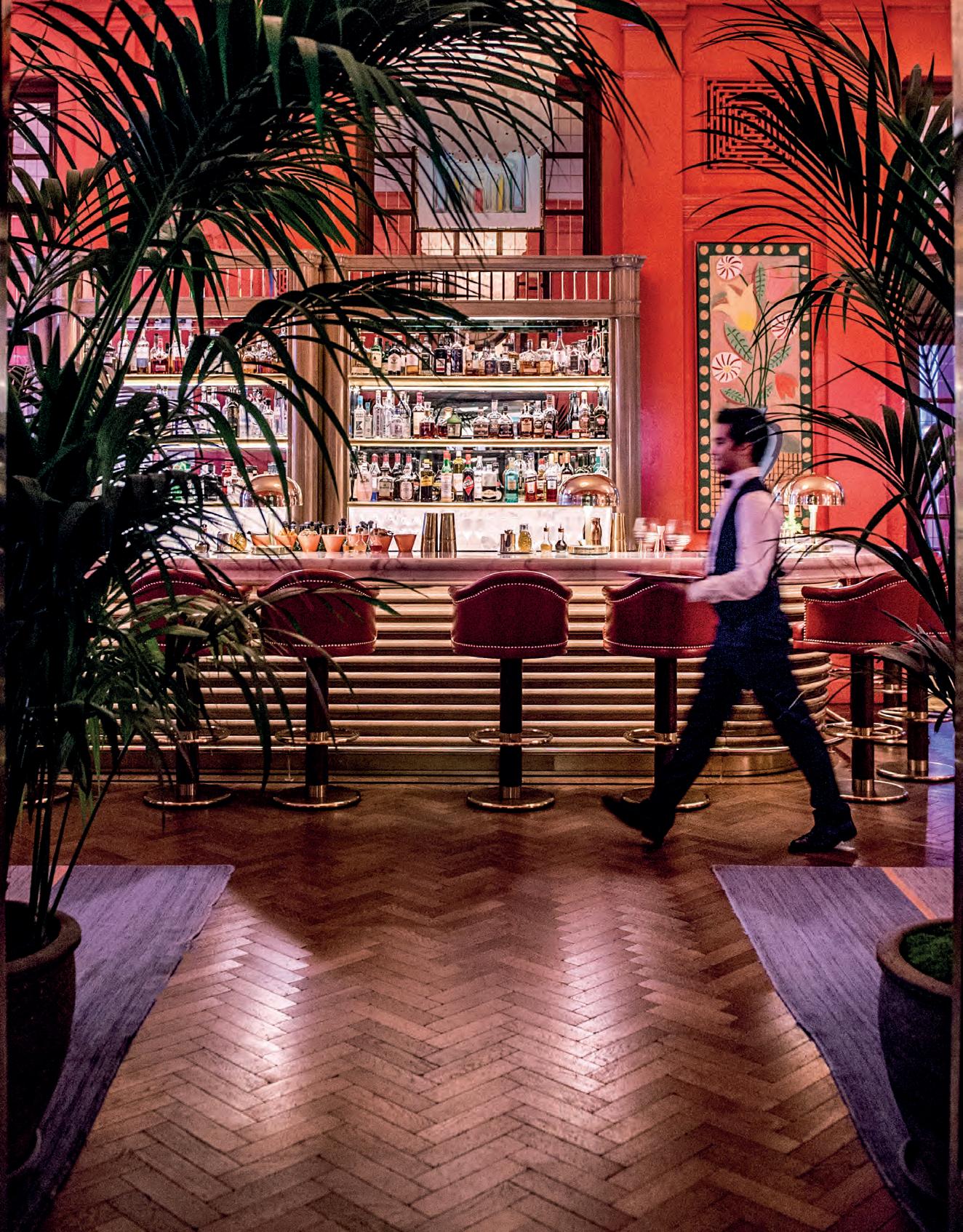
Experience a sumptuous festive season at The Bloomsbury hotel Enjoy one of our beautifully-designed suites and wine and dine in Dalloway Terrace, The Coral Room and Bloomsbury Club Bar. doylecollection.com/bloomsbury
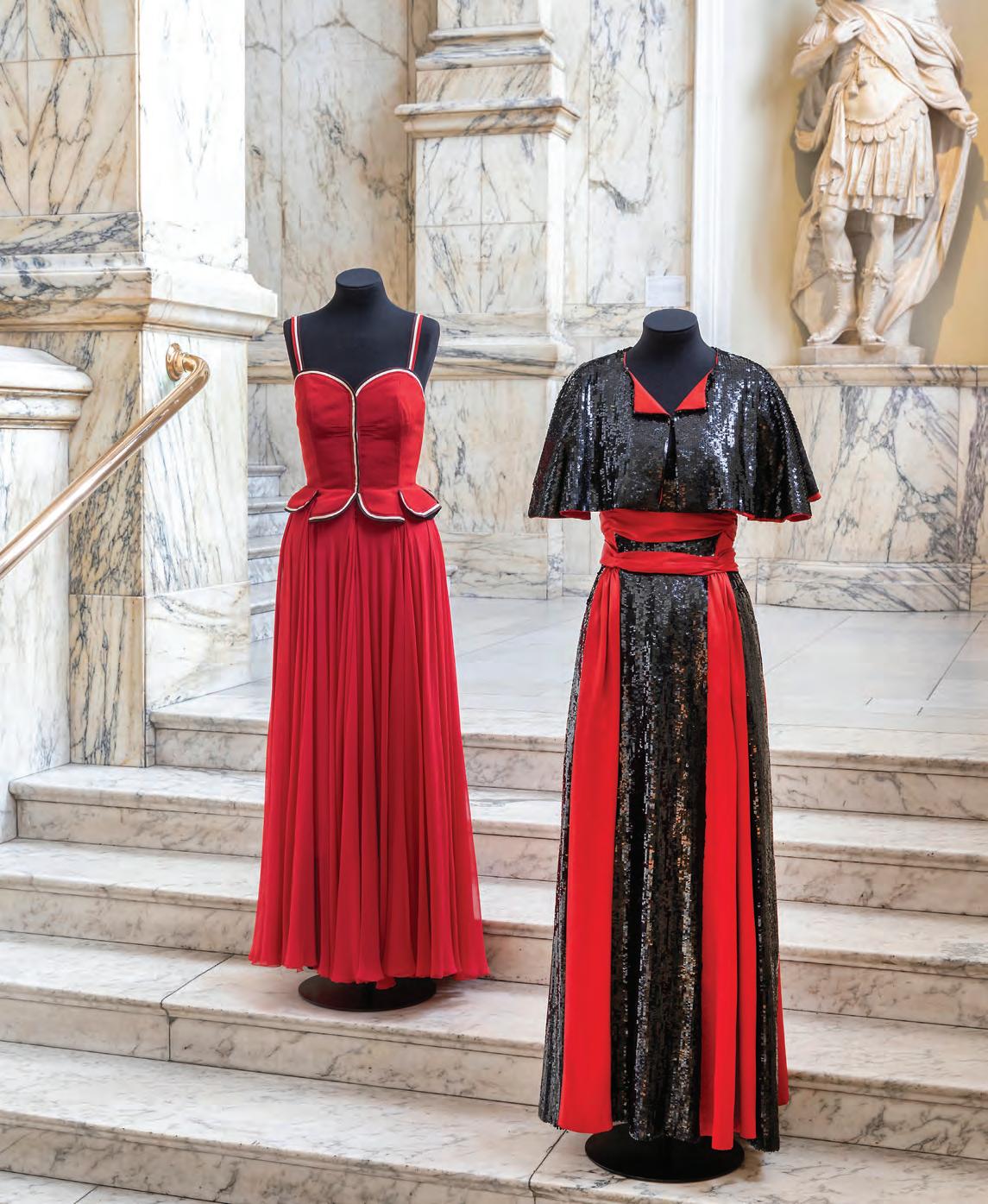

The
14 The Exhibition Exploring Coco Chanel’s enduring legacy at the V&A 18 The Hotel Why Cliveden House remains a very English affair 22 The Restaurant Is Bray’s The Hind’s Head Britain’s best pub? 26 The Car In tribute to the 720S – McLaren’s modern-day masterpiece 30 The Books The best new fashion tomes for your coffee table THE LATEST NEWS FROM THE WORLD OF LUXURY A first-ever UK exhibition
V&A
today, p.16
Briefing
at the
considers how the designs of Gabrielle
‘Coco’ Chanel continue to influence women’s fashion
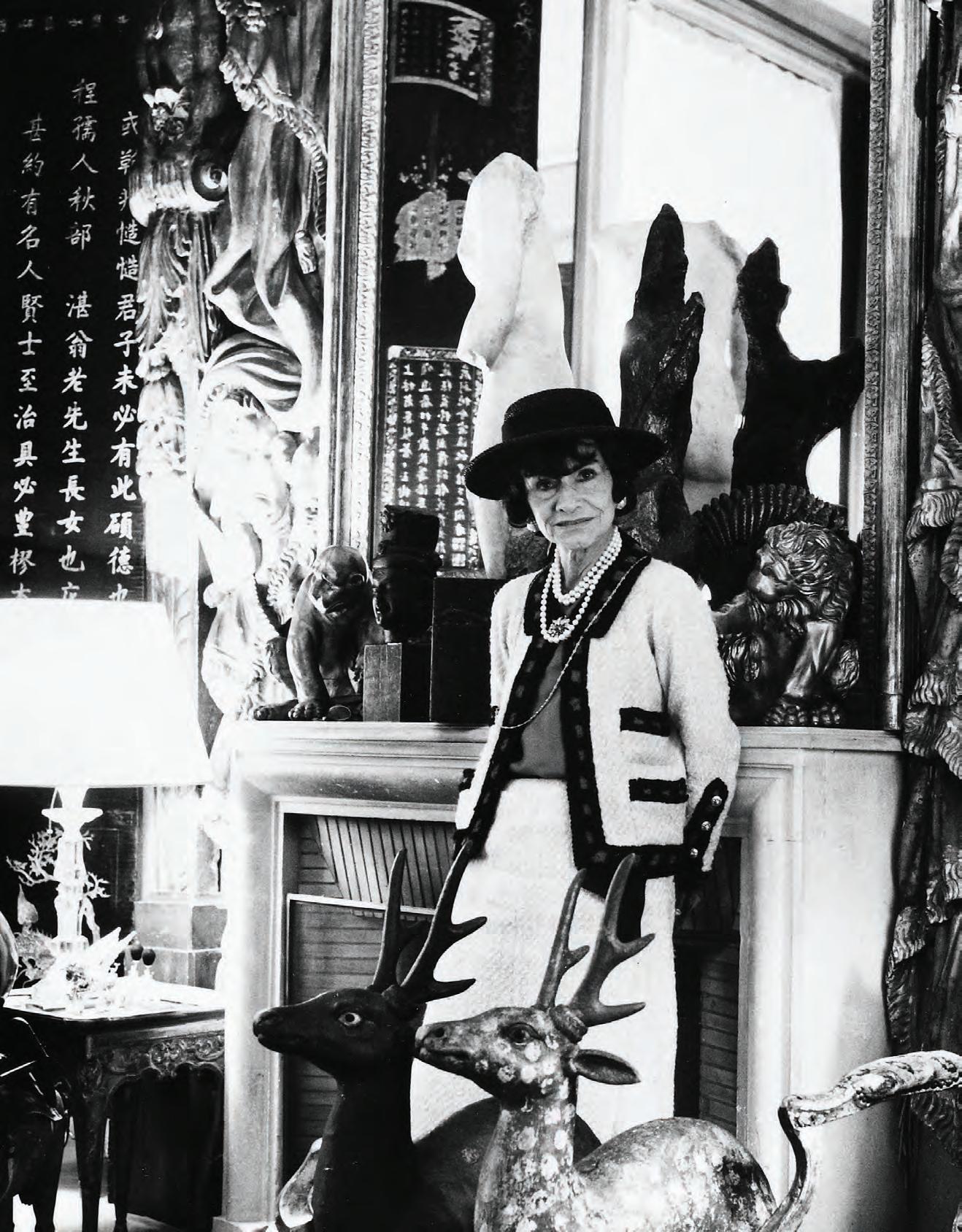
GABRIELLE ‘COCO’ CHANEL PHOTOGRAPHED BY CECIL BEATON IN 1953
01
THE EXHIBITION
Gabrielle Chanel. Fashion Manifesto
A LANDMARK RETROSPECTIVE AT THE VICTORIA AND ALBERT MUSEUM AIMS TO EXPLORE
HOW THE DESIGNER’S SIX-DECADE CAREER CONTINUES TO INFLUENCE THE WAY WOMEN DRESS TODAY
Words: Anna Solomon
This September, the first-ever UK exhibition dedicated to the work of French couturière, Gabrielle ‘Coco’ Chanel, launched at the Victoria and Albert Museum. Given that Chanel was one of the most influential designers of the 20th century, it’s surprising that there has never been a showcase of her work in the capital. Claims that she acted as a German spy during World War II might have something to do with that. In recent years, debates about how, and if, we should separate art from artist have only gotten fiercer. And while personal links uncovered by biographers between Chanel and certain German officers are hugely unsavoury, her professional legacy in the world of fashion, and the incontrovertible mark she left on women’s dressing, cannot be ignored – not least because it lives with us still.
When Chanel opened her first clothing boutique in Deauville, Normandy, in 1913 (a venture financed by an English suitor named Arthur Capel), Western fashion was still centred around the long, severe lines of the previous century. While corsets were on the decline, the hourglass shape still reigned supreme, as did stiff collars and broad hats. Women’s fashion was stuffy and uncomfortable during the Belle Époque (Beautiful Period) of the late 19th and early 20th centuries; Chanel set out to shift these parameters. “Nothing is more beautiful than freedom of the body,” she once said.
Chanel was one of the earliest champions of trousers for women, often borrowing pairs from her male lovers (she famously had a string of highprofile liaisons, including relationships with the
Duke of Westminster and Prince of Wales, Edward VIII). Even before the style was popularised among women during World War I – women having taken on manual jobs previously done by men –the designer was sporting flowy ‘beach pyjamas’ while holidaying on the French Riviera (a bold statement at the time, given pyjamas’ association with the bedroom).
By the mid-1920s, wealthy women were eschewing the skirt, and Chanel is widely credited with carrying the trend from the realm of the practical to the fashion-forward.
In 1926, Vogue published an image of a calflength crêpe de Chine black dress, predicting that the piece would become the fashion equivalent of the Ford Model T: a versatile, accessible item with universal appeal. The ‘little black dress’, the publication claimed, was ‘a sort of uniform for all women of taste’ – and Chanel was its creator. Here was a dress that was simple, shapeless even, without a waistline or bustline in sight. The wearer could move freely, sit comfortably, and exist safe in the knowledge that their outfit was Vogue -certified.
The Chanel suit, similarly, was a game-changer for women’s dressing. The two-pieces, which were first introduced in the 1920s, were made using traditional tailoring methods previously reserved for men’s clothing, thus employing a functional cut that sat comfortably on the hips rather than cinching in at the waist. Chanel’s suits were made with tweed and jersey, fabrics that were considered distinctly un-glamorous at the time. Which, of course, was the whole point: the suit wasn’t meant to beguile suitors, but to be worn to jobs in business.

15 LUXURY LONDON THE BRIEFING LUXURYLONDON.CO.UK
It wasn’t just garments; Chanel was also on a mission to revolutionise accessories. Take the Chanel 2.55, launched in 1955 (hence the name). It was a luxury bag, ostensibly, but it came with a shoulder strap – breaking from the convention of clutches, which were the fashion at the time –which made it profoundly practical. The simple modification of a strap offered women a newfound freedom. Suddenly they could – wait for it – use both hands while out and about!
Then there was the Chanel sling-back, a shoe that mixed comfort and elegance with its black toe to protect from wear and tear, moderate heel height and asymmetrical strap, which kept the footwear in place. Even Chanel’s perfume range went some way to democratising fashion and beauty; when she launched Chanel No.5 in 1921 she reportedly charged perfumer Ernest Beaux to create a scent that would make its wearer “smell like a woman, and not like a rose”.
There is a school of thought that says women’s
clothing has played a key role in their subjugation over the centuries; that, drowning under heavy silks and marooned in vast bustles, women were kept symbolically ornamental, but also physically subdued. You try protesting for the vote while your breathing is being restricted by a corset.
I’m not saying that Chanel adhered to this notion, or was even cognisant of the concept (we must be mindful of conferring modern ideas on historical figures) but, retroactively, we can say with certainty that her designs contributed to the sartorial emancipation of women. Chanel not only freed ankles and loosened waistlines, but also updated the way that society viewed women: as people with agency, autonomy, and the right to move around in the world with the same freedom as men.
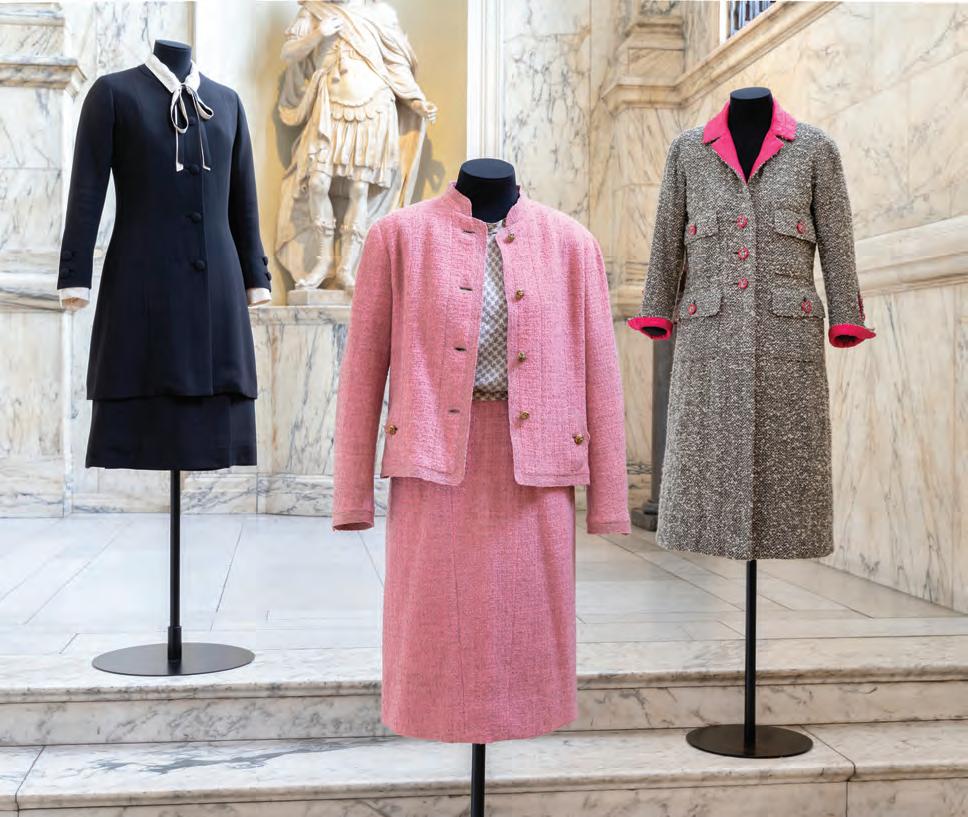 Gabrielle Chanel. Fashion Manifesto is on until 25 February 2024, tickets £24, vam.ac.uk
Gabrielle Chanel. Fashion Manifesto is on until 25 February 2024, tickets £24, vam.ac.uk
Chanel not only freed ankles and loosened waistlines, but also
updated
the way that society viewed women
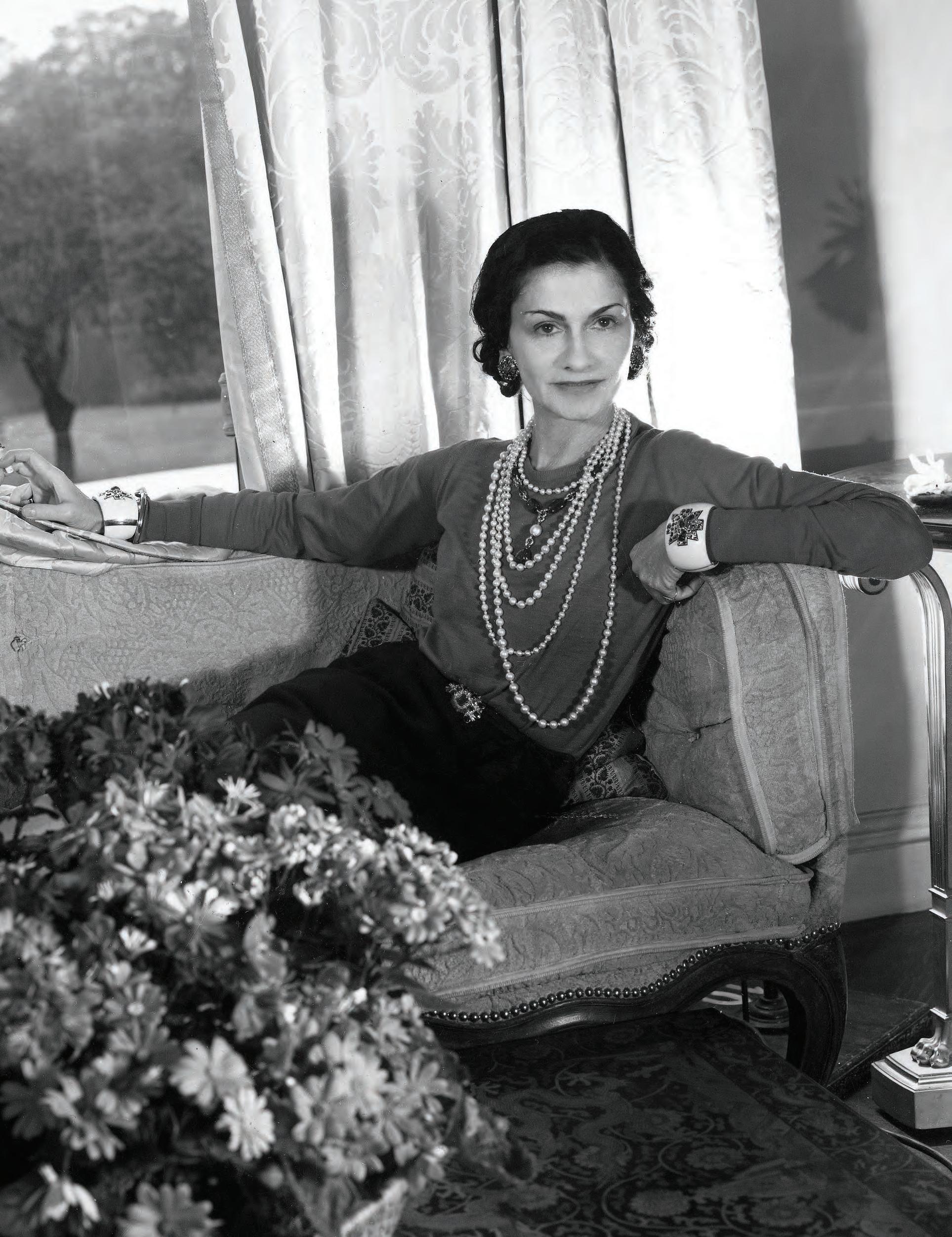
GABRIELLE ‘COCO’ CHANEL, PHOTOGRAPHED IN HER SUITE AT THE RITZ HOTEL IN PARIS, 1965
Cliveden House

SIXTY YEARS SINCE THE PROFUMO SCANDAL, THE THAMESIDE HOTEL AT THE HEART OF THE HULLABALOO REMAINS A VERY ENGLISH AFFAIR
Words: Rob Crossan
THE HOTEL 02
‘In its unbroken loveliness this is, perhaps, the sweetest stretch of all the river.’ With its boyish humour and comic one-upmanship you could argue that Jerome K. Jerome’s wildly successful Victorian farce Three Men in a Boat –which sees Jerome and a brace of hapless friends embark upon a disastrous riverboat holiday on the River Thames – is proof enough that something approaching ‘lad mag’ culture has existed as far back as the 1880s. Indeed, you could no doubt successfully plot a line of literary male incompetence and macho embellishment from the slapstick humour of that novel all the way to the cringe-heavy comedy of The Inbetweeners.
For real-world proof of the Y-chromosome’s propensity for dim-witted dalliances we can look to a decade halfway between the publication of Jerome’s witty, water-based masterpiece and the travails of Will, Simon, Jay and Neil in a suburban sixth form.
Located on the banks of that same river, amid Berkshire’s clipped topiary and manicured lawns, Cliveden House, a Palladian pile designed by Charles Barry (better known for the Houses of Parliament) is one of the best-preserved examples of the jiggery-pokery that can occur when American money meets British high society.
Destroyed by fire, twice, in the preceding centuries, the Cliveden that became a byword for louche behaviour among the upper echelons of British society was given license by William Waldorf Aston, once America’s richest man, who bought the place in 1893.


For the next seven decades he and his family, which included his epicene daughter-in-law, Nancy, Britain’s first female MP, hosted everyone from Winston Churchill to Mahatma Gandhi. Yet no visitor caused as many ripples as a topless dancer by the name of Christine Keeler.
Invited for a weekend of utile hedonism by ‘osteopath to the stars’ Dr Stephen Ward in July 1961, a nude swim in the Cliveden pool brought 19-year-old Keeler to the attention of John Profumo’s wandering eye and restless groin.
The affair between Keeler and the thenMinister for War brought down Harold MacMillan’s Conservative government and, for the first time, enabled the chattering classes, just emerging from post-war rationing, to come to terms with the then apostate notion that the panjandrums who ruled them could have moralities as porous as powdered eggs.
Soon after the scandal, Cliveden was vouchsafed to the National Trust, while Nancy Astor fled from the now tainted ludic gambols of the aristo party set for a life of obscurity somewhere near Godalming, Surrey.
Cliveden today still represents everything that an American would expect from an English country house, all the way down to the portrait of Nancy that hangs in the wood-panelled, unnaturally vast reception room, painted by John Singer Sargent, another American who got caught in the tractor beam of the Brideshead myth.
The National Trust routinely refuses filming requests for anything to do with the Profumo affair,
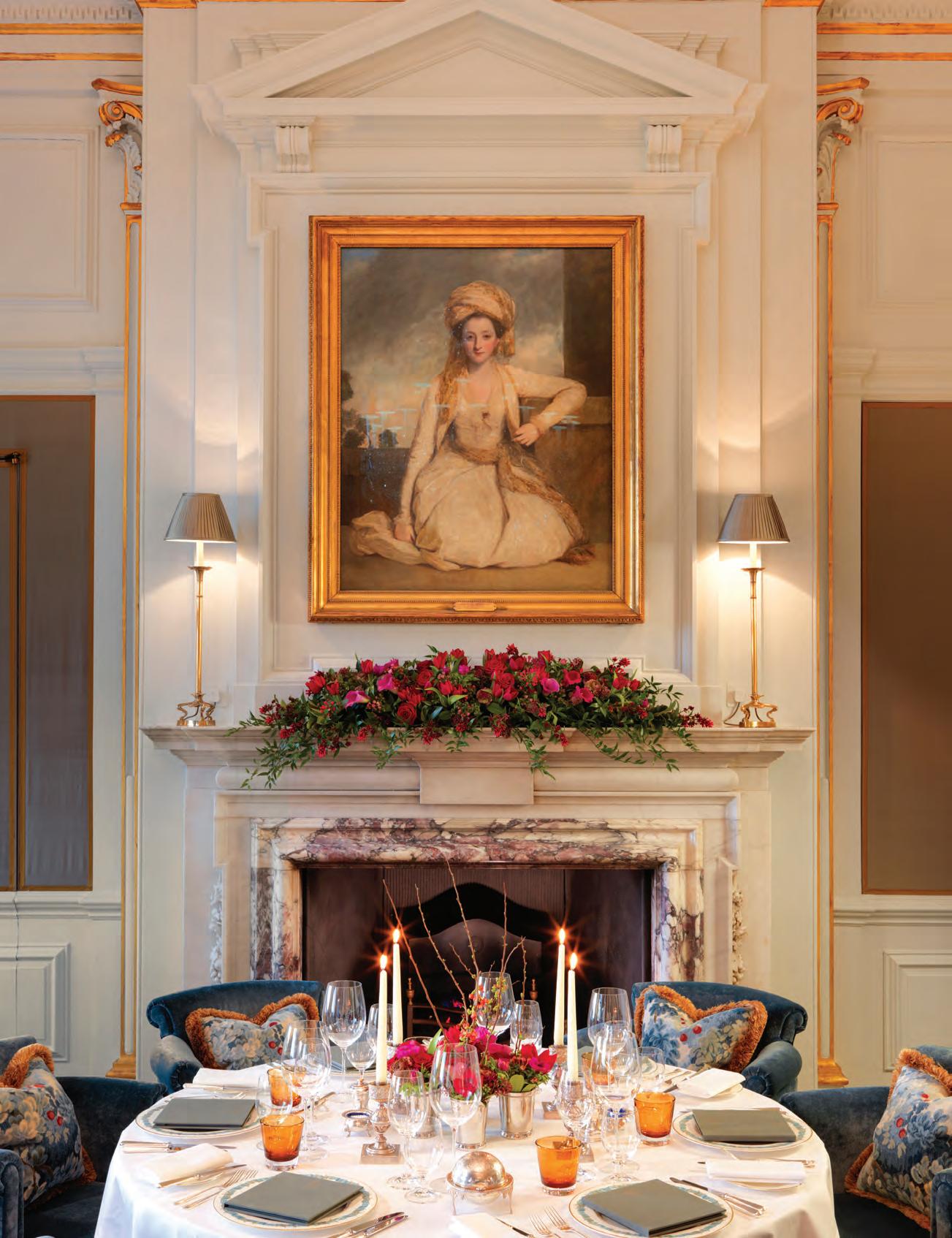
so the pool you saw in the 1989 John Hurt film Scandal, and in the more recent BBC TV drama starring James Norton and Sophie Cookson, isn’t the real thing. It’s a sign of needless prudishness that one suspects would not exist were Cliveden in American ownership now.
The pool itself, lying partially in the shadow of an extravagant clock tower, built from Roman stone and complete with a spiral staircase on the outside, is not a place designed for skinny dipping. There are far too many sun loungers for starters.
They’re occupied by dozing visitors who’ve travelled from everywhere from the States to Shanghai; supine guests who slurp larcenouslypriced Aperol Spritz’s while devouring The Daily Telegraph searching, perhaps, for the latest news on Meghan Markle, that famously media-shy recluse who spent her last night before becoming a Windsor in this hotel.
Cliveden is a slick operation; a place where you’ll find your name on your bedroom door in copperplate script. A place from which a teakdecked ‘Suzy Ann’ launch boat, built in 1911 and piled high with Laurent-Perrier, will take you for a soporific chug down Jerome’s sweetest stretch of the River Thames.
My room was, admittedly, a tad on the diminutive side. The bed, however, was comfy and the spread of fruit, chocolates, mixed nuts and tubsized shampoos and conditioners made a valiant attempt to compensate for the proportions of my temporary abode.
Chris Hannon currently presides over the Cliveden stoves and his cooking, served in a sumptuously formal dining room, is a model of exactly what you would want once you’ve checked in. Although there are vegan and vegetarian menus, once you’re in a Cliveden mindset what you want is truffle risotto, fresh asparagus and saddles of lamb. Hannon delivers with adept craftsmanship; the halibut in particular, served grilled with octopus, capers and lemons, was a pulchritudinous slab of pure piscine pleasure.
There are almost 400 acres of ground to explore around the house itself. Though, despite the National Trust’s squeamish attitude towards the whole Profumo thing, it’s back to that, now Grade I-listed pool (the only outdoor pool in Britain to attain such status) that most guests head, regardless of the weather.
It was Nancy Astor’s son, Bill, who built the swimming spot that would change British society so profoundly in the 1960s. He only managed to construct it once the house was bequeathed to him, and after his horse had won the Epsom Oaks, in 1953. His mother, acerbic to the end, was never in favour of what she considered to be such a tawdry addition to her home.
Demonstrating that vast sums of American money doesn’t always come at the cost of good judgement, Nancy would tell her son, ‘No, no, I think it’s disgusting…. I just don’t trust people in pools’.
Rooms from £445, Cliveden House, Taplow, Berkshire, SL6, clivedenhouse.co.uk
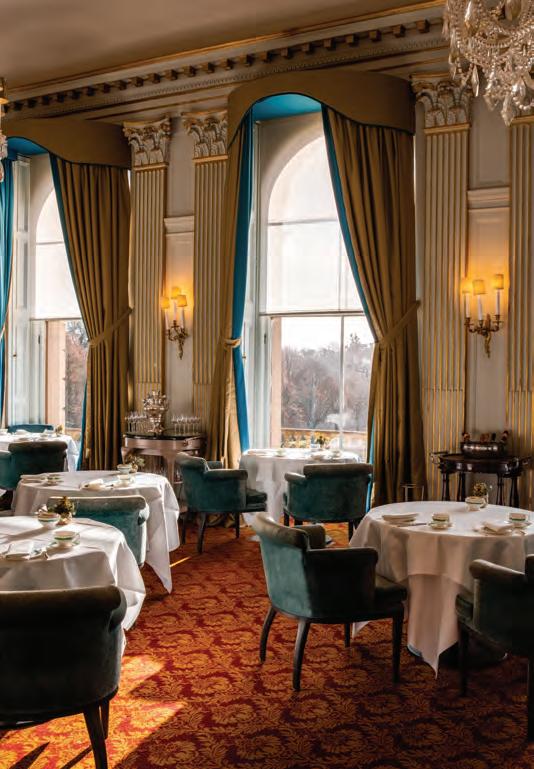
21 LUXURY LONDON THE BRIEFING LUXURYLONDON.CO.UK
Cliveden is a slick operation; a place where you’ll find your name on your bedroom door in copperplate script
03
THE
RESTAURANT
The Hind’s Head
TWO DECADES AFTER IT OPENED, HESTON BLUMENTHAL’S VILLAGE PUB REMAINS THE TRUEST MANIFESTATION OF THE MAN BEHIND THE MEAT FRUIT
Words: Rob Crossan
Time was when the trajectory of the English rock-star involved hitting a middle-aged junction with two, simply-navigated options. With your spandex trousers, worryingly-younger wife and perm-friendly blowdryer in tow, you could either head to a tax haven in the South of France or, if the 98 per cent income tax burden of the Harold Wilson years didn’t concern your accountant, you moved to a leafy, riverside neighbourhood just beyond Slough. To Ascot, Bray, Esher or Henley-on-Thames. You became a ‘country gentleman’, wearing fisherman’s jumpers to the local pub and recording albums in your lavish home studio that were of ever-decreasing relevance to the general public.
Creatively-pungent urban-blight surrenderers to have relocated to this near-corner of the Home Counties in order to gain paunches and endure expensive divorces have included most members of The Who, George Harrison and Eric Clapton. That this bucolic stretch of England is only half-an-hour’s drive from the drug dealers of Hounslow is, we can only speculate, pure coincidence.
Chefs, when they hit middle age, don’t tend to retire to the country as readily. Most top cooks prefer to stay in the capital until they drop their last spatula. If you’re the hottest young thing behind the stove, then a middle-aged move to a gastropub in Berkshire would almost certainly be met with raised eyebrows rather than the mild pity that’s bestowed upon washed-up bass guitarists.
Heston Blumenthal had his own methods for dealing with this conundrum. He simply never became particularly wedded to the capital in the first place, buying a country pub in Bray, Berkshire, when he was in his mid-30s. The Hind’s Head sits next door to The Fat Duck, a restaurant whose influence and repute need no culinary mansplaining here.
You don’t hear nearly so much of Heston these days. Now 57, his days of being the awkward-looking mainstay of Channel Four reality shows – the nation dribbling and bickering over his snail porridge, bacon-and-egg ice cream and aerated beetroot –feels rather cosy compared to the current restaurant climate of utility bill-prompted bankruptcies and the insidious growth of corporate ‘box parks’ masquerading as grassroots gastronomic ventures.
Blumenthal has owned the pub-grub-friendly The Hind’s Head for almost as long as he’s been in the public eye. And it’s this concomitant to the spectacular success of The Fat Duck that reveals the two most axiomatic, but least mentioned, motifs of the man behind the meat fruit.
Firstly, that, far from being the ‘Nutty Professor’ of gastronomy, Blumenthal has always been, at heart, a middle-aged traditionalist. Blumenthal is second only to Nigel Slater in his adoration for food’s ability to emit potent nostalgia for our childhoods, real or imagined. He may use gels and liquid nitrogen at The Fat Duck, but the DNA of his dishes is always somewhere between a 1970s Berni Inn and what your nan would cook up in the kitchen of her pebble-dashed bungalow.
The second is that Blumenthal is a child of Lyon rather than a scion from some culinary divinity from outer space. No other place on earth commits itself with more élan to turbo-charging the flavours of the bouchons of that French city than the kitchens
Far from being the ‘Nutty Professor’ of gastronomy, Blumenthal has always been, at heart, a middle-aged traditionalist


of Blumenthal; from their bacon, crouton and poached egg-smothered Lyonnaise salads, to their foies de volaille in béchamel sauce.
Blumenthal is the Anglicised lovechild of a bouchon veteran and a Lancashire grandmother; and it’s these core values, rather than all that noughties-era molecular gastronomy, that holds sway at The Hind’s Head.
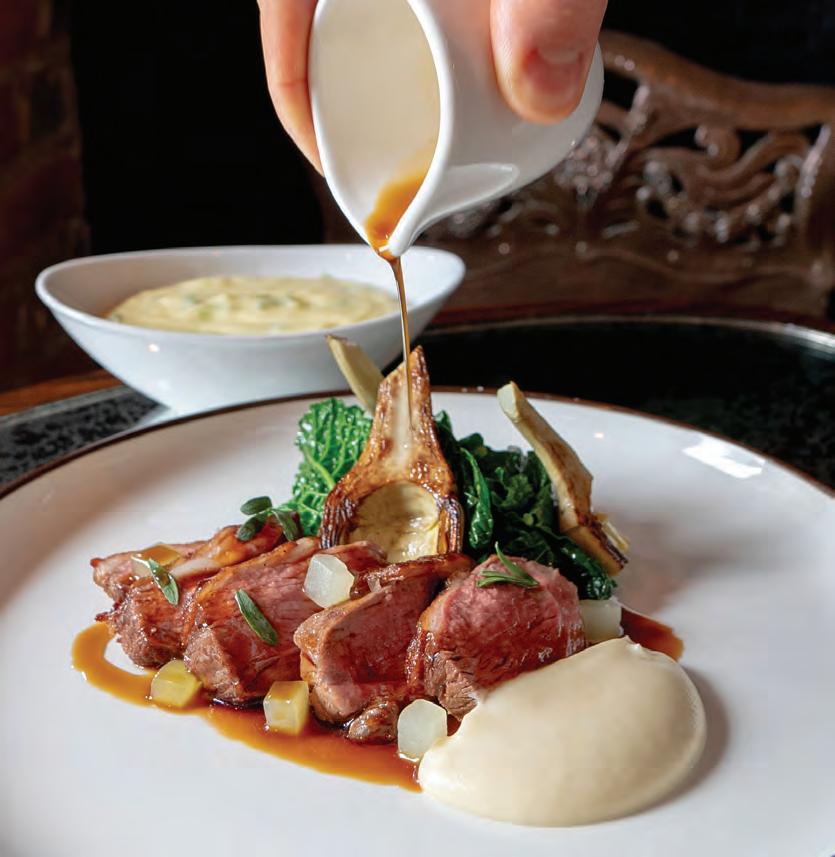
An Elizabethan coaching inn, upstairs the pub is a foppish milieu of antler chandeliers and Decoish curved sofas. Downstairs is better, with panelled wood the colour of boarding-school gravy and a wonky, central bar that serves real ales.
Heston has tried, and pretty much succeeded, at making this space look more boozer than gastropub (the world’s most annoying portmanteau until ‘labradoodle’ came along). The dishes themselves, without exception, avert the need for mad, scientific gambols thanks to an old-fashion commitment to raising the flavour-ometer to breaking point.
The ham hock croquettes had a blistered, glassbreaking snap-and-crackle to them that almost entirely removed the need for the accompanying sauce gribiche. The mushroom parfait on grilled campaillou bread (the crustiest, most rustic loaf that France can offer) was a mousse bolder than a Just Stop Oil protester, yet with a rather more
pleasing fervency on the tongue.
A main of spring tart was unimpeachably good, a perky gathering, rather than a fussy mélange, of asparagus royale, pickled lemon, wild garlic and peas that burst in my mouth like endless, congratulatory flashbulbs.
The Merrifield duck breast came in two railway sleeper-sized, perfectly rare slabs, with grilled asparagus, wild garlic and a green coffee pulp that made for a fabulous dipping sauce for the triplecooked chips. These crunched like a Range Rover over gravel but had a plump and fluffy filling so soft that I feel hotels should start filling their mattresses with them.
If The Hind’s Head is a manifestation of Blumenthal growing more comfortable with the bricolage of middle age then the Government should start paying us all to visit as part of a National Standards of Ageing Well campaign.
Ironically, in the midst of the hanging baskets and biscuit-tin folderol of Bray, Heston’s apothegm of a pub menu is, in probably the most quintessentially middle-aged village in England, giving us the most exciting lesson in how to grow old flavourfully.
The Hinds Head, High Street, Bray, SL6, hindsheadbray.com
25 LUXURYLONDON.CO.UK
An Elizabethan coaching inn, upstairs the pub is a foppish milieu of antler chandeliers and Deco-ish curved sofas
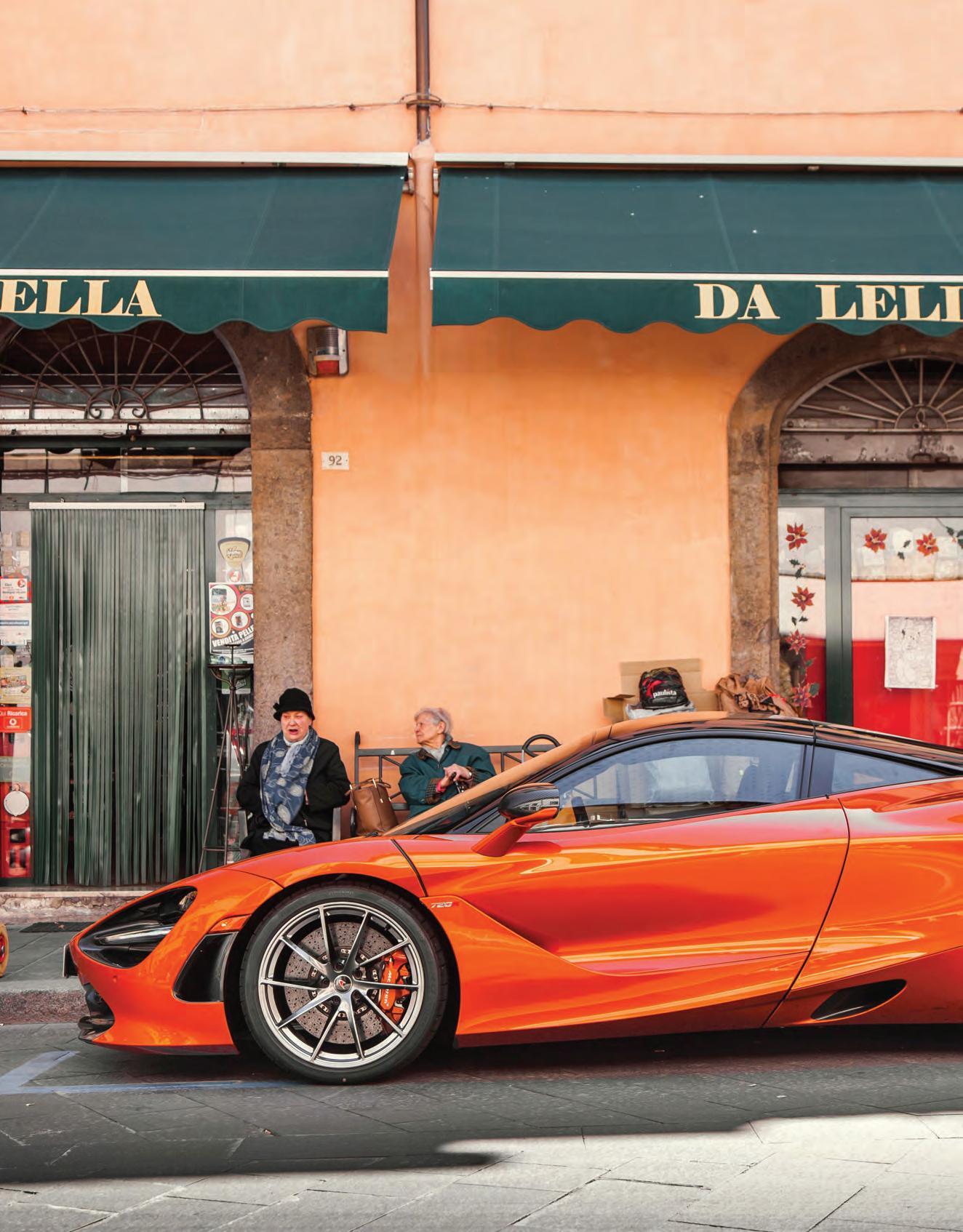
04
THE CAR
McLaren 720S
AS THE 720S BOWS OUT OF PRODUCTION, A REMINDER OF JUST HOW GOOD THE FERRARI-BEATER REALLY WAS
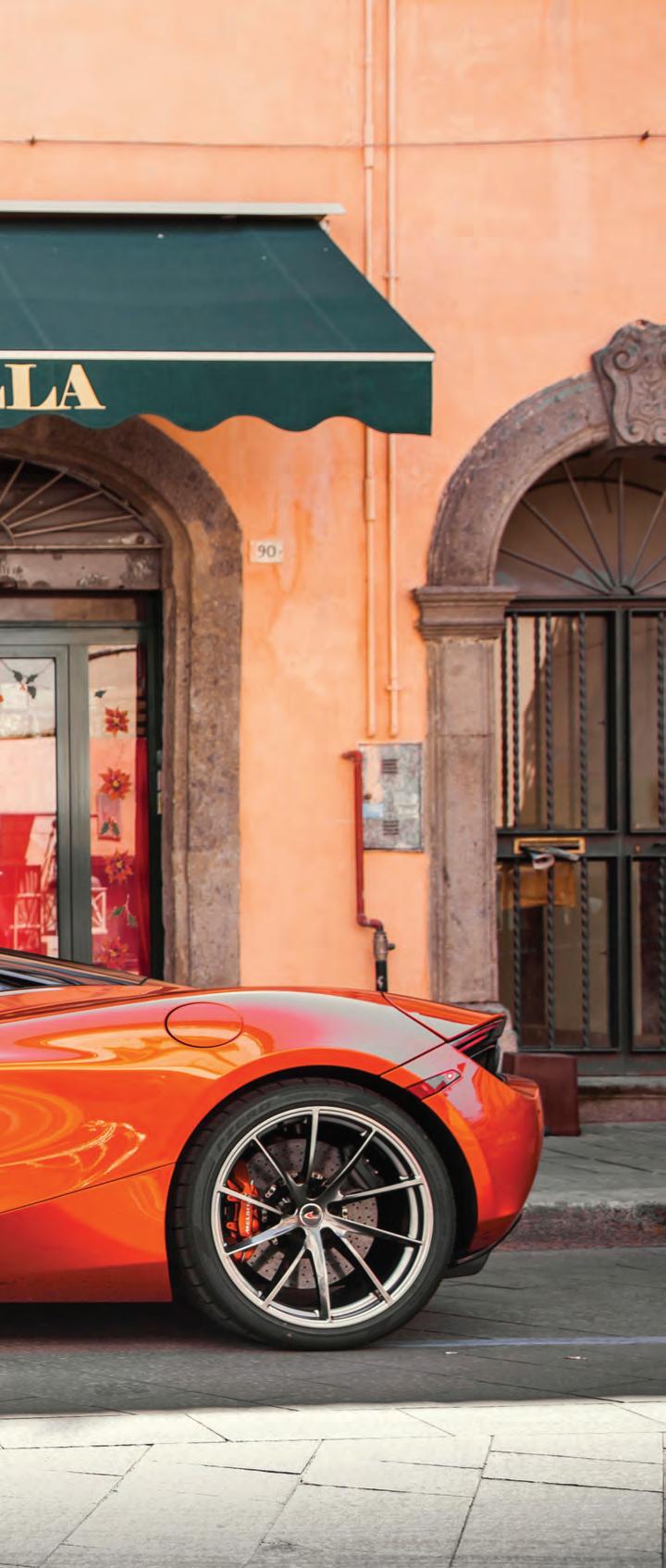

Words: Richard Brown
Sandwiches. Egg-and-watercress and cucumberand-cheese, if memory serves. Plus, some vol-au-vents, a selection of mini quiches and a smattering of those tiny pizza things. Here’s the situation: you’ve parked down the road, beyond sight and, just as importantly, out of earshot. You’d hate to draw attention from the little man. It’s his big day, after all. But now the post-head-wetting revelries have reached their natural conclusion and, as a parting gift, your mate’s mum insists you take home a platter of savoury leftovers.
You’ve been super complimentary all afternoon. It was, in fairness, a top-notch spread. You’ll look insincere if you don’t now accept the fast atrophying smörgåsbord. So, you say your goodbyes and take receipt of the withering pastry turrets. You’ll work out where, exactly, you store a plastic salver of finger food in a two-seat supercar when you get back to the motor.
Granted, it’s not the sort of hypothetical most supercar buyers will workshop when mulling over their next splurge. But, well, the best-laid schemes of men and motors gang aft a-gley. Or something. As it turns out, the cabin beneath the bonnet of McLaren’s 720S can handle a larger-sized serving plate just fine.
The 720S was important, let’s remember. The most important car in McLaren’s modern history, perhaps. It dropped in 2018, a replacement to the outgoing, much-loved 650S. Some carbon-
LUXURY LONDON THE BRIEFING LUXURYLONDON.CO.UK
fibre wizardry meant that the car weighed just 1,419kg. It was basically a cloud. That meant it was also fast. Faster than the Ferrari 488 GTB. Faster than the Lamborghini Huracán. Yikes. Figures, for what they’re worth. Nought to 62 mph in 2.9 seconds. Nought to 124 mph in 7.8 seconds. The 720S will top out at 212 mph. Electrically-aided hyper-cars aside, only the Bugatti Chiron Super Sport (2.4 seconds) and Koenigsegg Jesko (2.6 seconds) are quicker. But those are cars designed for the UAE. They cost £2.7 million and £2.3 million, respectively. The McLaren will go toeto-toe for a tenth of the price.
The 720S is a physical thing, but not in a cage fighter sort of way. The 488 GTB is a supermodel with a coke habit. The Huracán has served a five-year stretch for GBH. Sleek, poised, stealthy, the 720S has a black belt in Krav Maga. It doesn’t need to trash talk in the lead up to the scrap. It’ll stalk you in the shadows and drop you with a single finger. Mine was dark grey, which only added to the 9th Dan vibe.
The McLaren is not as unhinged-looking as a Lambo. It doesn’t make you gawp like a Ferrari. The 720S is suggestive curves and what might be. The quiet one in the corner. Don’t push me. It

looks fast standing still, like a 100-metre sprinter. I got taken up in a fighter jet once. That looked fast too (it was; I blacked out). You can tell the McLaren is going to have a similar kick. It’s the bucket seats. And the near-horizontal driving position.
To drivers of A3s and A-Classes on the A13, the McLaren is an invitation. Let’s dance, they say, revving, braking, barking. Bark back and they smile. Anyone over 40 doesn’t give you an inch. You’re the one in a supercar, mate, you move. There are, I assume, far more stressful situations than reversing a £230k supercar out of a backed-up station car park. But, when it’s raining, it’s rush hour, and that car is wider than the Ever Given, it’s up there. Right up there.
On the open road the torque is staggering. Up to 770Nm of the stuff. In traffic the 720S is an Akita on a leash. Only keener. The car’s successor, the Artura, is a hybrid. It’s newer, a smidgen quicker, cheaper. It’s also heavier, less powerful, less visceral. Is that going forward, or going backward?
Up front Mlaren has stuck a floodlight from Wembley Stadium. It could light up a runway. Inside each headlight are 17 super-bright LEDs; five remain static, the other 12 light up in sequence depending on the direction in
The McLaren is not as unhinged-looking as a Lambo. It doesn’t make you gawp like a Ferrari. The 720S is suggestive curves and what might be
which you’re pointing the nose. The effect is to cast a searchlight that sweeps around corners as you turn the wheel. The faster you go, the further the lights search. It’s some thing.
If you open the dihedral doors after it’s been raining, water will trickle onto the seats. That’s a less good thing. A thing you’d have thought someone would have noticed, and sorted. Same goes for the way the driving seat repositions itself once you’ve turned off the engine. It’s annoying. It would be less annoying if the buttons to readjust the seats weren’t so difficult to reach. Your fingers get mullered.
The driving position is not too low; the windscreen has more glass than the bridge of a Royal Caribbean cruise ship. The ride is firm, but forgiving. No vol-au-vents were hurt in the making of this review. Not even a spill, incredibly.
The 720S mapped the way for modern-day McLaren. But the manufacturer has now stopped making its masterpiece. New for this year were two new colours – Storm Grey and Volcano Yellow. But that’s it. The end of the road. For all its futuristic supersonic-ness, Concorde was an analogue thing, too. British Airways keeps one on the lawn at Heathrow. Perhaps McLaren will park a 720S outside its Technology Centre in Woking.
From £231,220, cars.mclaren.com
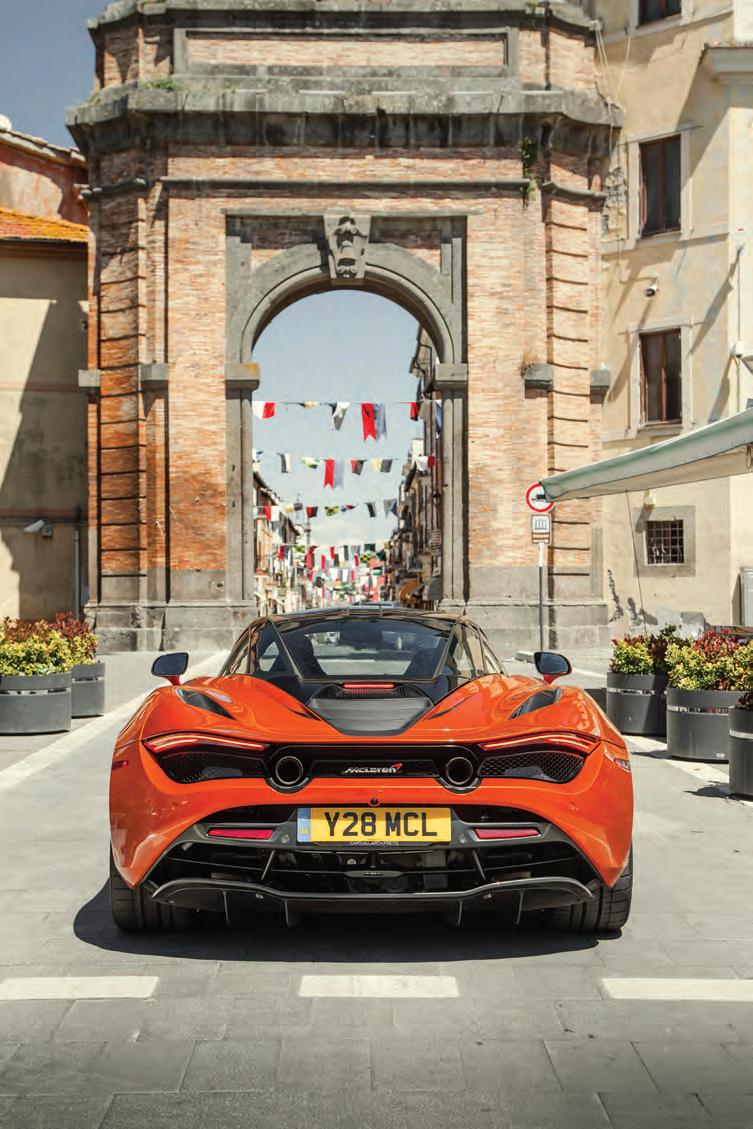
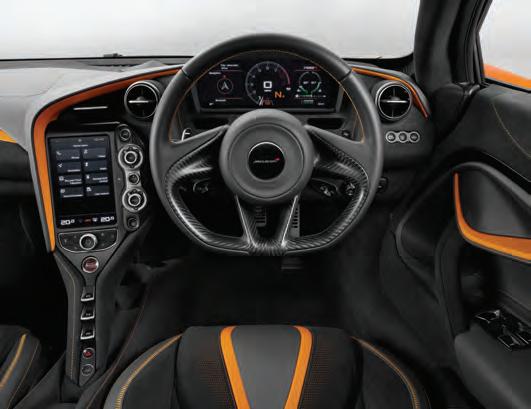
29 LUXURY LONDON THE BRIEFING LUXURYLONDON.CO.UK
ENGINE 4-LITRE V8 0-62MPH 2.9 SECONDS TOP SPEED 212MPH MAX TORQUE 770 NM MAX POWER 710 BHP MCLAREN 720S COUPÉ – THE NUMBERS
05

THE BOOKS

Reading Corner
NEW COFFEE-TABLE TOMES FOR FASHION FANS AND LITERATURE LOVERS



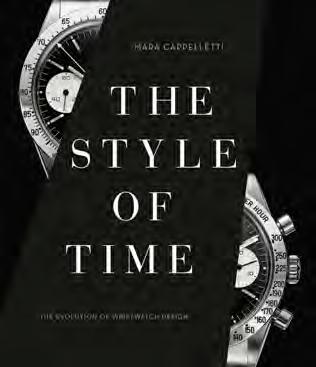

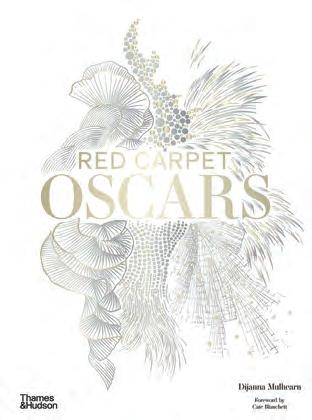

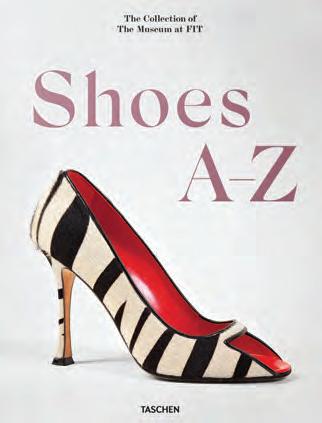
30 LUXURY LONDON THE BRIEFING LUXURYLONDON.CO.UK
Shoes A-Z, The Collection of The Museum at FIT £100, taschen.com
The Fashion Book, £39.95, waterstones.com
Yves Saint Laurent and Art, £32, whsmith.co.uk
Red Carpet Oscars, £50, thamesandhudson.com
The Adidas Archive, The Footwear Collection £100, selfridges.com
The Burberry Book, £150, uk.burberry.com
Dior Raf Simons, £150, farfetch.com
The Style of Time: The Evolution of Wristwatch Design, by Mara Cappelletti, £38.95, amazon.co.uk
DRAGON FLOWER


Anew bone china dinnerware collection handcrafted in Stoke-on-TrentfromBritishdesigner,RichardBrendon.

“WINNERS write the HISTORY and, baby, I WIN”
STANDING IN SOLIDARITY WITH THE SAG-AFTRA STRIKE MAY HAVE FORCED BILLY PORTER TO SELL HIS HOUSE, YET WITH A NEW, HIGHLY-PERSONAL ALBUM ABOUT TO DROP, THE ACTOR-SINGER-PRODUCER-FASHION DESIGNER IS PUTTING HIMSELF OUT THERE LIKE NEVER BEFORE
Words: Adam Davidson Photography: Franz Szony
When Billy Porter released his selftitled R&B album in 1997 he was told that his queerness would be a liability – and, for a long time, it was.
“The doors were slammed in my face,” says the Pittsburgh-born 53-year-old. “The roles were nonexistent and [the opportunity] to be respected as a three-dimensional, rounded human being did not exist for my black queer self. That was hard. My wings were clipped because my queerness was not okay and I was not welcome.”
In response, the American performer, who graduated from Pittsburgh’s Carnegie Mellon University with a BA in Drama before studying screenwriting at UCLA, found other creative mediums through which to express himself –namely, through acting and musical theatre. Having trodden the Broadway boards in Grease, Jesus Christ Superstar and Dreamgirls, in 2013 Porter would win a Tony Award for his portrayal of Lola in Kinky Boots, before winning a Grammy for the same musical the following year.
Now, 26 years after his first studio album, Porter is staging a return to mainstream music and to an industry that, today, purports to embrace his eccentric, no-holds-bar queerness.
“They kicked my black fa***t ass out and now they want me back in,” says Porter, who in July of this year announced he’d split from his husband of six years, Adam Smith. “There were some people in
the mainstream record industry that remembered me and said, ‘Be that queer thing you were trying to be in the ’90s – we can do that now.’ Well, I’m back on my own terms – and it is magical.”
Just as the music industry has changed, so too has Porter. The rhythm-and-blues Broadway sound of his first three solo albums – Billy Porter (1997), At the Corner of Broadway + Soul (2005), Billy’s Back on Broadway (2014) – has been replaced by dance and disco anthems; a genre with added significance for Porter, who came out aged 16 in the midst of the AIDS crisis; a time when clubs and discos provided a safe space for the queer community.
“We went straight to the frontlines to fight for our lives,” says Porter. “The place where we felt seen and heard, where we found fellowship, was in the clubs.” It is his experience of disco in the ’80s that provided the inspiration behind Porter’s upcoming fourth solo album Black Mona Lisa, which is slated to be released in January 2024.
“Back then, we went to the clubs on the weekends and we recharged so that we could go back out into the world and fight. I wanted to honour my people. I wanted to honour my journey, what saved me and what helped me heal. It was very healing to go to these spaces.”
Refreshingly outspoken about his experiences as an LGBT+ actor and musician, Porter has never been one to hide his queerness, putting it front and centre in headline-grabbing red-carpet looks –
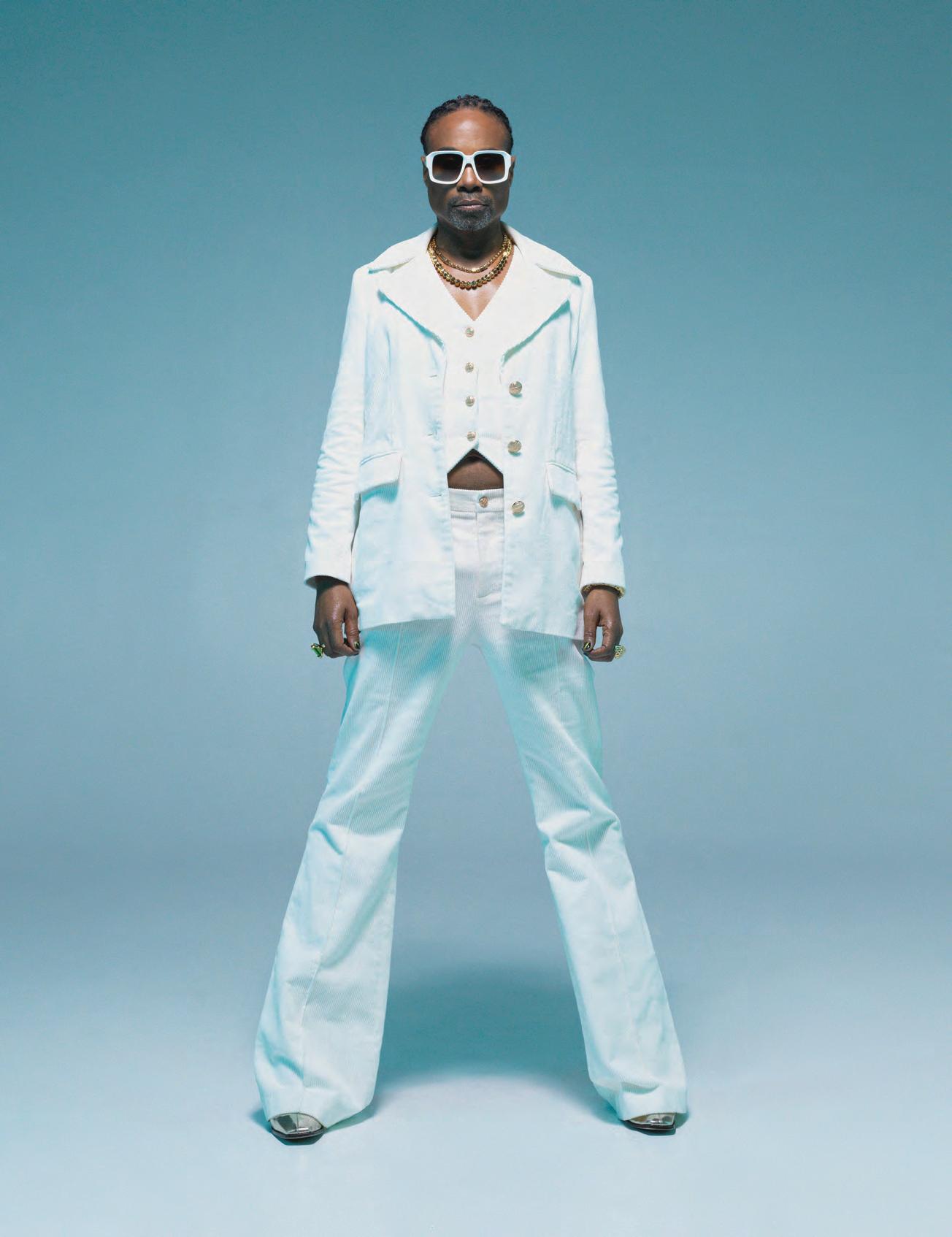

many of which he designed himself – that have paved the way for male style icons like Lil Nas X and Donald Glover. It takes, after all, a special kind of fabulous to dress as an Egyptian god and have six topless models carry you into the Met Gala. That was in 2019; the following year Porter was included on Time magazine’s list of the 100 most influential people in the world.
The flip side of being so candid, so outré, is that Porter has been on the receiving end of much of the resurgent backlash to queer art, something in which he sees similarities to the attacks he witnessed in the ’90s. “It’s the same thing as it has always been, vilifying the other and vilifying the thing you don’t understand. It’s the circle of life. History repeats itself and those who don’t know their history are doomed to repeat it.”
That vitriol, says Porter, the first openly gay black man to win a lead acting award at the Emmys (for Pose in 2019), is different this time around because the “change has already happened”.
“You can’t put the toothpaste back in the tube. In 1997, I was not possible, and despite everything that’s going on right now and all the pushback, I’m possible and I’m here. Winners write the history and, baby, I win. I’m here and I’m not going anywhere.”
Porter’s most recent musical output, the earwormy dance anthems Broke a Sweat and Baby Was a Dancer, are songs intended to be performed live. They are, says Porter, songs that truly represent who he is now as a performer and artist. The upcoming album, and his comeback in general, is also about joining artists like Beyoncé in putting dance music – which Porter believes has been relegated and dismissed for decades – back on the map.
“I want to be part of honouring the genre and putting it back into the zeitgeist in the way that it should be respected and honoured and enjoyed. The music is healing; the music is celebratory; the music is really powerful.”
Porter describes Black Mona Lisa as “the greatest musical account of my artistry and my creativity”. “It’s all the things I am. It’s all of the influences. The music shapeshifts – it’s all different genres and it’s all different styles. The defining factor is me. I’ve lived all of these things so I can talk about all of them from a place of experience. Having really experienced life and continuing to experience life and being able to talk about that is magical.”
It isn’t just the music industry that has become almost unrecognisable since Porter last released a mainstream album. The very nature of celebrity has changed dramatically; largely thanks to the poison chalice that is an always-online fanbase, and its attendant social media following. While Porter
recognises the opportunity and importance of social media for an artist – he has amassed a following of more than 2.2 million on Instagram – he describes such online platforms as the “Wild West”.
“It’s not my favourite thing because we don’t really know what it is,” he explains. “I feel like we’ve given a little bit too much power to the algorithm. If I hear that word one more time… I’m not a f**king algorithm! The labels and the artists have given a bit of our power away to this entity that means nothing and everything at the same time.”
For many, Porter will be best known for his roles in hit TV shows Pose and American Horror Story , but television is the one part of his career that today he is reticent to speak about. Like thousands of other actors in the States, Porter is currently on strike as part of the ongoing SAGAFTRA industrial action, which has seen that union ask its actors to refrain from taking part in any sort of promotional exercises.
Since July 2023, actors belonging to the union (the Screen Actors Guild and American Federation of Television and Radio Artists) have been striking for better wages, working conditions and protection from the use of artificial intelligence. Their walkout has coincided with industrial action taken by the WGA (Writers Guild of America). It is the first time that both actors and writers have gone on strike simultaneously since 1960.
It is unclear what effect these strikes will have on the industry in the long term but, as of the date of publishing, neither side is backing down – and Porter is characteristically candid about his reasons for supporting the walkout.
“Bob Iger [the Chief Executive Officer of The Walt Disney Company] flies his private plane to a billionaire’s retreat, gets on television and says that our demands for a fair wage are unrealistic. He makes $78,000 a day and my residual check says six cents. F**k you! I’ve had to sell my house because I don’t know where my next paycheck is coming from. I am one award away from an EGOT [the achievement of having won all four of the major American entertainment awards – an Emmy, a Grammy, an Oscar and a Tony] and I still live cheque to cheque. I haven’t made any money yet because they don’t pay me residuals.
“I hope this strike reminds these executives, who run studios without a creative bone in their body, that they can’t do this without us. You can’t do a thing without us and you treat us like we don’t matter.
“Well, let me tell you, we do.”
Black Mona Lisa will be released in January 2024 via Island/Republic
35 LUXURY LONDON INTERVIEW LUXURYLONDON.CO.UK
“I feel like we’ve given a little bit too much power to the algorithm. If I hear that word one more time… I’m not a f**king algorithm!”
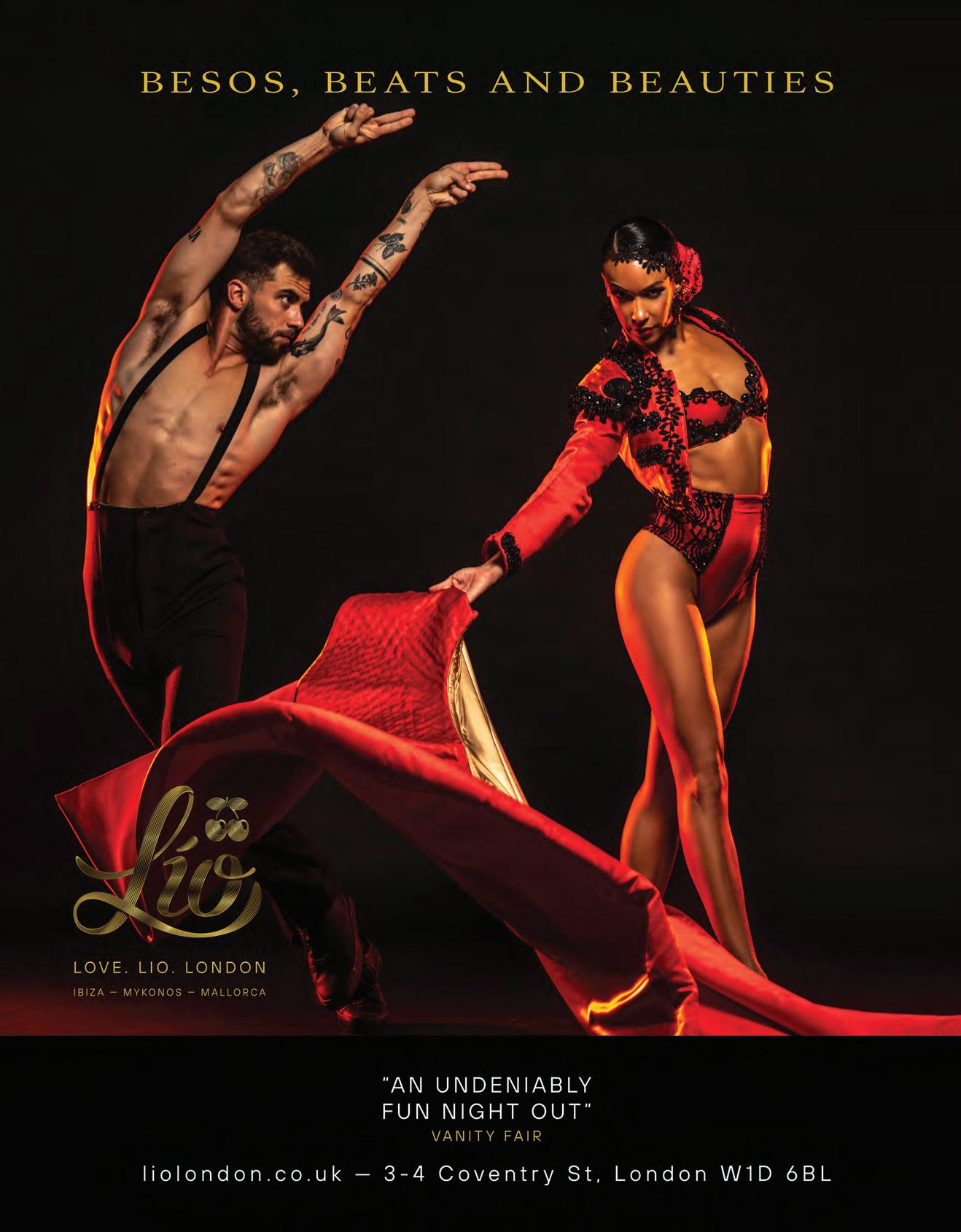
AND MASTERPIECES


38 Agenda Your curated guide to culture in the capital 44 Once Were Kings What to expect from the latest exhibition from The Connor Brothers 48 From Hero to Villain How the United States turned its back on J. Robert Oppenheimer
MUSEUMS
Culture
MUSIC,
This autumn, discover some of David Hockeny’s most intimate portraits at the National Gallery, p.40
The Agenda
YOUR CURATED GUIDE TO CULTURE IN THE CAPITAL
Edited by: Anna Solomon
DAVID HOCKNEY: DRAWING FROM LIFE
NATIONAL PORTRAIT GALLERY
2 NOVEMBER 2023 –21 JANUARY 2024
This exhibition ran for just 20 days before the National Gallery’s closure in March 2020. Now, rediscover Hockney’s intimate portraits of 30-plus sitters in his Normandy studio, including his mother, Harry Styles and the artist himself. It is a format that reflects the simplicity of Hockney’s style, and therein lies its charm.

£21 (free for members), npg.org.uk
PHILIP GUSTON
TATE MODERN
5 OCTOBER 2023 – 25 FEBRUARY 2024
Guston’s work depicts the turbulent world that he observed around him – including the racism of 1950s America. Hooded figures are grotesque manifestations of the Ku Klux Klan; in fact, a major retrospective of the artist was postponed in the wake of George Floyd’s death due to the potential for the work to be ‘misinterpreted’. The images have now reached London; see them for yourself from October.
£20 (free for members), tate.org.uk

CELIA, CARENNAC, AUGUST 1971, BY DAVID HOCKNEY, COLORED PENCIL ON PAPER © DAVID HOCKNEY, PHOTO CREDIT: RICHARD SCHMIDT, COLLECTION THE DAVID HOCKNEY FOUNDATION
PHILIP GUSTON, THE RETURN, 1956-8. TATE. © THE ESTATE OF PHILIP GUSTON, COURTESY OF HAUSER & WIRTH
LONDON FASHION WEEK VARIOUS LOCATIONS 15-19
SEPTEMBER
Once again, the global fashion elite are descending on the capital for five days of shows, events and general spectacle. The SS24 showcase opens on Friday 15 with the likes of Di Petsa, Huishan Zhang and Ahluwalia; we’re also looking forward to presentations from Molly Goddard and S.S. Daley, while Halpern and Knwls are returning to the lineup after a hiatus. It’s set to be an electrifying extravaganza.
londonfashionweek.co.uk

REJINA PYO PF23 COLLECTION
DULWICH PICTURE
GALLERY
27 SEPTEMBER 2023 –28 JANUARY 2024
The term ‘Rubenesque’ has come to describe a voluptuous female body – yet there has never been a dedicated study
of the Flemish artist’s presentation of women, making this exhibition a first. The showcase will unite more than 40 paintings from Rubens’ career, along with archive material, seeking to disrupt the idea that he depicted women in a homogenous way. Rather, it will provide a more nuanced view of the women, both real and imagined, in his world.
£15, dulwichpicturegallery.org.uk

WOMEN
RUBENS &
PETER PAUL RUBENS, DIANA RETURNING FROM THE HUNT, CIRCA 1615
DIVA

V&A UNTIL 7 APRIL 2024
From 19th century singer Jenny Lind to Elton John and Amy Winehouse, this exhibition explores what it means to be a diva, and how the term has been refined and reclaimed over time and across media.
£20, vam.ac.uk
VANYA
DUKE OF YORK’S THEATRE UNTIL 21 OCTOBER
This autumn, Andrew Scott (of Sherlock and Fleabag fame) will bring multiple characters to life in Simon Stephens’ reimagining of Uncle Vanya. Anton Chekhov’s tragicomedy traces the entanglements of a group united by familial and romantic ties, and brought together by a rural estate (and its owner’s decision to sell it). Although Stephens’ adaption has been described as ‘radical’, original themes of hope, regret and a kaleidoscope of human emotions remain a constant.
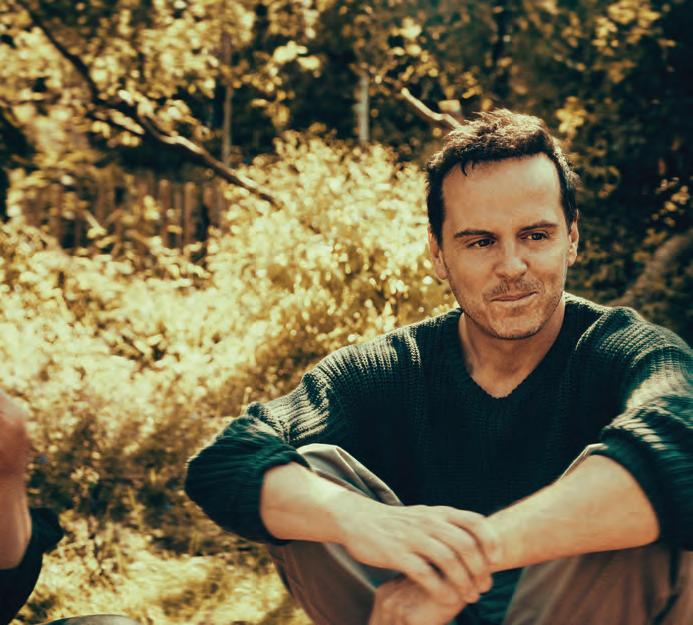
From £80, thedukeofyorks.com
HAMNET
GARRICK THEATRE 30 SEPTEMBER 2023 –6 JANUARY 2024
The stage adaption of Maggie O’Farrell’s wildly popular novel – which traces William Shakespeare and Agnes Hathaway’s story of love and loss – is landing in London.
From £30, rsc.org.uk

41 LUXURY LONDON CULTURE LUXURYLONDON.CO.UK
IMAGE BY MANUEL HARLAN
IMAGE BY OLIVER ROSSER, FEAST CREATIVE
TINA TURNER WEARING BOB MACKIE (1980).
PHOTO BY GAI TERRELL, REDFERNS, GETTY IMAGES
RE/SISTERS: A LENS ON GENDER AND ECOLOGY
BARBICAN
5 OCTOBER 2023 –14 JANUARY 2024
This exhibition will examine the relationship between gender and ecology, and make the claim that gender-based oppression and the degradation of the planet are intrinsically linked in a dual global struggle. RE/SISTERS suggests that women’s understanding of the environment has often been anti-capitalist, and shines a light on the women at the forefront of climate activism.
£16, barbican.org.uk
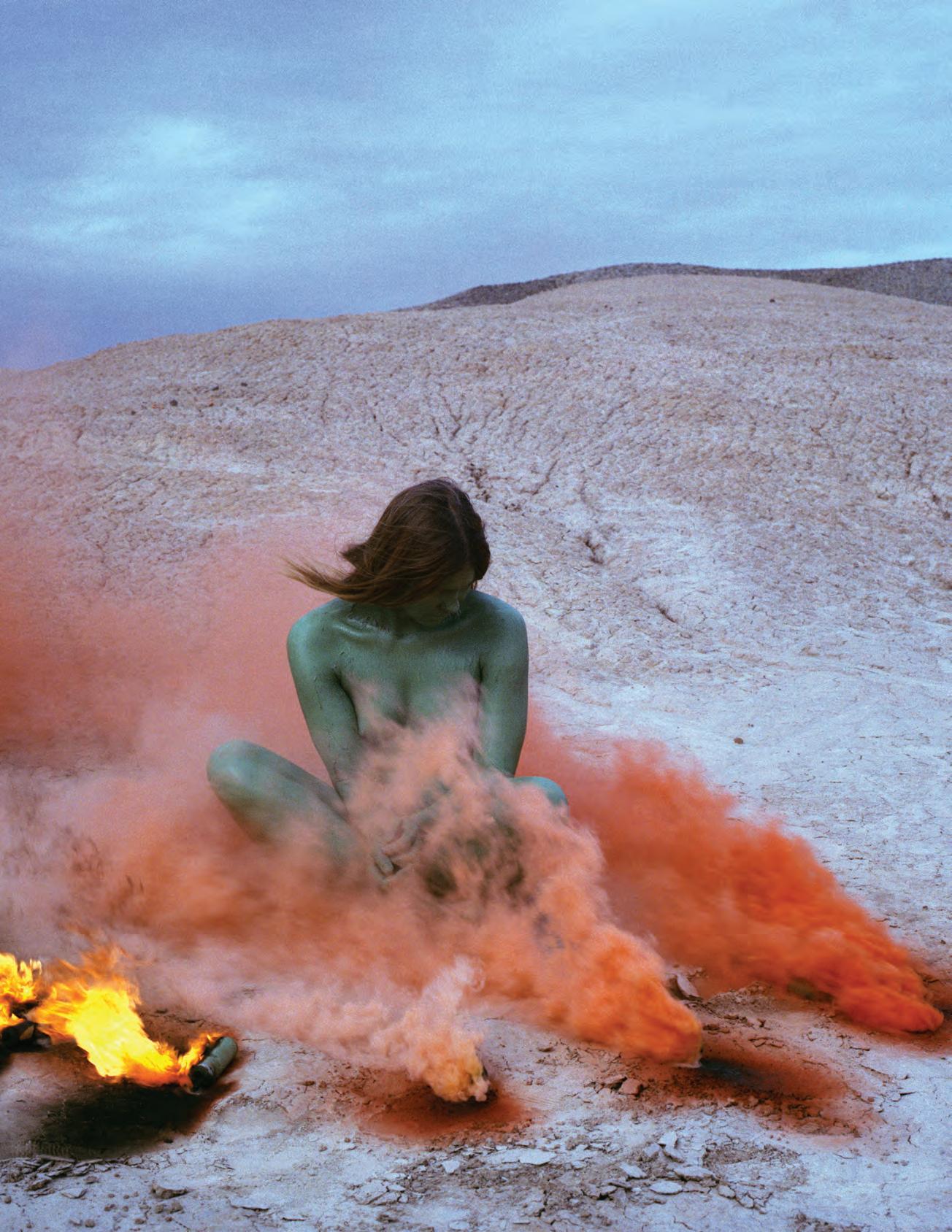 JUDY CHICAGO, IMMOLATION FROM WOMAN AND SMOKE, 1972
JUDY CHICAGO, IMMOLATION FROM WOMAN AND SMOKE, 1972
STYLE & SOCIETY: DRESSING THE GEORGIANS


THE QUEEN’S GALLERY UNTIL 8 OCTOBER
Catch the end of this fascinating exhibition, which immerses audiences in the aesthetics of 18th-century Britain. The showcase delves into the trends and tastes of the Georgians, as evidenced by paintings, prints and drawings by artists such as Gainsborough, Zoffany and Hogarth, as well as luxurious textiles, jewellery and accessories ranging from snuff boxes to swords. It also sheds light on how the Georgians ushered in many of the cultural phenomenons of today, including the first stylists and influencers.
£17, rct.uk
SARAH
TATE BRITAIN
28 SEPTEMBER 2023 –14 JANUARY 2024
Sarah Lucas came up in the late 1980s with fellow YBAs (Young British Artists) Damien Hirst and Tracey Emin; the visual puns implicit in her work, and the provocative exploration of sex, class and gender, quickly made a splash. The Tate Britain exhibition will show Lucas’ work in all of its bawdy diversity, across sculpture installation and photography, all narrated in her own voice.
£17 (free for members), tate.org.uk

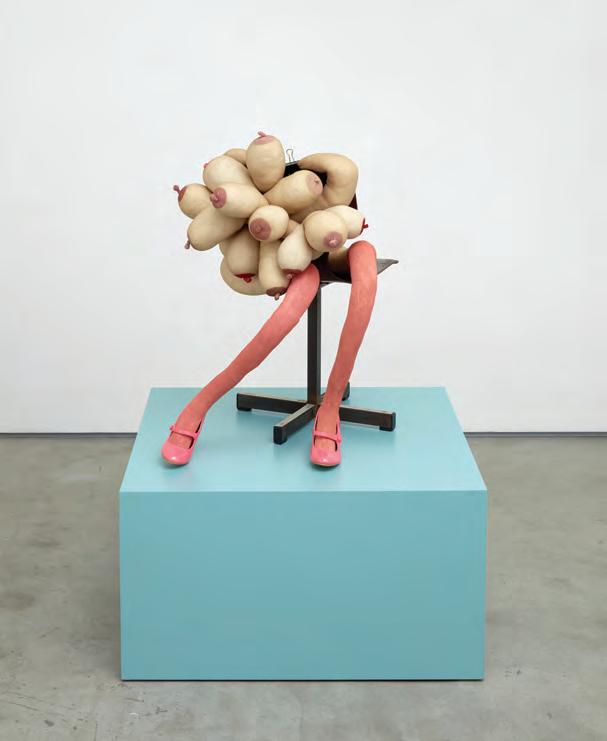
LUXURY LONDON CULTURE
LUCAS: HAPPY GAS
ROYAL COLLECTION TRUST © HIS MAJESTY KING CHARLES III 2023
ABOVE SARAH LUCAS, RED SKY DAH, 2018, COURTESY OF SADIE COLES HQ, LONDON. SARAH LUCAS, EXACTO, 2018. COURTESY OF THE ARTIST AND KURIMANZUTTO, MEXICO CITY / NEW YORK BELOW SARAH LUCAS, SUGAR, 2020. COURTESY OF THE ARTIST AND SADIE COLES HQ, LONDON. ALL © SARAH LUCAS
ON LONDON TIME
Maeve Doyle
THE ARTISTIC DIRECTOR OF MADDOX GALLERY AND BBC RADIO ART CORRESPONDENT EXPLAINS HOW LONDON’S ART SCENE
HAS CHANGED SINCE THE PANDEMIC AND WHY THE CONNOR BROTHERS’ LATEST EXHIBITION IS A MUST FOR YOUR AUTUMN AGENDA
Words: Alexander Mark Jones
Renowned art critic, Maeve Doyle, studied in Vancouver, Canada, before opening Doyle Devere in Notting Hill in 2009. Doyle was head of Mayfair’s Bankrobber Gallery, which, in 2013, arranged the sale of the Banksy murals, Slave Labour and Girl with Balloon In 2017, Maeve joined Maddox, proving to be instrumental to the success of the company, which now operates three galleries in London and another in Gstaad, Switzerland.
A 2014 article in The Telegraph introduced Doyle to The Conner Brothers, a pair of artists who had duped the art world into believing they were American twins who’d been raised in an extreme Christian cult called ‘The Family’ in California. The cult did exist. Musician Christopher Owens, actress Rose McGowan, and both River and Joaquin Phoenix had been raised within it. But The Connor Brothers were actually two Londonbased friends, Mike Snelle and James Golding.
Exploring the notion of truth and fiction, the artists
began selling out shows in London, Los Angeles and Sydney, before setting an auction record at Bonhams in the capital in 2019. The pair are well-known for their extensive charity work, raising considerable funds for the Teenage Cancer Trust and CALM (Campaign Against Living Miserably).
During lockdown, the pair began art therapy, which promotes the practice of automatic drawing, a process where sketches are made from the subconscious, often revealing childhood traumas and current obsessions and neuroses. Out of the process came the Regression series. The first exhibition from that series, Mythomania , which was hosted by Maddox Mayfair in 2022, saw the artists depict mythical creatures in childlike sketches. The follow-up exhibition, Once Were Kings , is being showcased by the gallery this autumn.
Here, Doyle discusses Once Were Kings in context with The Connor Brothers’ earlier work, and talks more generally about the current state of the London art scene at large.

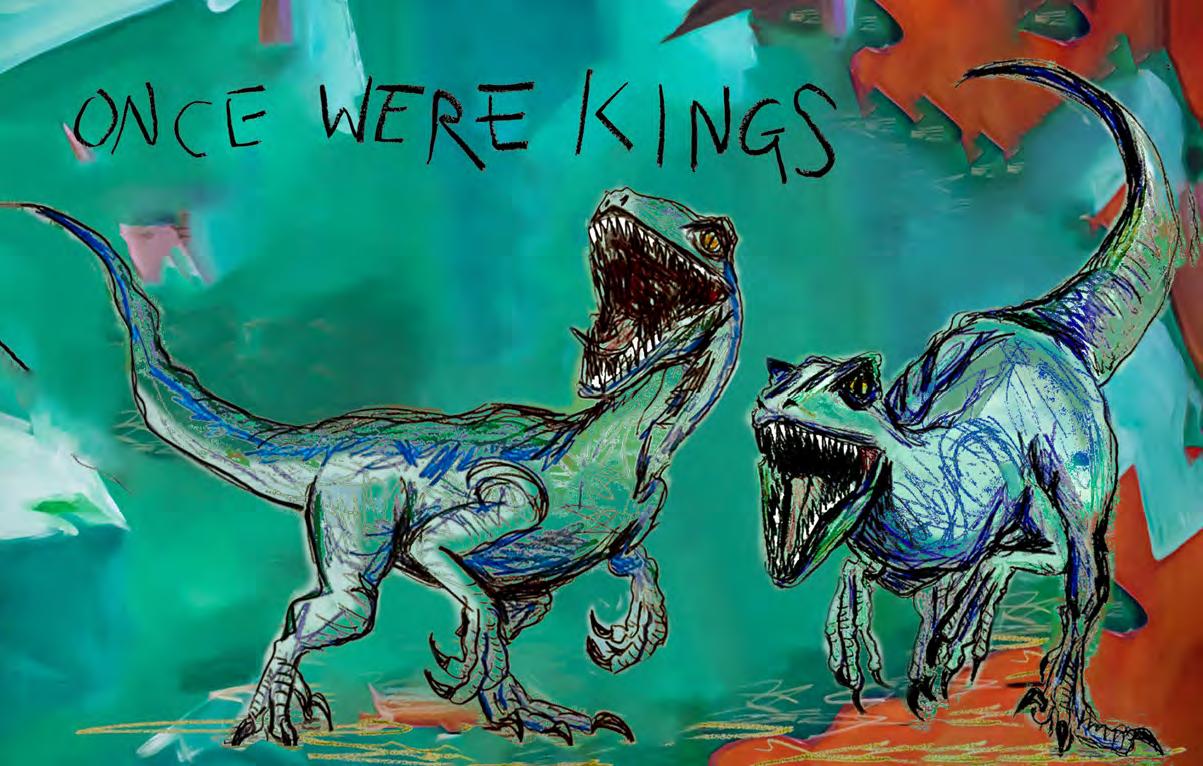

How has the London art scene changed since the pandemic? Culture and the arts had already been developing new directions, but COVID sped up the changes. Maddox had a strong online and social media presence going into the pandemic, which helped the business adapt quickly. Exhibitions went online. The art world had to accept the changes, or simply disappear.
Has the art itself changed? Have you noticed any sort of collective response among artists? Yes, of course. Artists were harvesting ideas from their interior lives. Lockdown made dream journals popular and without external stimulation, a lot of work became quite surreal and the mood a little existential.
The Connor Brothers conceived Mythomania in lockdown, an exhibition featuring drawings and canvases from the Regression series. The body of work grew out of the art therapy sessions that the pair undertook during lockdown. Rendered in a purposefully naïve style, the collection marks a brave departure from their previous controlled graphic approach.
What are the major trends currently driving the London art scene? It’s a bit anti-trend just now. With long-time icons like Jeff Koons struggling to sell like they once did, and a now-defunct frenzy for NFTs, the art world is fundamentally changing. The Royal Academy is having its first solo show in the main space with female artist Marina Abramovic – it has been around for 255 years and it’s the first time it has exhibited a female artist, crazy don’t you think?
You could say that there is a growing awareness to consider diversity in programming, and to rediscover and shine a spotlight on artists who weren’t celebrated in their prime or lifetime because they were ‘othered’, either by race or gender.
When did you first become aware of The Connor Brothers and what initially drew you towards their work? The Connor Brothers are otherwise known as Mike Snelle and James Golding. However, at the beginning of the journey they were known
as fictional characters, Franklyn and Brendan Connor. Their extraordinary yet believable story kept the art world guessing for 18 months before their cover was blown by a major national newspaper. It was this article that really drew me in and made me want to get to know the artists behind the elaborate ruse.
How does Once Were Kings sit in context with the artists’ previous work? Once Were Kings is a development of their Regression series, referring to a time when dinosaurs ruled the earth, and is a cautionary tale reminding us of the factual dilemma that we are inherently responsible. In classic The Connor Brothers style, the use of text adds further layers of complexity and meaning to the paintings, at times humorous and at others unsettling and deeply personal.
Does it help to have a previous knowledge of The Connor Brothers to enjoy the exhibition? It doesn’t help, but you’ve missed out on the serious fun – the way the duo took on the art world. If you weren’t around to experience the ‘Oh My God!’ moment in 2014 when they were outed as James and Mike, or their countless consciousness-raising charity events with Professor Green, Noel Gallagher, Pussy Riot and so on – well get on board, because there’s never a dull or dumb moment where The Connor Brothers are concerned.
Why do you think work by the The Connor Brothers strikes such a chord with contemporary audiences? “It’s an artist’s duty to reflect the times in which we live.” And they do! (That quote, by the way, is by Nina Simone, an American singer songwriter and civil rights activist.)
What is your personal favourite piece by The Connor Brothers? From the new Once Were Kings exhibition, my favourite piece is Crypto
The Connor Brothers’ Once Were Kings is on show from 13 October until 19 November at Maddox Mayfair, 9 Maddox Street, W1S 2QE, maddoxgallery.com
47 LUXURY LONDON CULTURE LUXURYLONDON.CO.UK
“With long-time icons like Jeff Koons struggling to sell like they once did, and a now-defunct frenzy for NFTs, the art world is fundamentally changing”
OPPOSITE TOP ONCE WERE KINGS BY THE CONNOR BROTHERS. COURTESY OF MADDOX GALLERY OPPOSITE BOTTOM RISK TAKERS BY THE CONNOR BROTHERS. COURTESY OF MADDOX GALLERY
‘NOW I AM BECOME DEATH’
Who was the real OPPENHEIMER
?
J. ROBERT OPPENHEIMER SPEARHEADED THE DEVELOPMENT OF THE ATOMIC BOMB BUT FOR SUBSEQUENTLY LOBBYING FOR NUCLEAR DE-ESCALATION, HIS LOYALTY TO THE UNITED STATES WAS QUESTIONED AND HE FACED ACADEMIC EXILE. AS CHRISTOPHER NOLAN’S BIOPIC SETS OUT TO TELL OPPENHEIMER’S STORY, JUST HOW DID THE THEORETICAL PHYSICIST GO FROM NATIONAL HERO TO PUBLIC ENEMY?
Words: Rob Crossan

OPPENHEIMER AT PRINCETON, NEW JERSEY, AFTER THE ANNOUNCEMENT THAT HE WILL BE AWARDED THE LEGION OF HONOUR BY THE FRENCH EMBASSY IN WASHINGTON, D.C, THE HIGHEST CIVILIAN DECORATION THAT FRANCE AWARDS, 4 NOVEMBER 1957
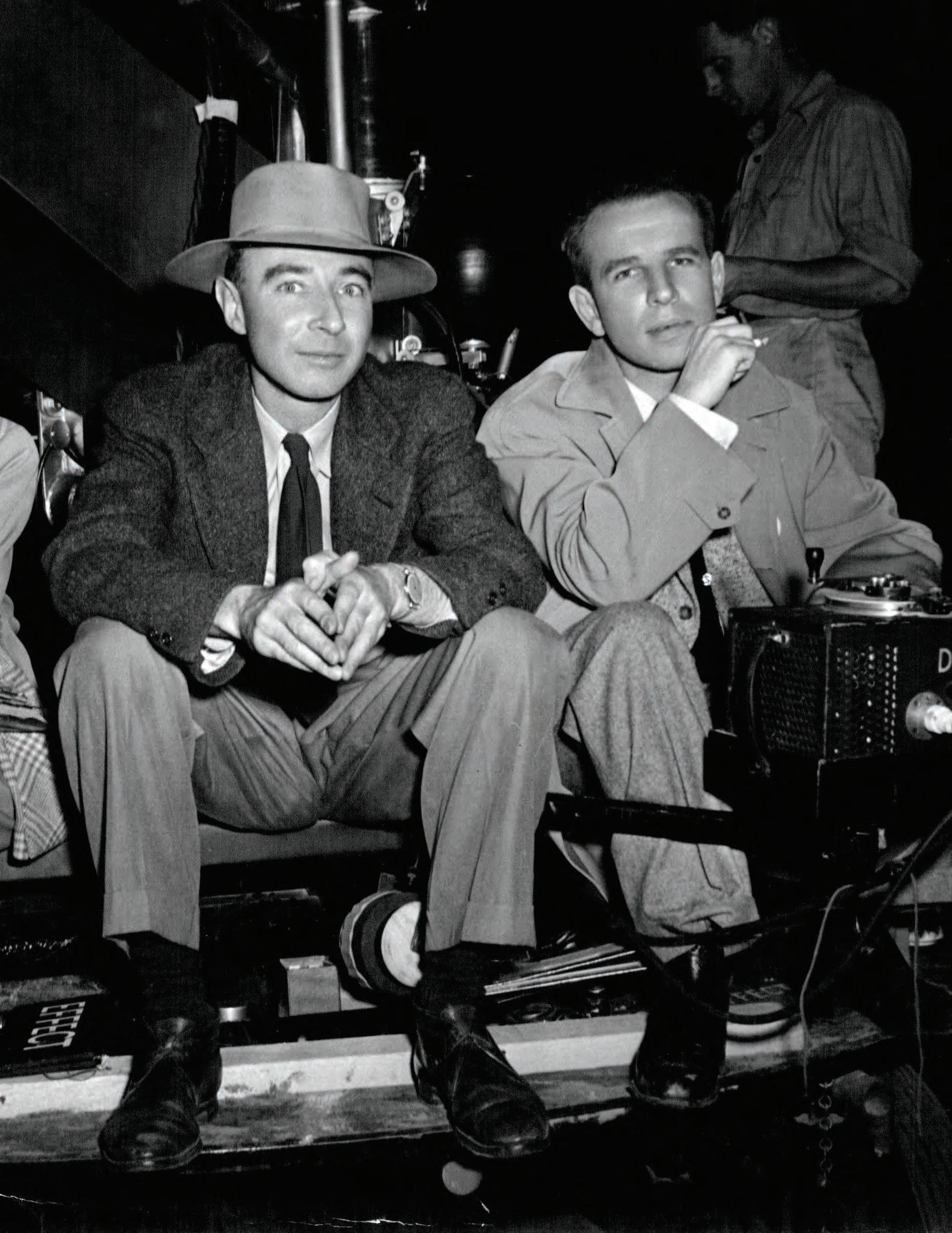
OPPENHEIMER WITH ACTOR HUME CRONYN DURING THE FILMING OF ‘THE BEGINNING OR THE END’, A MOVIE DEPICTING THE STORY OF THE FIRST ATOMIC BOMB, 4 JUNE 1953
The sun is still rising over Gibney Beach, St. John, one of the smaller of the seven US Virgin Islands, as the man, tall, gaunt and looking a lot older than his 60 years, lights yet another cigarette. In front of him, the turquoise Caribbean Sea is calm this morning. Behind him, the only dwelling on this remote, tropical backwater is the small, brittle-looking house that he built himself.
Hungover from a night of fierce cocktails and fiercer arguments with the dinner guests that he and his wife, Kitty, hosted the evening before, J. Robert Oppenheimer walks the short distance to his sailing boat and casts off under a cloudless sky. The locals have heard the screams before. To them, island life is near paradise. To their emaciated neighbour, life seems to be a nightmare from which he struggles to escape.
It’s the mid-1960s and it has been more than a decade since that grim spring of 1954 when, in a temporary building near the Washington Monument in the US capital, Oppenheimer had been subjected to four weeks of interrogation to determine whether, despite spearheading the project that led to the creation of the first atomic bomb, he was in fact a Soviet spy.
The recently-released Oppenheimer movie, directed by Christopher Nolan and starring Cillian Murphy, Florence Pugh, Matt Damon and Robert Downey Junior, helps restore the reputation of a man who is considered by modern consensus to have been scrutinised, shamed and left to rot by the US Government during the post-war years.
Yet even while Oppenheimer was alive, there were attempts to welcome him back to the scientific community, efforts led by those who believed he could never have been an agent of the USSR – endeavours that were rebuffed by politically-motivated opponents and paranoid intelligence officers.
Oppenheimer was born in New York City in 1904, his father, Julius, having emigrated from what was then Prussia in 1888. Despite arriving in the States with no qualifications and unable to speak English, Julius would make a small fortune importing textiles. Both his sons, Frank and the older Robert, would train as physicists; the brasher, more eccentric Robert emerging as a prodigy who would study at Harvard, Cambridge and Berkeley. By the start of the Second World War, Oppenheimer was working as a physics professor at the University of California.
It was in 1942 that Oppenheimer was approached by the US Government to lead the Manhattan Project, a confidential team of scientists whose mission was to develop an atomic bomb. A witness to the very first test, carried out near the Los Alamos laboratory in New Mexico in July 1945, Oppenheimer would
later remark that the explosion brought to his mind words from the Hindu scripture Bhagavad Gita: ‘Now I am become Death, the destroyer of worlds.’ He developed conflicted views about the use of the bomb on civilians, the US air force having dropped bombs on Hiroshima and Nagasaki the following month (still the only times that nuclear weapons have been used in war).
After the conflict, Oppenheimer became chairman of the General Advisory Committee of the newly-created United States Atomic Energy Commission. Warning against the development of the even more powerful hydrogen bomb and lobbying against nuclear acceleration in the arms race with the USSR, security officials began investigating Oppenheimer’s background.
Sufficiently irked by his cautionary demeanour, suspicion among more belligerent intelligence chiefs of Oppenheimer’s political persuasions resulted in a security hearing in 1954, where the man known as ‘the father of the A bomb’ was charged with being a Communist sympathiser, and possibly even a spy.
Stripped of his security clearance at the end of a four-week trial, Oppenheimer was left a broken man; his political influence effectively removed, his reputation tarnished. Exiled from many academic institutions, he spent his remaining days giving occasional lectures in between an existence as a virtual beachcomber in the Caribbean.
Yet even in the immediate years after the trial there was a feeling that America was mishandling its brightest scientific talents, an attitude that was amplified by the shockwaves that reverberated around the country when the USSR won the race to launch the first satellite into space.
The launch of Sputnik in 1957 caused a miasma of reflection among the US media about what had become of the man that led the Manhattan project. What started as mere browbeating became far more potent when a former Air Force Assistant Secretary told reporters that the White House should consider bringing Oppenheimer back into the fold.
This followed an editorial in The Washington Post that said: “It is time to ask ourselves whether preoccupation with our ‘scientific secrets’ instead of science itself has not resulted in impairing the real sources of our strength and loss of supremacy we once could claim.”
Three years on from his trial, Oppenheimer’s academic career, at least, had been partially restored, although he was met with resistance at the University of Washington, which pulled a series of physics lectures Oppenheimer was due to present after the university President declared that having the scientist on campus ‘would not be in the best interest of the university.’
51 LUXURY LONDON CULTURE LUXURYLONDON.CO.UK
The man known as ‘the father of the A bomb’ was charged with being a Communist sympathiser, and possibly even a spy
Other academic institutions were more receptive; Oppenheimer was invited to talk at universities in Oregon, where the lectures had to be moved from the science faculty to the main auditorium, such was demand. Even his old alma mater, Harvard, rode out strong opposition to allow their former student to deliver a series of rapturously-received lectures.
Through it all, whether he was held up as an Einstein-type genius or scorned as a threat to national security, Oppenheimer refused to add his own voice to the debate. He was, by this time, more than aware of being a citizen of a country that was capable of deciding his fate regardless of his culpability or innocence.
The rehabilitation of Oppenheimer’s career was given a further boost with the retirement of Lewis Strauss as head of the Atomic Energy Commission. Strauss had long despised Oppenheimer, colluding with J. Edgar Hoover to begin investigations against him after claiming that Oppenheimer was ‘sabotaging’ the hydrogen bomb project. ‘Something must be done,’ he had said.
Yet for Oppenheimer to re-join the AEC there would, by law, have to be a new hearing. The incoming head of the AEC was convinced that Oppenheimer was innocent and that America had banished one of its most dazzling talents to the wilderness. Yet a new trial, with more weeks in the dock, was a prospect that Oppenheimer had absolutely no desire to endure.
By the time John F. Kennedy became President in January 1961, there were a number of highlyplaced supporters of Oppenheimer. Still, with the man himself seemingly disinterested in returning to serve the country that had cast him adrift, there was little JFK could do other than invite him to a White House gala for the announcement of the
Nobel Prize winners.
Oppenheimer had himself been nominated for the prestigious Enrico Fermi Award; presented annually to an individual who had made noteworthy contributions to nuclear physics or otherwise benefited humankind through the development and promotion of atomic science and technology.
It was an award that Kennedy would never get the chance to present. Assassinated two weeks before the ceremony, it fell to his successor, Lyndon B. Johnson, to give the now partially-resurrected Oppenheimer the medal. Looking distinctly frail, in his speech, Oppenheimer stated: “I think it is just possible, Mr President, that it has taken some charity and some courage for you to make this award today. That would seem to be a good augury for all our futures.”
In December 2022, 68 years after Oppenheimer was brought to trial, the US Secretary of Energy, Jennifer M. Granholm, nullified the 1954 revocation of Oppenheimer’s security clearance and acknowledged Oppenheimer’s loyalty to the United States. While that reprieve might bring some comfort to Oppenheimer’s family, it came far too late for Oppenheimer himself who, as a lifelong chain smoker, died of throat cancer in February 1967, aged just 62.

Oppenheimer’s humble beach house in the US Virgin Islands was destroyed by a storm. But the small, sandy bay where he lived out his often desolate last years has had a name change. Tourists can now visit Oppenheimer Beach, a location that, despite its Caribbean charms, never truly brought peace to a wrongly-shamed scientist who helped change the course of the 20th century.
Oppenheimer is showing at cinemas now
“I think it is just possible, Mr President, that it has taken some charity and some courage for you to make this award”
RIGHT OPPENHEIMER PICTURED AT THE ALEXANDER INN IN OAK RIDGE, TENNESSEE, 14 FEBRUARY 1946
THE ‘GADGET’, THE FIRST ATOMIC BOMB, TESTED IN NEW MEXICO, USA, ON 16 JULY 1945
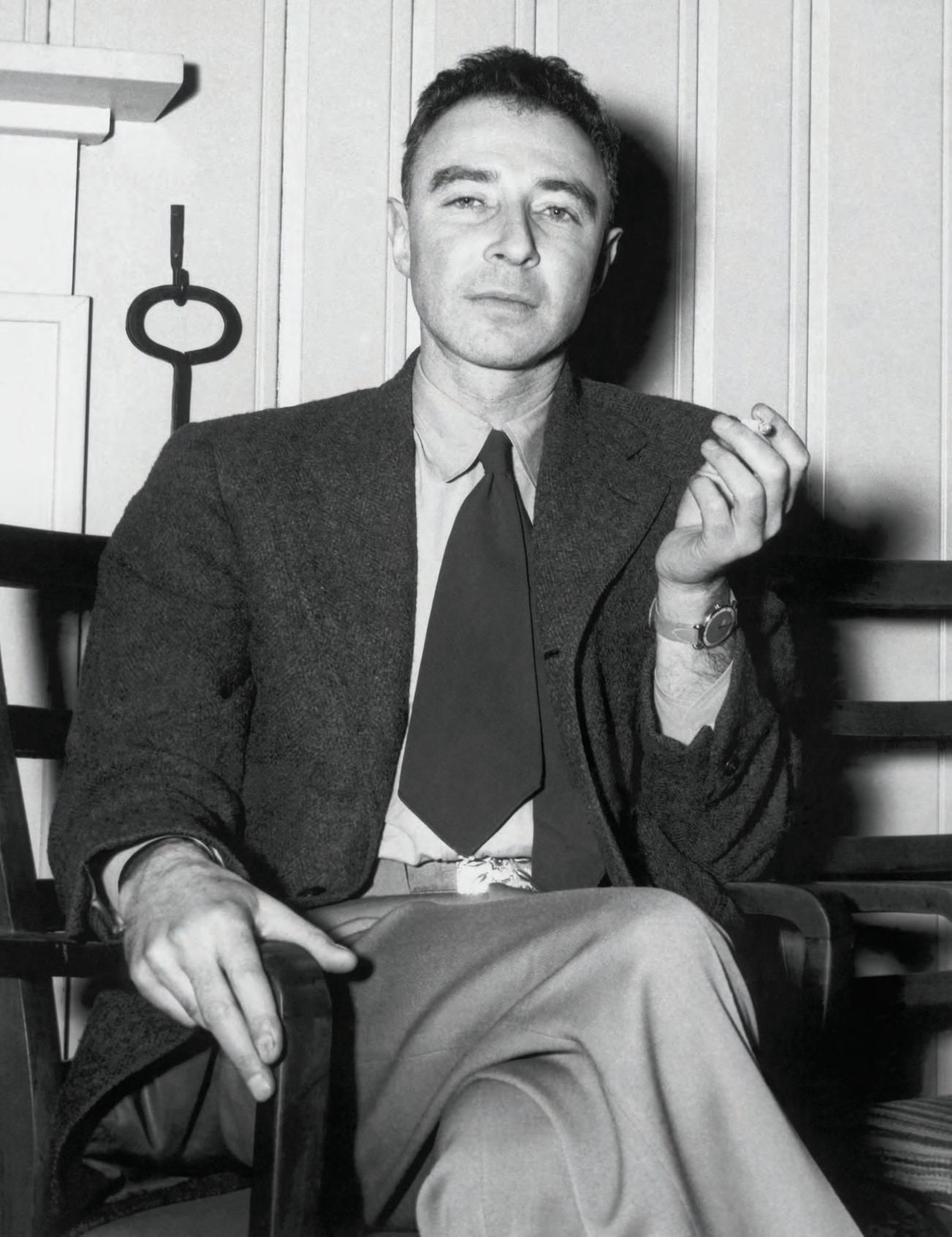
A Sanctuary of Work, Rest and Play
An iconic central London hotel, located adjacent to the famous Trafalgar Square offering unrivalled views. With museums, galleries, theatres and key attractions including Big Ben and Buckingham Palace on our doorstop.

A perfect base for Londoners and travellers alike
trafalgarsw1

2 Spring Gardens, London SW1A 2TS | +44 (0)20 7870 2900 | info@trafalgarstjames.com | W. trafalgarstjames.com
“Our clients said it needs to be a Rolls-Royce first, and an electric car second.” Rolls-Royce CEO, Torsten Müller-Ötvös, on the company’s first electric car, p.60
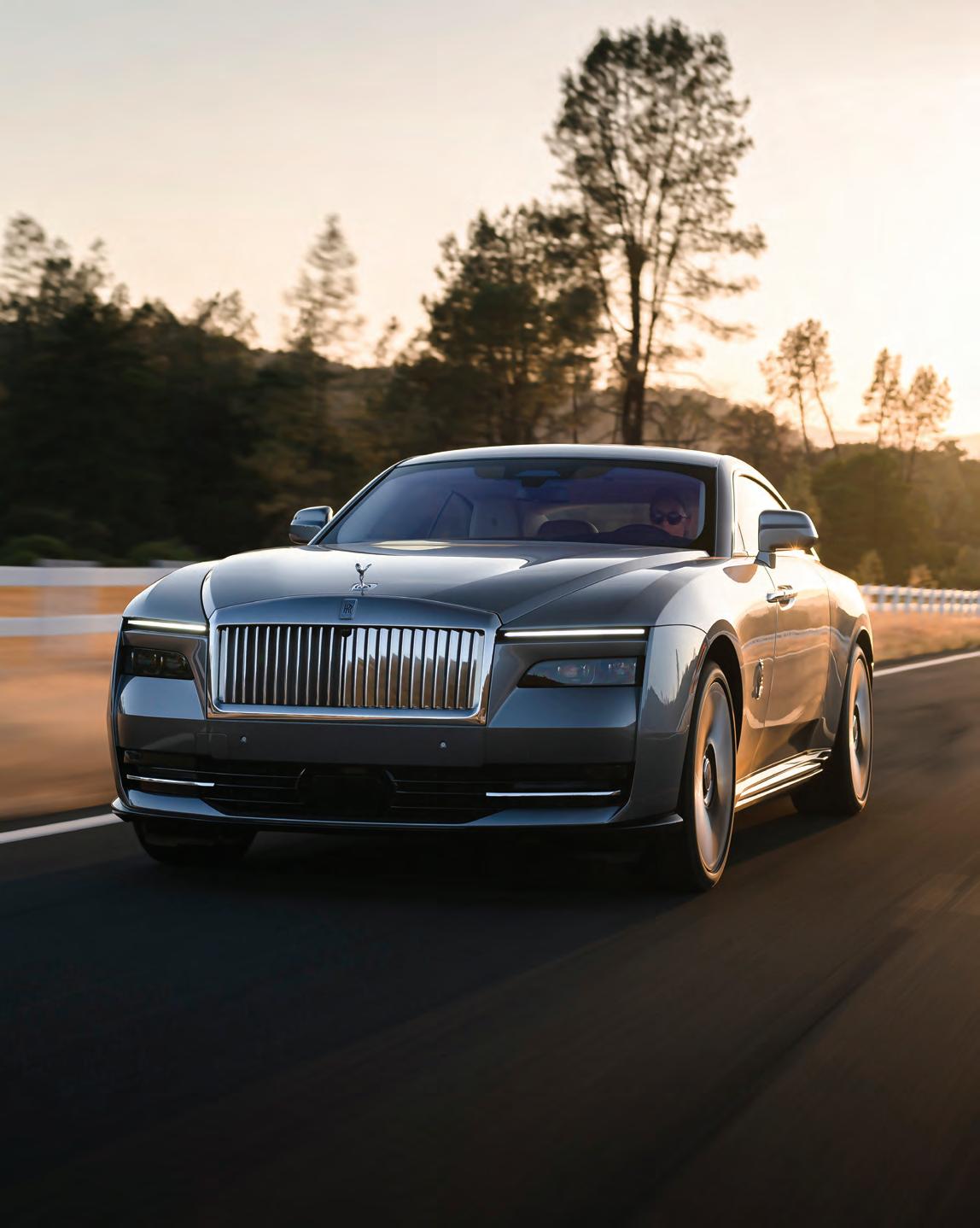
Drive
56 Ferrari Purosangue On the road with the Italian marque’s first four-wheel-drive, family-minded supercar 60 Rolls-Royce Spectre The first fully-electric motor from the Goodwood-based manufacturer talks the talk – but can it walk the walk?
HYPERCARS, HOT HATCHES & SUPER SUV s
HIGH HORSE
IS IT AN SUV, OR ISN’T IT?
FERRARI SAYS NOT. IN WHICH CASE, WITH THE PUROSANGUE – ITS FIRST FOUR-DOOR, FOUR-SEAT, FOUR-WHEELDRIVE SUPERCAR – THE ITALIAN MARQUE HAS CREATED A MARKET ALL OF ITS OWN
 Words: Rory FH Smith
Words: Rory FH Smith
“Simplicity is complexity resolved,” said the great sculptor and artist Constantin Brâncusi. It’s a phrase that Flavio Manzoni, Ferrari’s design chief, kept referring back to during the development of the marque’s most radical and complex car to date.
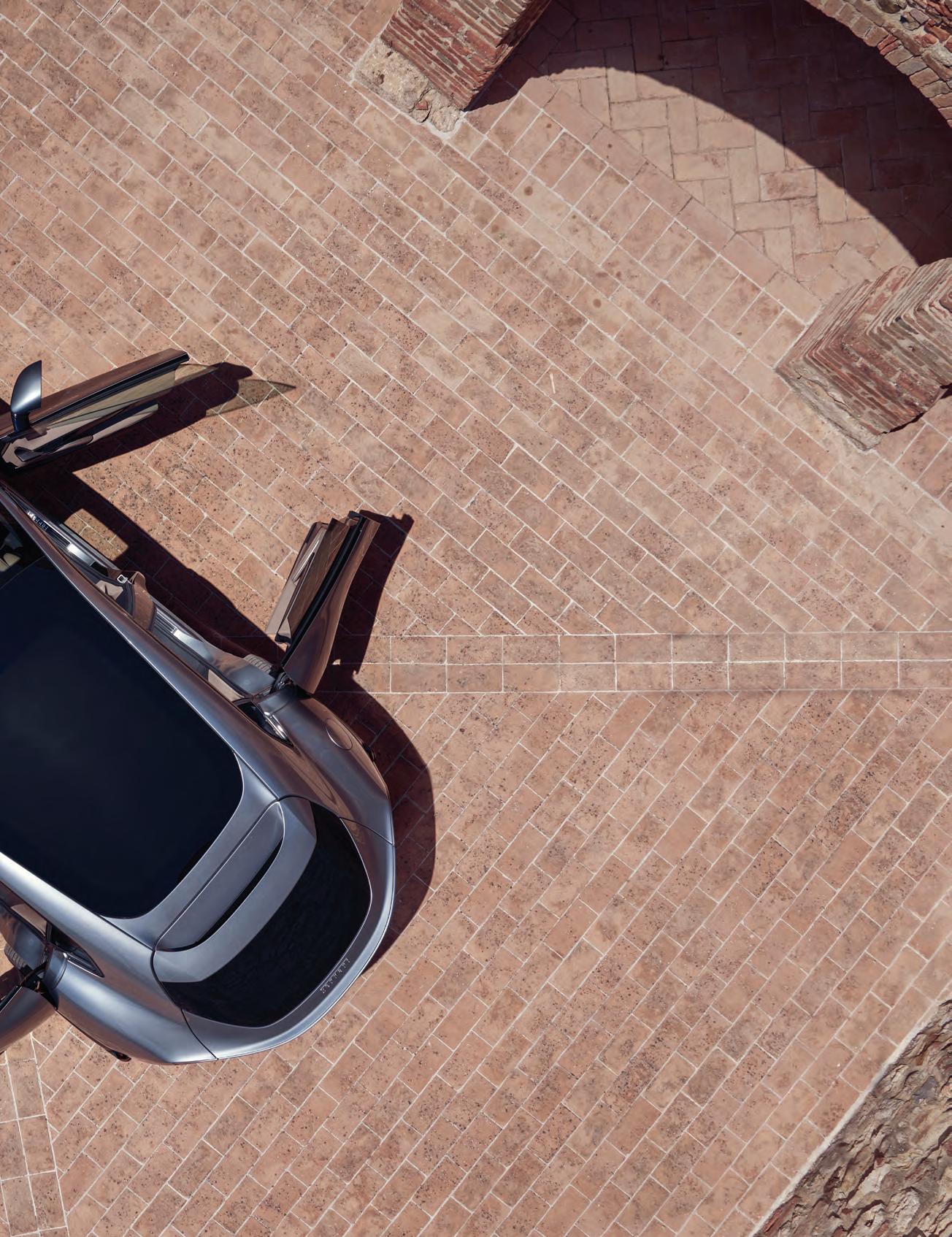
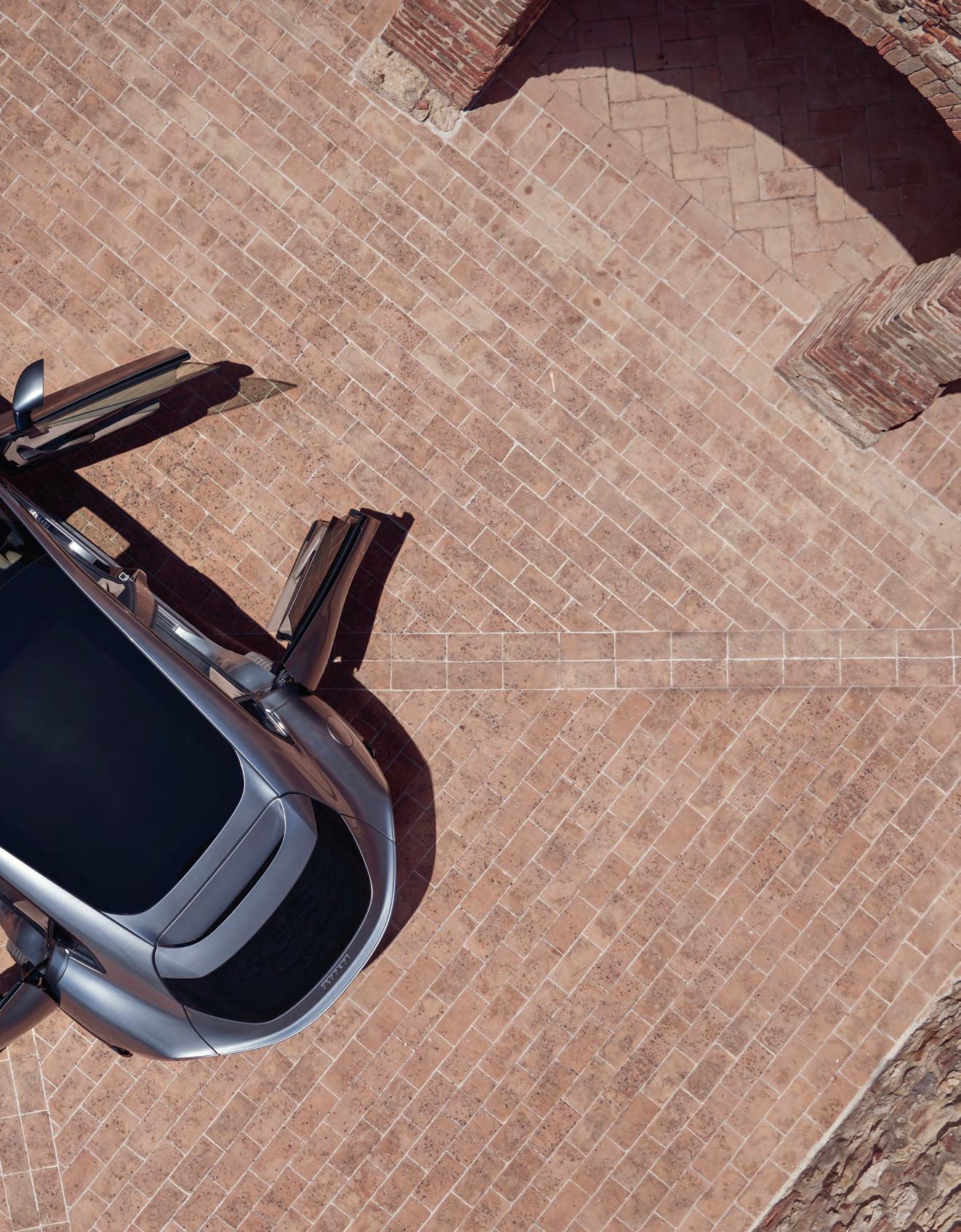
For a long time before the covers came off the Purosangue in September 2022, speculation was that Ferrari was to launch an SUV, following in the footsteps of its rivals Porsche, Lamborghini and Aston Martin, all of which had brought out a superspec 4x4. Only it wasn’t. The Purosangue turned out to be far more obscure, far more specialised, far more, well, Ferrari.
“Right from the word go, we really embraced this idea of a new type of Ferrari that had never been in the range,” said Manzoni at the car’s global launch in the Dolomites earlier this year. “Something with completely different architecture and challenging characteristics.” With no blueprint to work off, save for the 1980s Ferrari Pinin concept car that never made it to production, Manzoni and his team started to piece together what the marque’s first four-door, four-seat and four-wheel-drive car might look like. The result was not your typical SUV.
Despite the raised ride height, the Purosangue is squat and compact, no small feat given what lies inside. With a mid-front-mounted naturallyaspirated V12 engine sitting behind the front axle, there’s still enough room inside to transport four adults in comfort and a boot large enough to swallow a light sprinkling of luggage. Smaller than the SUVs brought to market by its peers, the Purosangue is unique in its standing as a highriding grand tourer with performance that matches up to Ferrari’s sporting expectations.
“It was a very complex project and began with an activity that is extremely important at Ferrari, that of defining the architecture,” added the design chief. Testament to just how technically challenging was the task of creating a high-riding Ferrari, Manzoni’s team took an entire year to define that architecture, from which the rest of the project followed. Starting with the obvious and non-negotiable Ferrari principles, such as driving pleasure and performance, Manzoni’s team set out to create a car that had a “roomy interior” while also working on the car’s versatility and accessibility.
Manzoni may have been working on an all-new platform, but he could at least call on Ferrari’s rich heritage in creating some of history’s greatest grand tourers. Also known as two-plus-two coupés, Ferrari has specialised in making sports cars with two smaller back seats and room for luggage since
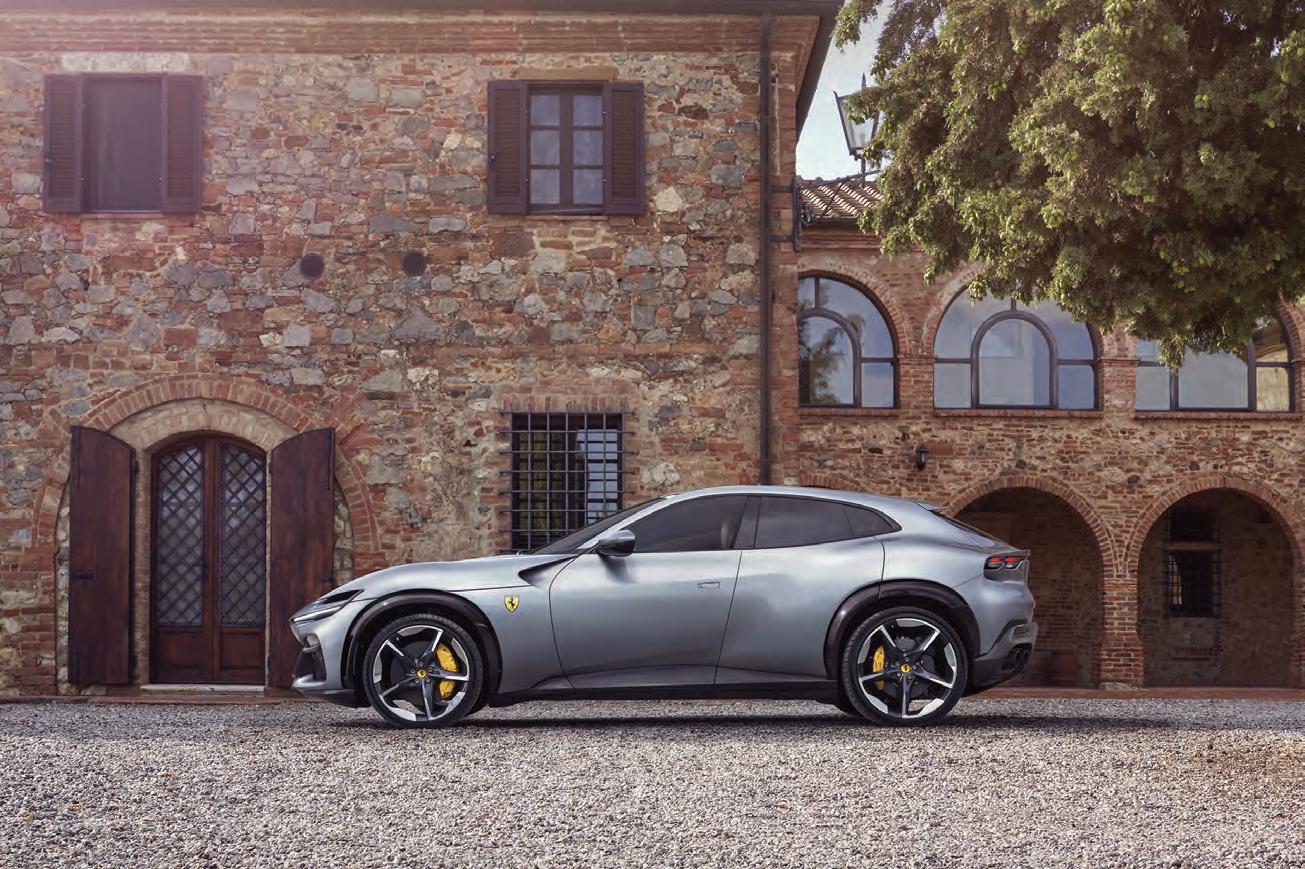

the early 1960s. Back then, cars like the 250 GT 2+2 were Enzo Ferrari’s favourite daily drivers, praised for their charming combination of practicality and performance.
“Everything has been worked out on the Purosangue to maximise this concept,” said Pietro Virgolin, Product Manager for the project. “You need to feel as if you’re driving a Ferrari, but at the same time you need to be able to drive it daily – with the children or using it for travel.”
With that 6.5-litre, naturally-aspirated V12 at its heart, the Purosangue is a family car that’s capable of outrunning most of the sports car market. The dash from standing to 62mph takes just 3.3 seconds thanks to 715bhp, while the Purosangue can hit a top speed of just under 200mph. Out on the road, that makes for a lively driving experience when pushing hard on the hairpins, twists and turns, with the V12 providing a sensational soundtrack to match.
Skipping between the five drive modes, the car takes on different personalities depending on the mode selected. As expected, Sport mode brings the noise and theatre along with a firmer ride, while the slick four-wheel steering can overcome the Purosangue’s more-than-two-tonne mass, turning the motor into a spritely sports car when the moment calls. For tamer driving, Comfort mode is the choice for cruising around town, on the motorway or in traffic. Here, the exhaust note is kept to a minimum and the ride is softer. The Purosangue can act as a calm and composed city car when needed.
Aside from the impressive breadth of performance, the real focus of this Ferrari is the interior. As the marque’s first real family car, extra attention has been paid to the trim and feel. From the moment the rear doors automatically swing open, much like a Rolls-Royce, the Purosangue feels like a special car, with leather, carbonfibre and a new weave of Alcantara, made from
recycled polymers, lining the inside. From the outside, the squat proportions suggest the car might be cramped, but the Purosangue’s interior is surprisingly spacious and light, so long as the optional glass roof is specced over the standard carbon roof.
Available only as a four-seater, the rear occupants are treated to full-sized, supportive bucket seats, while the front seats feature in-built massagers –another first for Ferrari. Looking ahead, the novel dual digital display up front gives the driver all the traditional readouts, while a second ‘co-driver’ screen lets the front passenger control the music or view the driving data, including the speedometer and rev counter. While an unnecessary touch, it adds a sense of occasion to the Purosangue’s cabin and brings it in line with other cars in the Ferrari stable. Only the fiddly haptic touch buttons on the steering wheel take the shine off what is a wellmade, functional and comfortable interior.
With so much hype and build-up to what many believed would be Ferrari’s first SUV, the Purosangue was a pleasant surprise. A curious combination of sports car fused with a high-riding family four-wheel drive, the Purosangue is largely unmatched in the automotive marketplace. After watching its immediate rivals take the plunge into unknown SUV territory where, in some cases, the result was a compromised car, Ferrari’s approach feels more considered and complete, which is reassuring considering the base car costs more than £300,000. Expected to make up 20 per cent of Ferrari’s production in 2023, it’s clear that the Maranello marque is confident the price won’t deter those looking to own the first ever familyminded Ferrari.
With nothing quite like it on the roads today, you wonder if the brand of the Prancing Horse has just created a completely new category of super-luxury sports car.
59 LUXURY LONDON DRIVE LUXURYLONDON.CO.UK
ferrari.com ENGINE 6.5-LITRE V12 MAX. POWER 725 CV AT 7750 RPM MAX. TORQUE 716 NM AT 6250 RPM MAX. REVS 8,250 RPM 0-62MPH 3.3 SECONDS MAX. SPEED 193MPH PRICE FROM £313,120 FERRARI PUROSANGUE – THE STATS
It’s clear that the Maranello marque is confident the price won’t deter those looking to own the first ever family-minded Ferrari
POWER
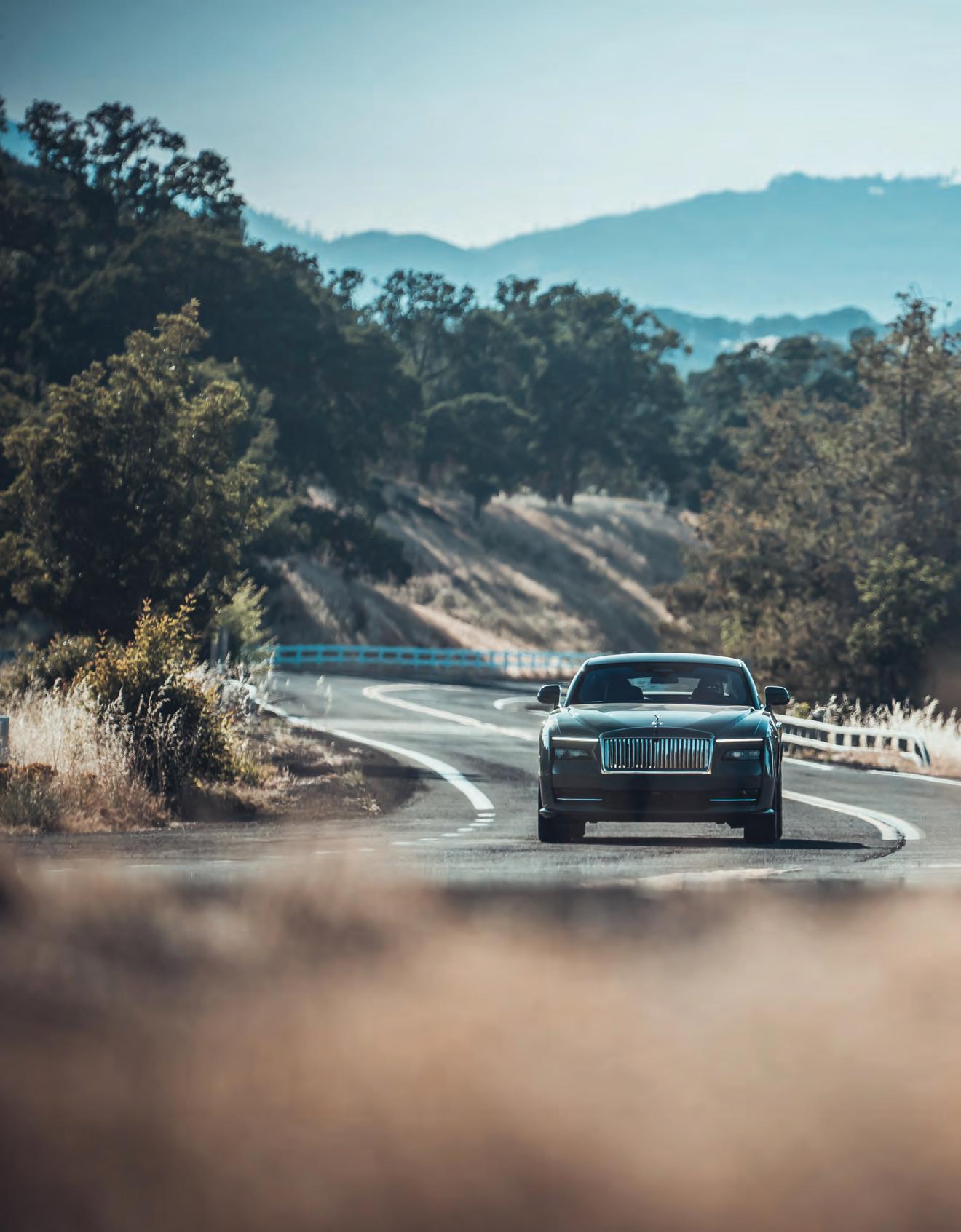
CHARM, SOPHISTICATION, DROP-DEAD LOOKS AND A NEAR-SILENT DRIVING EXPERIENCE – IS THE SPECTRE, ROLLS-ROYCE’S FIRST FULLY-ELECTRIC CAR, THE MARQUE’S MOST IMPRESSIVE FEAT EVER?
Words: Rory FH Smith
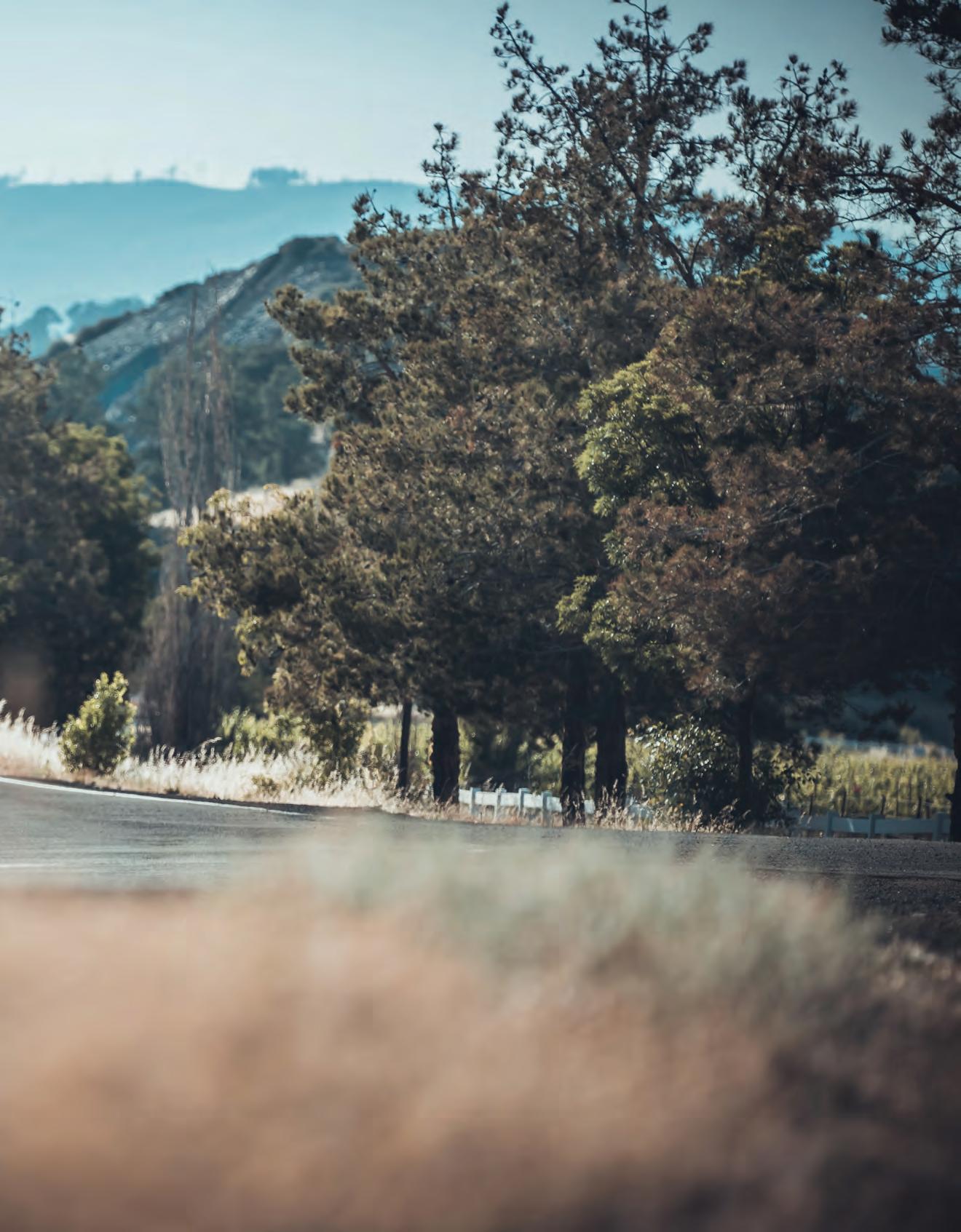
TRIP
espite Rolls-Royce’s affinity with silky smooth V12 engines, electric vehicles have been on the radar of the century-old carmaker for longer than you might think. “The electric car is perfectly noiseless and clean. There is no smell or vibration. They should become very useful when fixed charging stations can be arranged.” So said Charles Rolls, way back in 1900, six years before he would establish the eponymous marque with his great friend, Henry Royce.
Despite Rolls’ prophecy, petrol power won out and more than a century of combustion-engine Rolls-Royces followed. Then, several years ago, the Goodwood-based marque began experimenting with electric batteries. By 2021, Rolls-Royce was ready to tease images of its first, production-line electric car – the Spectre.
The curtain wasn’t fully pulled back until June 2023, when the Spectre was officially launched during test drives around California’s Napa Valley. Its presence in the hills of America’s wine country was hard to ignore. Measuring almost six metres long, the two-door, four-seat coupé is marginally shorter than the marque’s Phantom Extended Wheelbase – the longest production car in the world. Despite its electric underpinnings, Spectre retains all of Rolls-Royce’s classic design cues with its long bonnet, upright front, high beltline and sheer surfaces. Its slick, rakish design makes an instant impression – even among other Rolls-Royces.
“For me, it’s important [the design] relates to the electrical drivetrain,” says Rolls-Royce’s Director of Design, Anders Warming. “But also the fact that we are referencing cars of the past. This is where a brand like Rolls-Royce pays tribute to its founders. The spirit of those founders continues in this car.”
For Spectre, the design boils down to just three lines, or “pen strokes,” as Warming calls them. There’s the beltline, that extends from the front of the car to Spectre’s thick, sloping rear pillar. Then the shoulder line, which starts at the door handle and creates another svelte curve. Lastly, and most intriguingly, we have what Warming refers to as “the waft line.” Located across the lower part of the sill, the line gives the Spectre its graceful and peerless presence on the road.
At the front, the grille is the widest of any RollsRoyce. Above the grille sits a revised Spirit of Ecstasy, with lower wings to make it more aerodynamic. It’s a small touch that only the keenest of Rolls-Royce fans will detect, but it’s also a nod to the need for EVs to stay as slippery as possible. Range, after all, has always been the biggest hurdle.
On that front, the Spectre’s impressive 329-mile WLTP limit is the result of a whopping 102kWh lithium-ion battery. It alone adds 700kg to the car. Attached to two motors – one front and one back – the Spectre’s powerplant produces 430kW (577hp) and 900 Nm of torque, propelling the car from nought to 60mph in 4.4 seconds – that’s some achievement for a car that weighs just shy of three tonnes.
Despite the weight, the engineering wizards in Goodwood have worked wonders on the Spectre’s ride and handling. It’s business as usual when it comes to Rolls-Royce’s fabled ‘magic carpet ride’ and, on the tight and twisting canyon roads of California, the Spectre corners surprisingly well, with minimal roll and absolutely no fuss. Accelerating out of the bends is a pleasure – you won’t snap your neck in the way you do in other electric cars, the engineering team at Rolls-Royce having deliberately built in a slight delay upon accelerating so as to keep the ride smooth.
“Other manufacturers are rocketing the car,” says Dr Mihiar Ayoubi, Rolls-Royce’s Director of Engineering. “That’s exactly what we don’t do – we put in an artificial delay to the electric drive because it should feel natural.”
On the road, the Spectre’s various systems work silently in the background to ensure the car remains composed. The deliberate delay is barely noticeable in reality but it does the job. The car accelerates softly and smoothly. Boot the right foot and it is possible to make it pitch up and down but only under extreme acceleration or braking, as you might expect from a three-tonne car with close to 600hp.
In the cabin, the quality of materials, layout and feel is second to none. Few cars match the interior experience and theatre of a Rolls-Royce and, in that respect too, the Spectre is the marque’s most advanced motor yet. The company’s muchloved starlight headliner, which debuted in 2007, now spills into the doors and the sides of the rear passenger compartment, with 4,796 softly illuminated ‘stars’ adding wraparound sparkle to
D
“Other manufacturers are rocketing the car.
That’s exactly what we don’t do –we put in an artificial delay to the electric drive because it should feel natural”

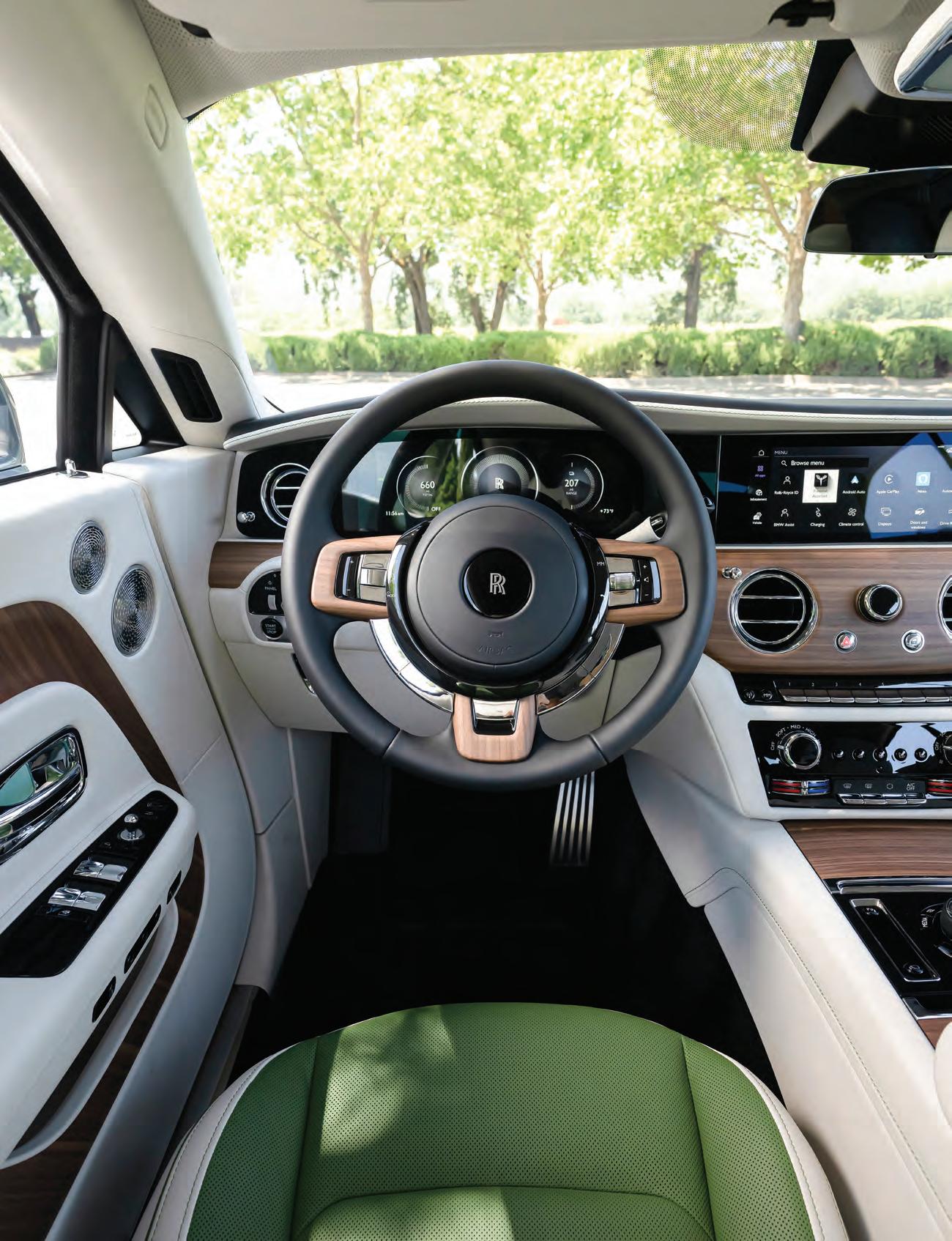
the Spectre’s interior. While it might not be for everyone, it’s nothing if not an innovative and unique approach to interior lighting.
Up front, the Spectre sports new and simplified digital graphics in the driver’s dash display as part of the brand’s new digital ‘Spirit’ architecture. As well as allowing owners to configure the colour of the dials and dash display, the Spirit system manages the car’s functions and syncs with RollRoyce’s Whispers app, meaning that owners can interact with their car remotely.
Blending a touchscreen interface with a reassuring number of beautifully-made metal buttons and switches, Spectre’s centre console marries exquisitely-realised form with best-inclass function. I spent almost four hours behind the wheel, yet emerged from the car’s sumptuous and soundproof interior feeling fresh; rested, even. Only a handful of cars have the ability to make you feel like that. It is one of the Spectre’s greatest strengths.
“Our clients clearly said it needs to be a RollsRoyce first, and an electric car second,” says longstanding Rolls-Royce CEO, Torsten Müller-
Ötvös. Outlining experimental vehicles like the electrified Phantom 102EX, which revealed the marque’s electric curiosity in 2011, Müller-Ötvös is keen to point out that it’s taken more than a decade for the technology to mature to a point where Rolls-Royce felt it could commit to a fullyelectric car.
“When we spoke about going electric, battery technology and charging were not at levels that I, or our clients, would consider as being appropriate for a Rolls-Royce,” he says.

Ahead of its own EV arriving in 2025, Bentley will no doubt be keeping close tabs on sales figures for the Spectre, which is sure to establish itself as the benchmark for any future super-luxury electric coupé. The car starts at £330,000. After extras, most models will leave the factory costing close to £500,000. Is the Spectre really that much better than anything else currently on the road?
Well, if you value the coming together of craftsmanship and technology, if you appreciate driving experience and design, then, in a word, yes.
rolls-roycemotorcars.com
LUXURY LONDON DRIVE
PRICE FROM £330,000 BATTERY 2 X 102KWH E-MOTORS POWER/ TORQUE 577BHP/900NM TOP SPEED 155 MPH RANGE 323 MILES CHARGING 195KW (10-80%) IN 34MIN ROLLS-ROYCE SPECTRE
A WHISKY CREATED BY PEOPLE, PLACE, SPIRIT AND TIME.
Part of our “Extremely Scarce” range. The Glenturret 30 Years Old has been shaped by three distinct distillery visionaries from both Scottish and French influence. This release, limited to only 750 bottles is drawn from eight casks: American Oak refills sweet and fruity evolving over time, European Oak first fill adds depth, vibrancy, and texture. These cask influences brought together create this luxuriant single malt.
 BY HAND & HEART SINCE 1763
BY HAND & HEART SINCE 1763
T: + 44 (0)1764 656565
E: enquiries@theglenturret.com
www.theglenturret.com
Please enjoy The Glenturret responsibly. For further health information visit drinkaware.co.uk
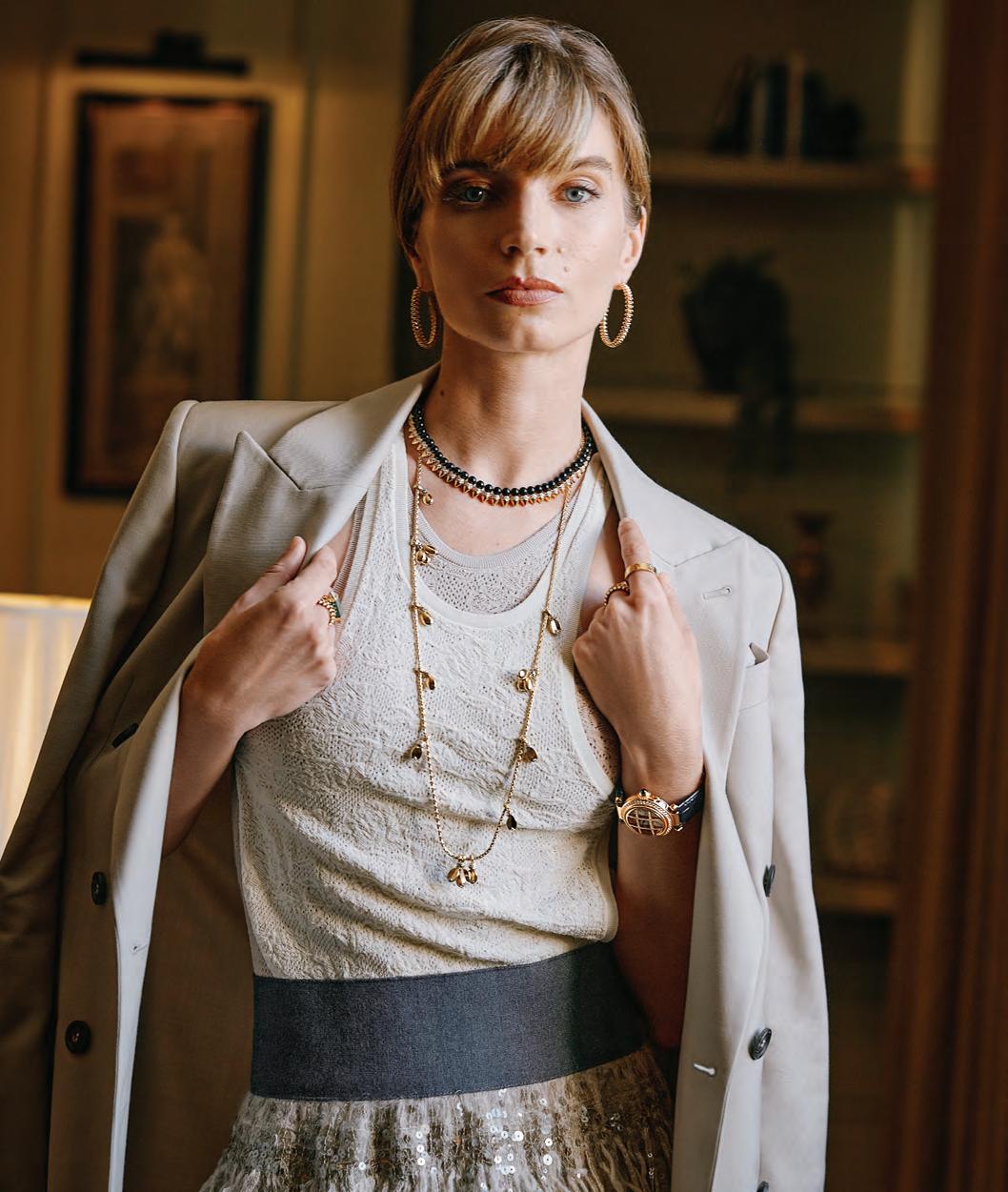
3 Only Watch 2023 4 The latest from the world of haute horology 9 The Fifty Fathoms turns 70 12 What's in a watch name? 28 AW23's most mesmerising jewellery 30 CEO Interview: Joanne Milner 34 Harry Winston's Royal Connections
WATCHES JEWELLERY

















2
ONLY WATCH 2023
Words: Richard Brown
Soon after his son, Paul, was diagnosed with a severe form of muscular dystrophy, Luc Pettavino stood down as CEO of the Monaco Yacht Show in order to dedicate his life to funding research into the rare neuromuscular condition. One of the many initiatives Pettavino struck upon was Only Watch, a biennial event that invited watchmakers to submit one-of-a-kind timepieces for auction.
Thirty-four horologists signed up to the inaugural Only Watch in 2005. In the 18 years, and 10 auctions, since then, the enterprise has raised close to £90 million for the Association Monégasque contre les Myopathies, a charity co-founded by Pettavino, which was recently renamed Only Foundation.
The theme of Only Watch 2023, in which 73 watchmakers will take part, is ‘All the Colours of the Rainbow’ – a concept

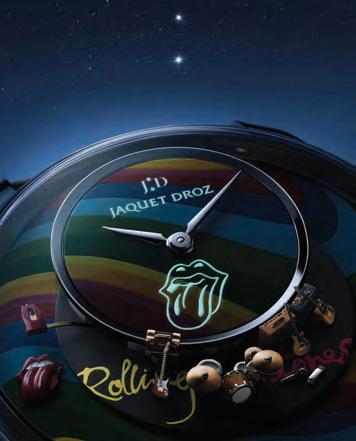
that particular dial-names have embraced with commendable enthusiasm. Automation specialist Jaquet Droz has gotten trippy with a polychromatic dial featuring the Rolling Stones’ Hot Lips logo, while Louis Moinet’s tourbillon-equipped Art-Tech uses a silicon dial to channel video games from the 1980s.


Elsewhere, Frederique Constant has teamed up with independent Dutch watchmaker, Christiaan van der Klaauw, to present its flagship perpetual calendar with a planetarium at 12 o’clock. Hermès, meanwhile, adds bursts of colour to its Arceau Le Temps Voyageur to create an eye-catching piece that, previous auctions suggest, will far exceed its £27,000£36,000 estimate when the gavel falls in Geneva on 5 November. onlywatch.com
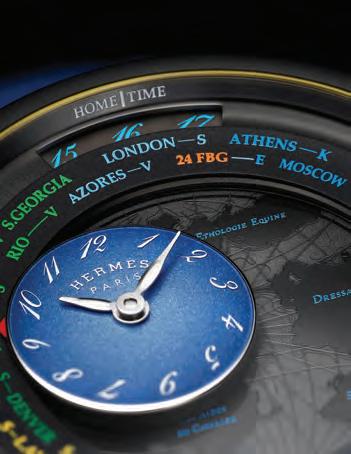

3 WATCHES AND JEWELLERY 2023
CLOCKWISE FROM TOP LEFT JACOB & CO X CONCEPTO WATCH FACTORY ASTRONOMIA REVOLUTION 4TH DIMENSION; ULYSSE NARDIN FREAK S;
VOYAGEUR JAQUET DROZ THE
HERMÈS ARCEAU LE TEMPS
ROLLING STONES AUTOMATON; FREDERIQUE CONSTANT X CHRISTIAAN VAN DER KLAAUW TOURBILLON PLANETARIUM; LOUIS MOINET ART-TECH
Words: Richard Brown
ABOUT
Time
THE LATEST LAUNCHES FROM THE WORLD OF HAUTE HOROLOGY
PATEK PHILIPPE MOVES WITH THE TIMES
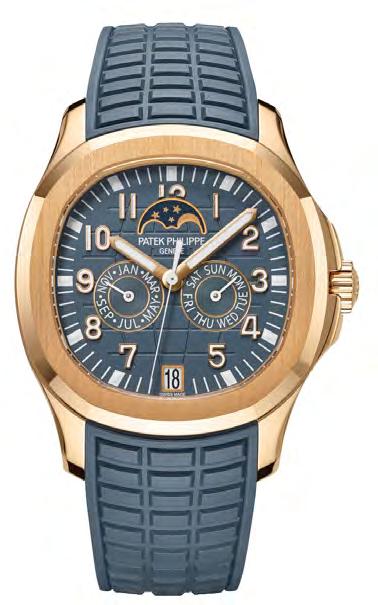
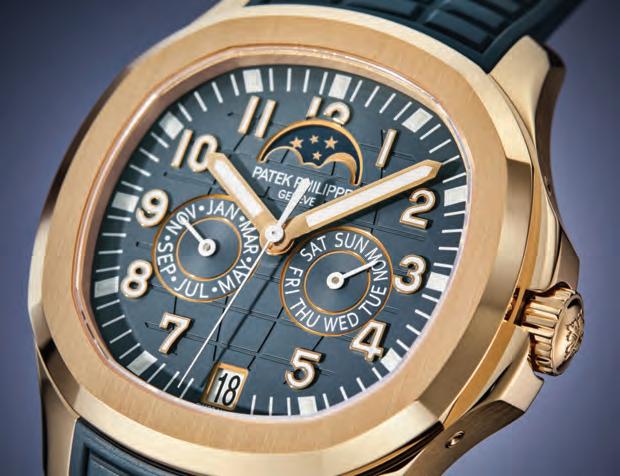
COMPACT AND COMPLEX, THE NEW AQUANAUT LUCE IS ALL THINGS TO ALL PEOPLE
When the first Aquanaut Luce models arrived in 2004, gem-set bezels and 4N red-gold cases identified the timepieces as intended for women (traditionally, Patek Philippe uses 5N gold for gent’s models, and 4N gold for ladies). As you can see here, the latest Aquanaut Luce – an Annual Calendar with an epicene 39.9mm case – arrives minus the sparklers and, yes, in lighter, yellower 5N gold (the 4N stuff has a slightly redder sheen).
BELL & ROSS BEEFS UP ITS BR 05
The 2019 launch of Bell and Ross’ BR 05 registered as one of the most significant debuts of that year. And while some hard-line brand purists decried the company for departing from its cockpit-clock DNA, most sensible folk recognised the watch for what it was – a sleek commercial offering that could be worn by people that weren't horn-rimmed spectaclewearing product designers, or fighter pilots.
This year, the chronograph version of the BR 05 has been upped to 42mm, so as to house an upgraded movement that now offers a 60-hour power reserve. The emerald green colour scheme is also new. Choose between an integrated steel bracelet or a textured green rubber strap. From £5,500, bellross.com
This is the first time that Patek Philippe has offered a complicated Luce model without a diamond-set bezel, and represents the first runout for an androgynous new colourway imaginatively coined ‘blue-grey’. A watch, in essence, for everyone. £49,530, patek.com
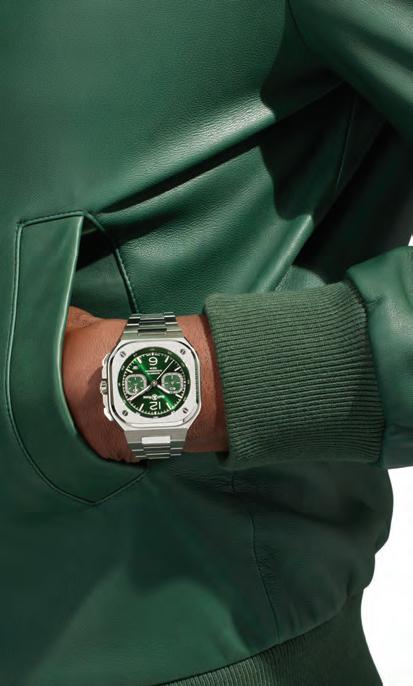
4
THE FRANCO-SWISS HOROLOGIST ENLARGES ITS FLAGSHIP SPORTS WATCH
FLYING HIGH
BREGUET'S COVETED PILOT'S WATCH IS BACK AND BIGGER THAN EVER
Twenty-eight years since the modern Type XX was released – and five years since the most recent models were discontinued – Breguet has revived its popular pilot's watch. Two models are available. The Type 20 ‘military version’ (pictured) has a 30-minute register and smallseconds counter; while the Type XX ‘civilian version' is equipped with a 15-minute register, a 12-hour register and a small-seconds counter. Unlike earlier models, both versions now feature a date window. Cases have been upped from 40mm to 42mm. Both £16,400, breguet.com
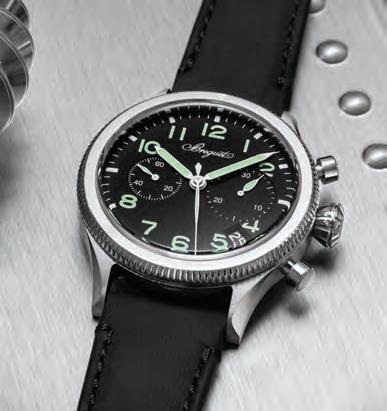
RADO'S OPEN HEART SURGERY
THE CERAMIC SPECIALIST STRIPS THINGS BACK WITH THE TRUE SQUARE SKELETON
Rado had been playing around with ceramic long before it became de rigueur to employ the tricksy, hard-as-nails-but-brittle-as-egg-shells material in bezels. In 1986, the brand became the first watchmaker to offer a timepiece – the right-angled Ceramica – with a case, crown and bracelet made entirely of ceramic, a material that’s more than four times harder than standard stainless steel.
In tune with the spirit of the Ceramica, Rado’s True Square arrived in 2020 with a monobloc case injectionmoulded with ceramic. This year, the brand has cut away at the watch’s dial and top plate to shine a light on its new, super-shock-resistant R808 movement. A credible amount of watchmaking for just £2,600. rado.com
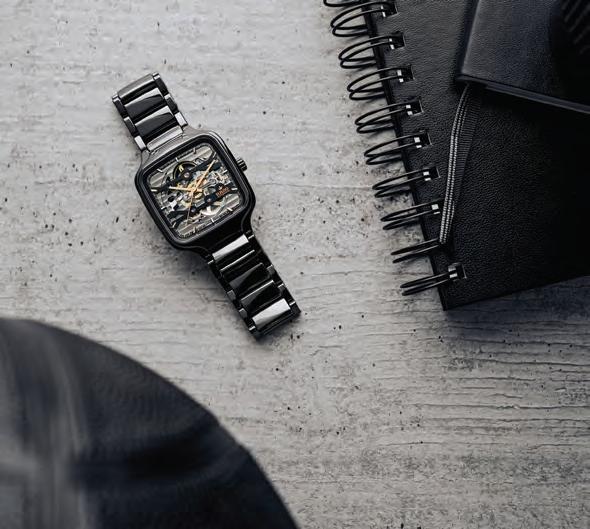
BENNAHMIAS' SWANSONG
THE AUDEMARS PIGUET BOSS BOWS OUT IN (HIGH) FASHION
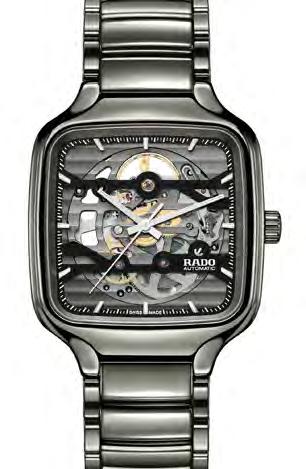
After 29 years, 10 of which have been spent as CEO, François-Henry Bennahmias will step away from Audemars Piguet at the end of this year, making way for incoming former perfume boss, Ilaria Resta. One of Bennahmias’ final acts as AP supremo was to reveal the brand’s four-watch collaboration with American fashion designer Matthew Williams (pictured).
As the founder of luxury streetwear brand 1017 ALYX 9SM, Williams has become synonymous with a pared-back, utilitarian aesthetic. True to form, his partnership with Audemars Piguet sees the Chicago-born designer apply a minimalistic approach to two Royal Oak and two Royal Oak Offshore models. Hour indices and minute markers have been removed, as have the sub-dials on two chronograph models. A suitably contemporary collection on which the forward-looking boss can retire. From £63,200, audemarspiguet.com
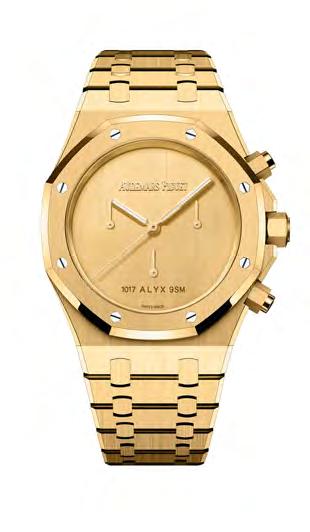

5 WATCHES AND JEWELLERY 2023
BROUGHT TO LIGHT
TITANIUM BECOMES LATEST NON-PRECIOUS METAL TO BE EMBRACED BY ROLEX
Back in 2021, Britain’s Sir Ben Ainslie, Rolex ambassador and the most successful sailor in Olympic history, was photographed wearing a prototype Rolex purported to have been made from titanium. The photograph was widely shared in watch circles, eliciting exactly the sort of excitement you’d expect such a watch to elicit in such circles, and then the story went quiet.
Were we about to see the first ever titanium Rolex? Or, like that jaw-dropping Jaguar C-X75 in Spectre, which, tragically, never got put into production, was Ainslie’s prototype destined to remain a concept watch forever?
Last year, we thought we had the answer. In November 2022, Rolex unveiled the new Deepsea Challenge, a 50mm dive watch that was guaranteed to a mind-bending 11,000 meters, making it the most pressure-resistant watch ever made. As it turned out, that wasn’t the end of the story.
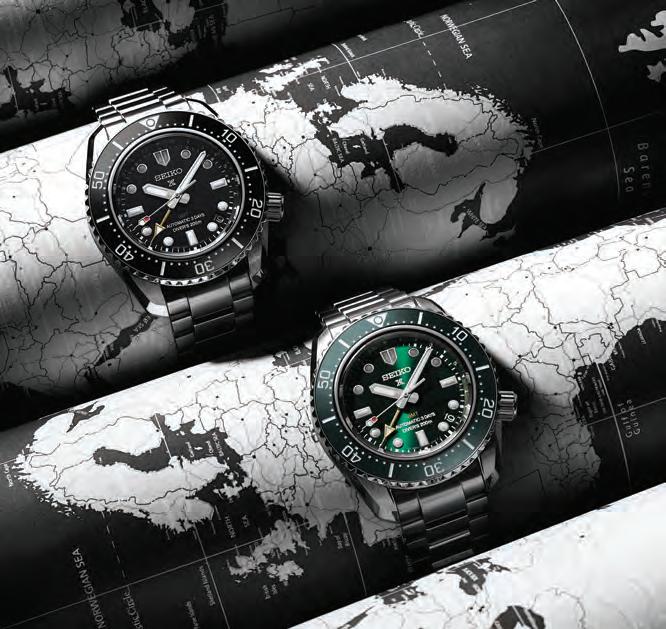
This year Rolex revealed the Yacht-Master 42 RLX in titanium. The titanium tale is, of course, a story about weight. Almost half as heavy as stainless steel, the new Yacht-Master 42 weighs around 100 grams – or, to put that another way, about the same of 100 paper clips.
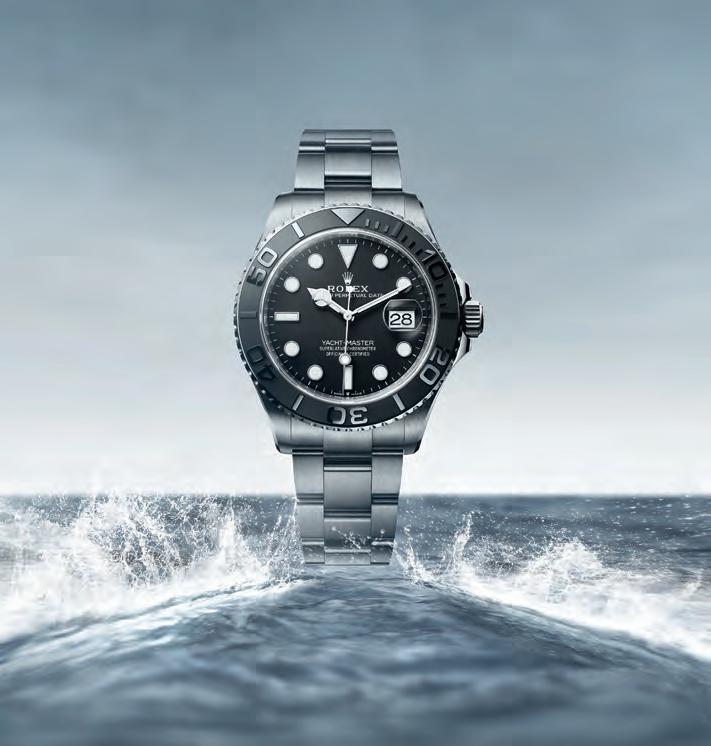
£11,800, rolex.com
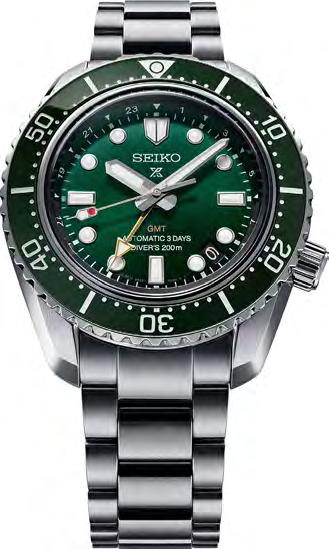
SEIKO'S FIRST GMT DIVER
UNDERWATER EXPLORERS CAN NOW TRACK A SECOND TIME ZONE
The first modern dive watch to come out of Japan rolled off Seiko’s production lines in 1965. The watch was made at the behest of a diver from Hiroshima, who’d written to the company to express his frustration at not being able to find a watch that could function at depths greater than 300 metres. Ten years later, Seiko manufactured the first watch capable of functioning at depths of 600 metres, followed, in 1982, by the first diver’s watch to incorporate an alarm. This year’s Prospex ‘Marine Green’ GMT may not feature an inbuilt warning system, but it will tell you the time in a second time zone. It will also run autonomously for 72 hours.
£1,400, seikowatches.com
6
TUDOR SLIMS THINGS DOWN
THE BLACK BAY GETS A NEW BEZEL COLOUR AND A MORE COMPACT CASE
Tudor’s dive watch credentials run deep. In 1954, the year in which Rolex brought out the Submariner, the Rolex sister-brand came out with its own deep-water watch, the Oyster Prince Submariner. This year, Tudor upgraded that watch’s successor, the Black Bay, with a METAS-certified movement, housing it in a slimmer, more ergonomic case. The burgundy bezel is a winner. So, too, is the new five-link stainless steel Jubilee-style bracelet. £3,720, tudorwatch.com
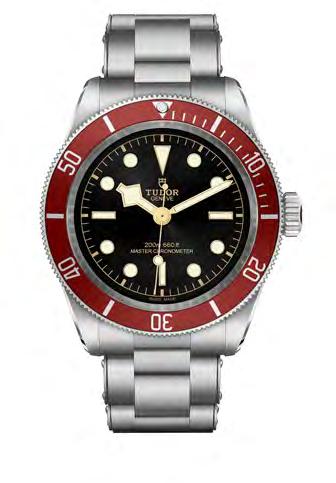
INTO THE DEEP BLUE
AN APT NEW COLOURWAY FOR OMEGA'S DEEPEST DIVERS

To mark the 75th anniversary of the Seamaster, Omega has rendered two of its most intrepid dive watches – the Planet Ocean 600M (pictured, £6,800) and Planet Ocean 6000M Ultra Deep (£12,000) – in an appropriate new colourway: dark blue. Shine a UV light on the dial of the Ultra Deep and a scribble of hidden text is revealed. Written playfully at three o'clock, ‘10,935m – Omega Was Here’ is a nod to a record set by the watch during a diving expedition in 2019. omegawatches.com
THREE OF THE BEST
A TRIO OF THIS YEAR'S TOP DIVE WATCHES THAT AREN'T THE NEW ROLEX YACHT-MASTER 42 (I.E. DIVE WATCHES YOU MIGHT ACTUALLY BE ABLE TO GET YOUR HANDS ON)...
BREITLING ENDURANCE PRO IRONMAN
70.30 WORLD CHAMPIONSHIP

The Endurance Pro is machined from a proprietary material that is more than three times lighter than titanium – so at least you won’t have to worry about your watch weighing you down. £2,950, breitling.com
GLASHÜTTE ORIGINAL SEAQ
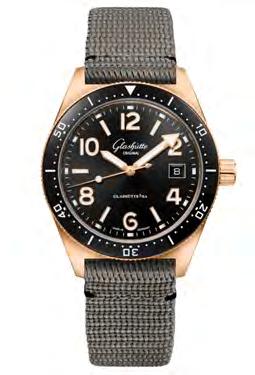
Sporting a smouldering red-gold case against a synthetic grey strap, the latest SeaQ is the first dive watch from the German horologist to display its inner, hand-finished workings through an exhibition caseback. £21,000, glashuette-original.com
TISSOT SEASTAR 1000 POWERMATIC 80

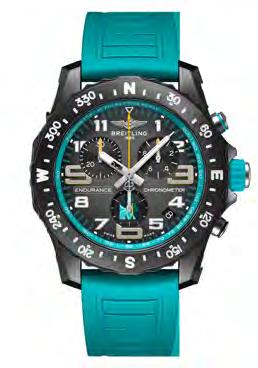
Good to a depth of 300 metres, powered by a Swiss-made automatic movement, and featuring scratchresistant sapphirecrystal glass and an exhibition case-back, the new Tissot Seastar might just be the steal of the year.
£805, tissotwatches.com
7 WATCHES AND JEWELLERY 2023

Shop online at www.chupi.com Your story, your diamond. Mark your moment with a timeless, precious and sustainable Chupi heirloom ring.
BIG
FISH. BIG POND.
IN 1953 BLANCPAIN BROUGHT OUT A TIMEPIECE THAT WOULD LAY DOWN THE DESIGN CODES OF AN ENTIRE WATCH GENRE. SEVENTY YEARS ON, THE FIFTY FATHOMS CONTINUES TO ACT AS A CRIB SHEET FOR ANY WATCH DESTINED FOR THE OCEAN DEPTHS

Words: Richard Brown

MARINE BIOLOGIST AND BLANCPAIN AMBASSADOR LAURENT BALLESTA WEARING A FIFTY FATHOMS
Here’s the story. In the early 1950s an elite team of French combat divers were looking for a watch that could withstand the pressures of deep-sea diving. The kit we now know as ‘Scuba’ equipment – that is, self-contained underwater breathing apparatus – had just been patented and divers could now descend to far greater depths, staying under water for much longer periods of time.
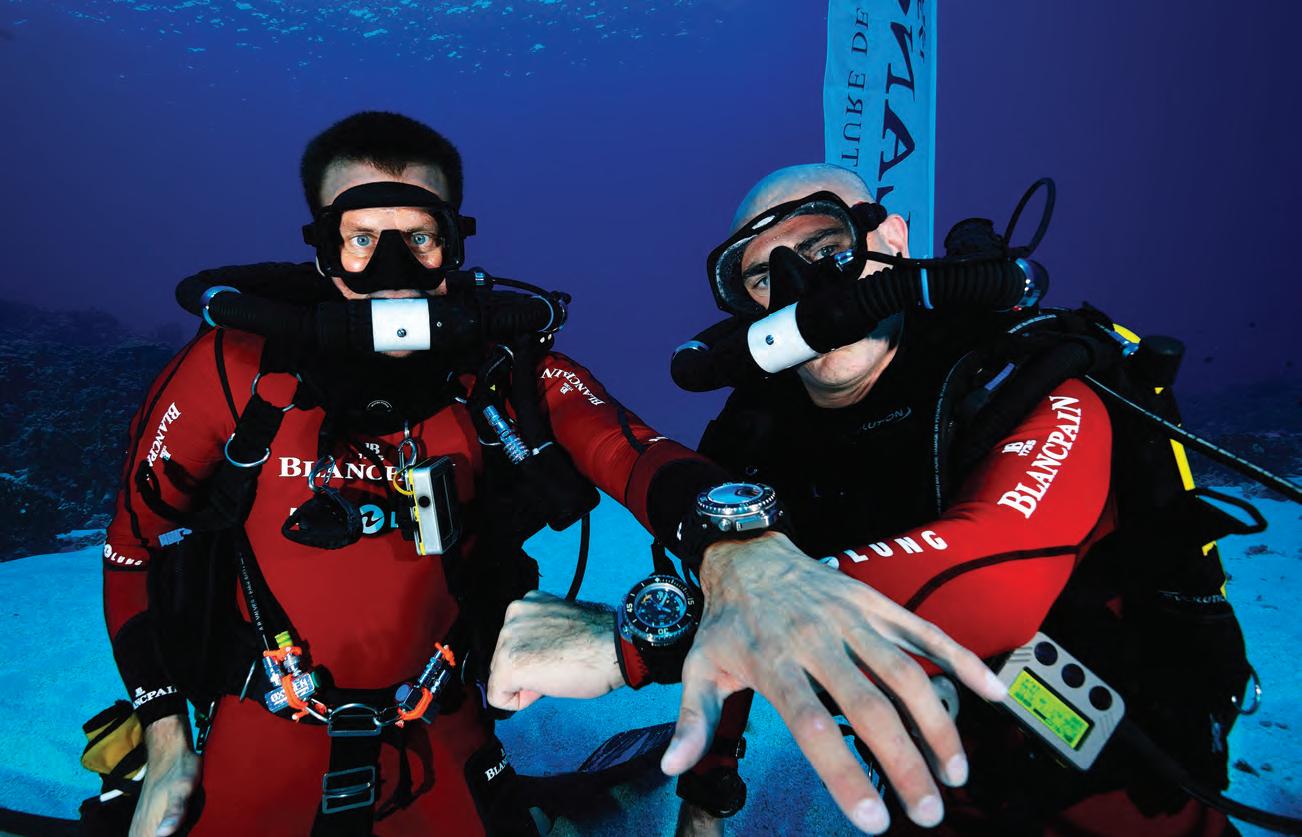
There had, of course, been waterproof watches prior to the 1950s. During the '20s and '30s, Rolex, Cartier, Omega and Panerai had all come up with nifty ways of keeping water out of watches through the use of clever crowns and cases. Yet, to all intents and purposes, these were dress watches you could take for a swim. Nothing had been designed explicitly for exploring the depths of the oceans.
Unable to find a timepiece up to the job, the captain of the diving unit, Robert ‘Bob’ Maloubier – a French secret service agent who’d spent the Second World War blowing up Nazi power stations – sketched the sort of thing he and his frogmen were looking for.
Having approached several bigname Swiss watchmakers, Maloubier was introduced to Jean-Jacques Fiechter, coCEO of a then-periphery outfit called Blancpain, and a keen diver himself (Fiechter was a signed-up member of the world’s first diving club, the Club Alpin Sous-Marin in Cannes). “Finally there was a small watch company that agreed to develop our project,” Maloubier, who died in 2015 aged 92, would later recall.
Maloubier’s sketch outlined a watch with a black dial, large numerals, clear indices and a rotating bezel that mirrored minute markers on the dial. “We wanted at the beginning of a dive to position the bezel opposite the minute hand so as to be able to read the elapsed time,” he said. “We wanted in effect that each of the markers be as clear as a guiding star for a shepherd.”
Fiechter, who had cheated death by mistiming one of his own dives, studied Maloubier’s brief and came up with the ‘Fifty Fathoms’. Delivered in a 42mm stainless steel case – a whopper by prevailing standards – the timepiece featured a rotating
10
“Experience with 12 Blancpain underwater watches during Operation HARDTACK yielded virtually complete satisfaction.
No worthwhile suggestions for improvement of this watch can be offered”
ABOVE LAURENT BALLESTA AND BLANCPAIN CEO MARC A. HAYEK DIVING IN FRENCH POLYNESIA IN 2014
Bakelite bezel and a self-winding movement. The name referred to the depth to which divers could safely descend at the time (around 91 meters), alluding to a line from Shakespeare’s The Tempest – ‘Full fathom five thy father lies.’
The first Fifty Fathoms were delivered to Maloubier’s unit in 1953. After testing, the watch was officially adopted by France’s Marine Nationale, followed by the navies of Germany, Norway, and Israel. Having conducted its own trials, in 1959 the U.S. Navy declared that the Fifty Fathoms was the only watch to pass its rigorous testing programme.
“In summary, experience with 12 Blancpain underwater watches during Operation HARDTACK yielded virtually complete satisfaction,” wrote the Americans. “No worthwhile suggestions for improvement of this watch can be offered.”
Unlike Panerai, whose dive watches were made exclusively for military divisions until 1993, Blancpain manufactured the Fifty Fathoms for both civilian and military markets. Production continued from 1953 until the mid-70s, when, like many mechanical-focused
watchmakers, Blancpain fell victim to the Quartz Crisis.
Revived by the swashbuckling JeanClaude Biver in the '80s, Blancpain was sold to Swatch Group in 1992. It would be incoming CEO Marc A. Hayek, another avid scuba diver, who would resurrect the Fifty Fathoms, on occasion of the now-dormant dive watch’s 50th anniversary, in 2003.
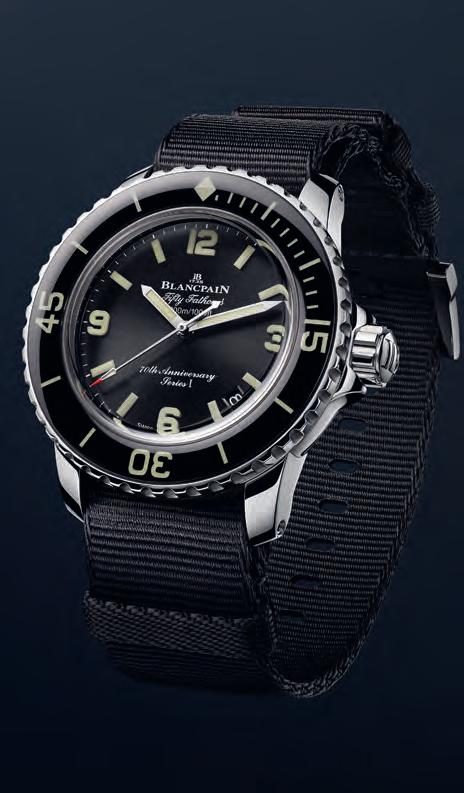
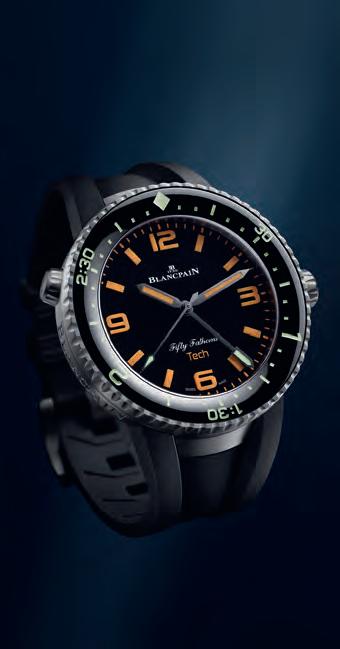
Released in three limited-edition runs of 50 watches, Hayek’s anniversary model landed in a 40mm case and was good to a depth of 300 metres. Each run sold out in the markets to which they were destined: Asia, Europe and North America. To toast the reissue, Hayek joined a then 80-year-old Maloubier for a dive off the coast of Thailand.
This year represents the Fifty Fathoms’ platinum jubilee, a milestone Blancpain has marked with, to date, two new issues. The Fifty Fathoms 70th Anniversary Act 1 arrives with a 42mm stainless steel case – the first modern Fifty Fathoms to be offered true to the size of the original –and a black NATO strap made from 100 per cent recycled fishing nets. Unlike the
original, the watch boasts a five-day power reserve and a sapphire crystal case-back.
The second 2023 instalment – the 70th Anniversary Act 2: Tech Gombessa – was codesigned by Hayek and Laurent Ballesta, founder of marine research initiative, the Gombessa project. In order to study the behaviour of great hammerhead sharks, Ballesta’s team must stay submerged for up to three hours – a period of time that, until now, was tricky to track on an analogue dive watch. The answer? A bezel with a three-hour scale and a hand that completes one turn every three hours –a watchmaking first.
Blancpain has said a third anniversary act will be dropping later this year. Luxury London dived for clues, but it was a tankless task. We’ll have to wait and sea. (Apologies, they wrote themselves).
blancpain.com
11 WATCHES AND JEWELLERY 2023
BELOW LEFT THE FIFTY FATHOMS 70TH ANNIVERSARY ACT 2: TECH GOMBESSA, £24,700 BELOW RIGHT THE FIFTY FATHOMS 70TH ANNIVERSARY ACT 1 SERIES I, £15,200
To toast the reissue, Hayek joined a then 80-year-old Maloubier for a dive off the coast of Thailand
THENAMEGAME

ROLEX'S 40MM COSMOGRAPH DAYTONA IN EVEROSE GOLD
IS IT A COINCIDENCE THAT ICONIC WATCHES TEND TO HAVE ICONIC NAMES? SOME EVOKE PLACES (MONACO, HAMPTON, PORTOFINO); OTHERS SUGGEST POTENTIAL (SUMMIT, EXPLORER, CONQUEST). WITH 2023 WELCOMING A STREAMLINER, A MAJETEK, A SKYLINE AND A CYBERNETIC, JUST HOW DO BRANDS DECIDE WHAT TO CALL THEIR WATCHES?
Words: Josh Sims

Hear someone speak of their new Manero, Seastar or Streamliner and you might just think they're talking about their latest superyacht from Lürssen, Feadship or Heesen. In fact, the names relate to watches; timepieces recently launched by Carl F. Bucherer, Tissot and H. Moser & Cie, respectively. Elsewhere, 2023 has seen the launch of a new Zenith Skyline, the Oceanking from Monta, and Grand Seiko’s Tentagraph.
We may have grown accustomed to such adrenaline-charged, adventureevocating horological nomenclature, but the act of naming a watch so as to bestow a certain personality upon it is a return to an old, somewhat forgotten, habit of the pre-quartz era.
Before the mechanical watch industry was brought to its knees by the advent of cheap, mass-produced quartz watches in the mid-to-late 1970s, there had been two decades of some quite spectacular moniker-making.

Just think of the intriguing Golden Horse (Rado), the tongue-twisting Ploprof (Omega), the difficult-to-confidentlypronounce Bivouac (Favre-Leuba), the selfassured Conquest (Longines) and the wellheeled Monaco (Heuer). There were also watches of tomorrow: Favre Leuba’s Moon Raider, Wittnauer’s Futurama, Seiko’s Astron and Amida’s Digitrend, to name but a few.
“Many watch names chosen by the industry over more recent years can sound a little dull in comparison,” concedes Zenith’s Head of Products, Romain Marietta. “The watch market was much smaller in the '60s and perhaps there was not a sense of just how big some of the brands that survived would get. These days, there are far more things to consider when naming a watch. We could come up with much cooler alternatives to the ones used but often they don’t work, for one reason or other.”
Naming a watch is no easy task. Do you aim to capture a watch’s functionality?
Think Breitling’s Navitimer or Omega’s Speedmaster. Perhaps it’s better to capture its spirit. See Junghans’ Max Bill, Bulgari’s
Octo Finissimo or Hublot’s Big Bang. Other watches have been informed by the spirit, or technology, of the time. Cartier’s blocky Tank was, famously, inspired by the new Renault tanks that Louis Cartier had seen in use on the Western Front in 1917 – a name, you might argue, that’s somewhat at odds with such an understated dress watch.
Then there’s Jaeger-LeCoultre’s Polaris, named by a US sales agent after another, more potent, weapon of war. Concluding that the brand’s standard approach –assigning its models a name based on the three digits of the calibre that powered them – just wasn’t going to cut it, the rep was apparently inspired by the UGM27 Polaris, a nuclear missile produced by the US Navy during the '60s. The agent, arguably, proved his point – the Polaris went on to become one of JaegerLeCoultre’s best-known models.
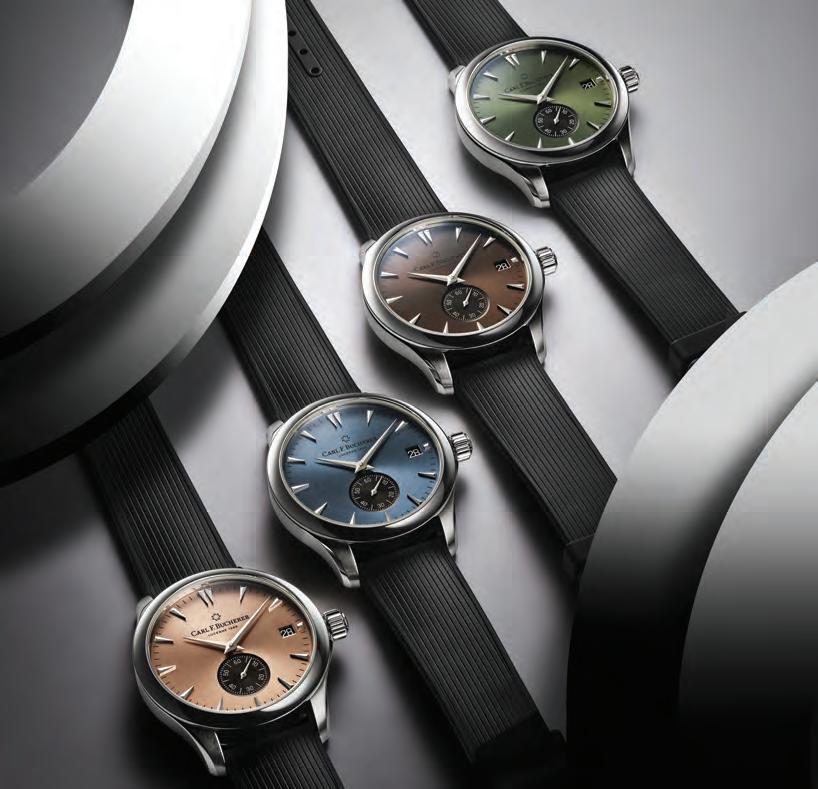
14
Then there’s Jaeger-LeCoultre’s Polaris, named by a US sales agent after another, more potent, weapon of war
THIS YEAR, CARL F. BUCHERER REVEALED THE MANERO PERIPHERAL (ABOVE), WHILE TUDOR PRESENTED THE NEW BLACK BAY 'BURGUNDY' (BELOW)
“We very much start with the movement, and use its three digits as a code name for the project, until some kind of cool nickname starts to emerge,” explains Lionel Favre, Jaeger-LeCoultre’s Product Design Director. “That then becomes the nickname for the project. With the Polaris line, the initial name, E859, was thought to be too simple. An agent in the States wanted to find something that would highlight the innovative spirit of this diving alarm watch.”
On the subject of underwater watches, not only does Blancpain’s Fifty Fathoms enjoy the kudos of being the world’s first bona fide dive watch – that is to say, a watch designed with the explicit purpose of exploring the depths of the oceans – it also makes a pretty strong claim for being the most emotively-named of any dive watch.
On the surface (ahem) ‘Fifty Fathoms’ is a reference to the depth to which divers could safely descend at the time of the watch’s conception in 1953 (around 91 metres). However, Shakespeare fans might also appreciate Blancpain’s nod to a grisly line from The Tempest. ‘Full fathom five, thy father lies,’ says Ariel, revealing to Prince Ferdinand that his father, the King of Naples, has gone down with a shipwreck (a slightly ominous reference for a dive watch, you might say).
What of Tudor’s big hit, the Black Bay? The name was given simply to conjure up the idea of a remote, exotic cove of the kind that might, says the company, feature in Pirates of the Caribbean . If that sounds a rather haphazard way of naming a watch, especially in today’s era of think tanks and consumer focus groups, haphazard is still more the norm than the exception. External agencies of the kind that now specialise in naming products remain, largely, unused in the watch industry. For Zenith, the name of a new watch is ultimately chosen by a committee of six, comprising CEO Julien Tornare and the heads of the company’s five main divisions.
“Good names, the options we really consider, can come from anywhere,” says Zenith’s Marietta. “We try to be honest in our opinions. It’s like being presented with a new design. We try to avoid saying out loud if we really hate it – we’re Swiss, after all. It can take some time before we’ve agreed on a name. Sometimes the name
only comes very close to the launch.”
One reason that watchmakers tend to return to their historic names – as Zenith did in 2009 with the Defy, a moniker first used in the 1960s – is that they own the rights to the names, either legally or through usage. Older companies have, of course, built a portfolio of names from which to pick.
Another factor that watchmakers must now consider when christening a new watch is internationality. Watch companies now operate in a global market; a name has to work across multiple languages and cultures. The chosen handle has to be both pronounceable and above local significances or associations. Get the name wrong – by simply giving it a code number, for example – and invariably enthusiastic collectors will choose a nickname among themselves: Seiko, for instance, has seen its watches affectionately dubbed the Tuna Can, Monster, Samurai, Arnie and Turtle.
For those brands that do work on giving their watches interesting and exciting names, the effort can pay off. As with other increasingly specialist, anachronistic products – sports cars spring to mind – the name is often central to the package. In rare cases, the name of a watch can even act as a mononym for an entire brand.
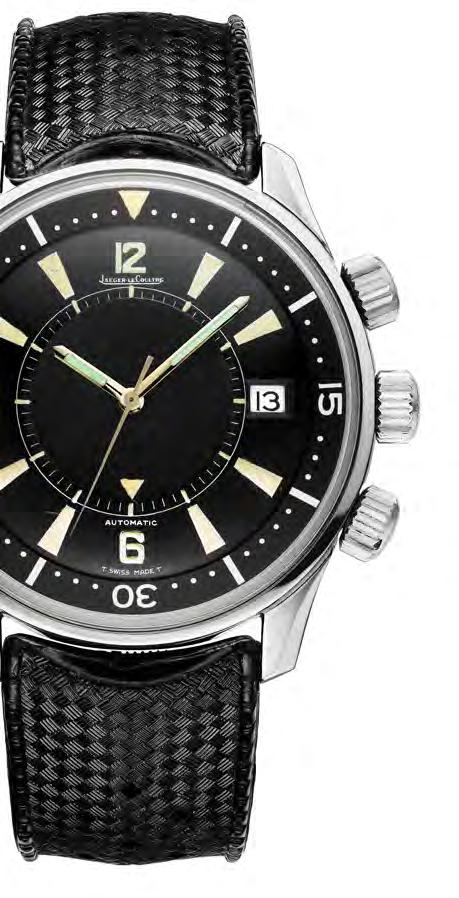
“You don’t want a Rolex Daytona,” says Sadry Keiser, Roger Dubuis’ International Marketing Director. “You just want a Daytona. Smart companies find ways of building on the brand equity that can develop in a name – and, from a marketing perspective, that’s genius if you can pull it off.”
Of course, Keiser adds, there are great watches with not-so-great names. “But you have to remember that the watch industry has historically been about working with a product that’s very tangible. Watches are solid things. And the industry isn’t always so good at all the soft, marketing-oriented things like names. There’s a habit of falling back on historic names and using variations of those over and over. But not giving consideration to a name is to lose out on an element that can further make a watch alluring.”
It’s far easier to remember a face than a name, of course. But how much more exciting is it to show someone your Manero rather than your E859?
15 WATCHES AND JEWELLERY 2023
A VINTAGE JAEGER-LECOULTRE POLARIS FROM 1968
What of Tudor’s big hit, the Black Bay? The name was given simply to conjure up the idea of a remote, exotic cove of the kind that might, says the company, feature in Pirates of the Caribbean
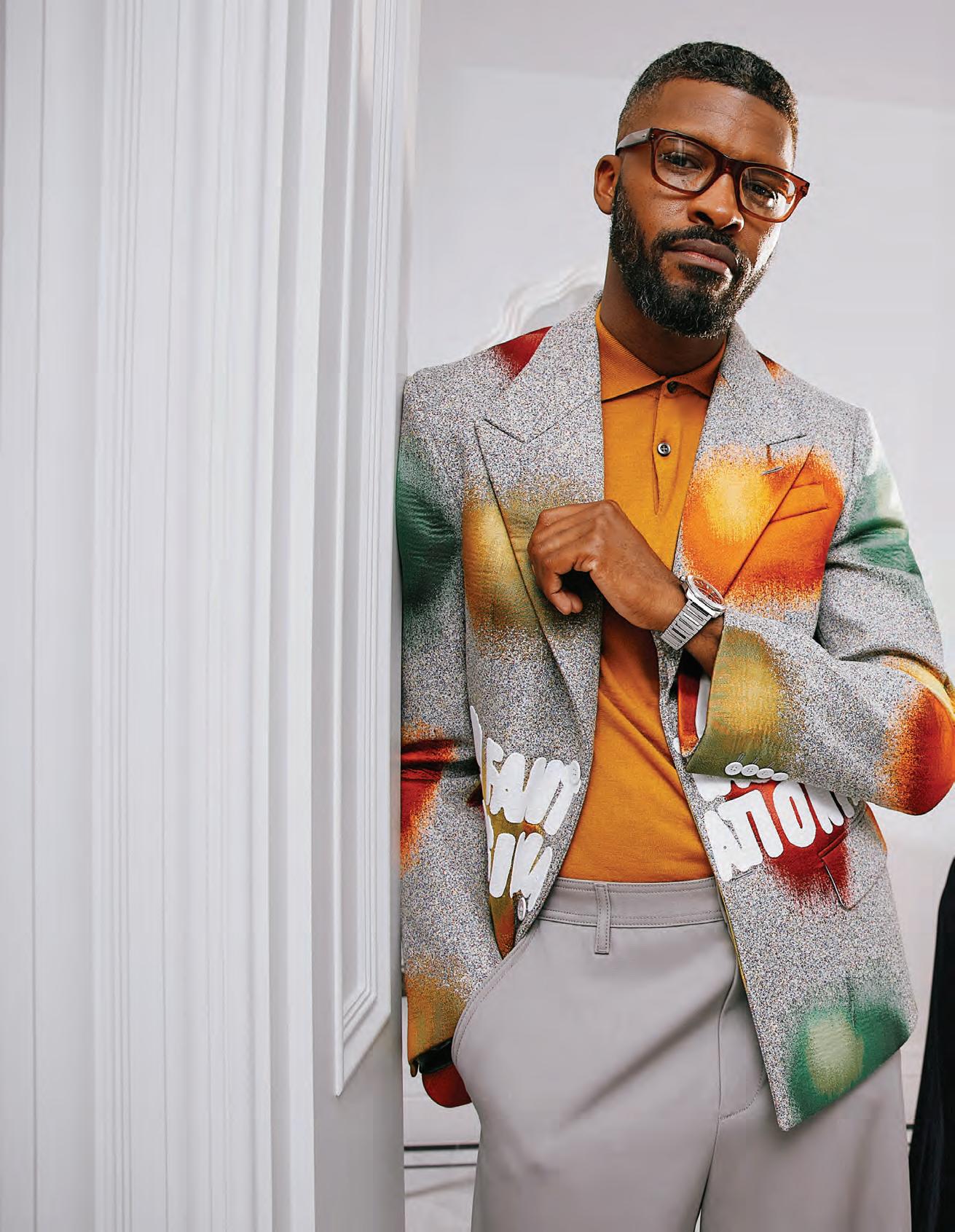
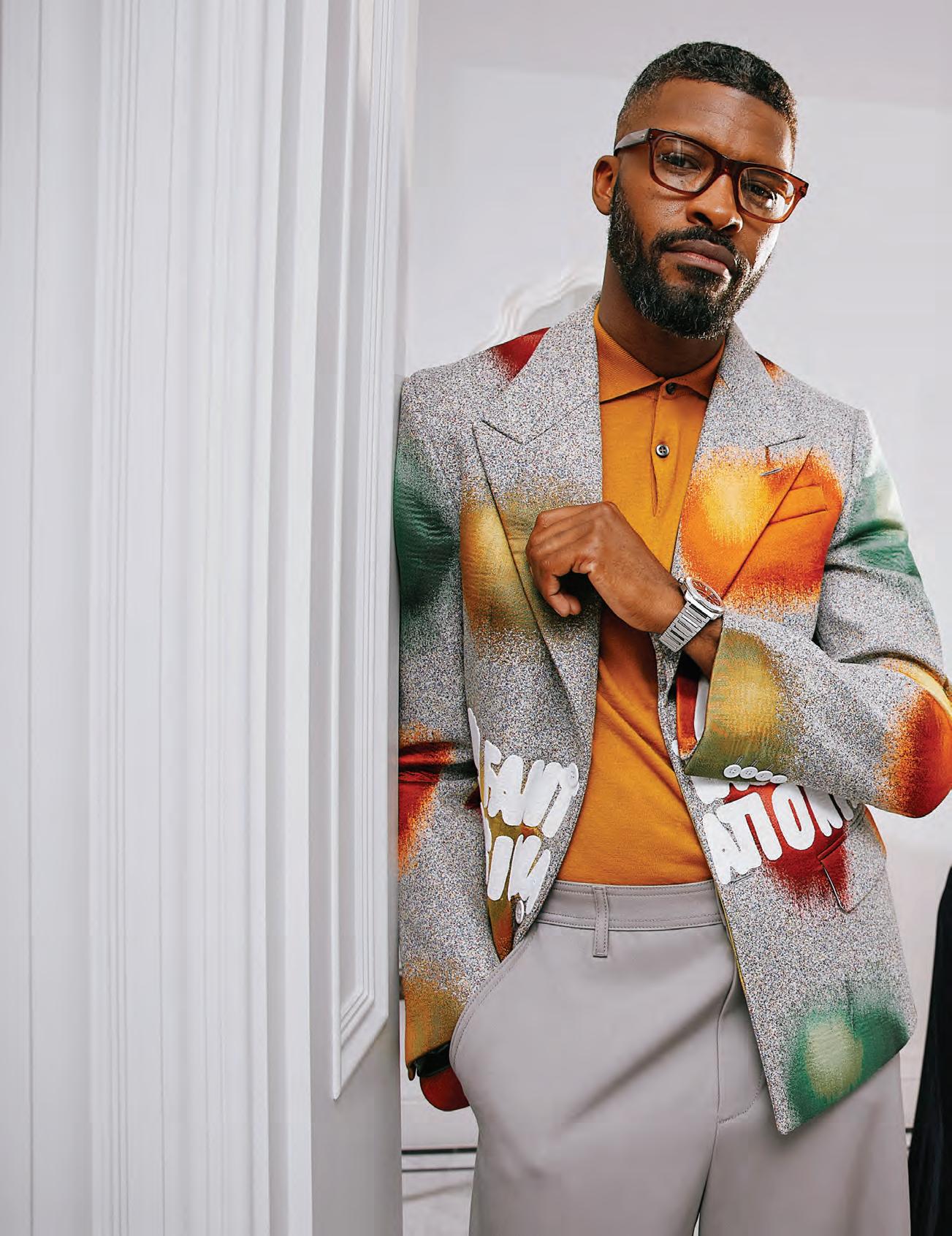
House of H AUTE couture
 PHOTOGRAPHER ADAM FUSSELL STYLIST SARAH ANN MURRAY
PHOTOGRAPHER ADAM FUSSELL STYLIST SARAH ANN MURRAY
PREVIOUS PAGE
RAASHID WEARS:
BLURRY APPLES SINGLE BLASTED CLASSIC PLASTRON JACKET, £5,750, WORKWEAR CUFFED TROUSERS, £1,030, BOTH LOUIS VUITTON, LOUISVUITTON.COM
OCTA ROMA WATCH, £6,800, BULGARI, BULGARI.COM
HERITAGE SQUARE FRAME
PHOTOCHROMIC SUNGLASSES, £385, DUNHILL, DUNHILL.COM
MADDY WEARS: BLACK AND GOLD DRESS, £3,300, AZZI & OSTA, AZZIANDOSTA.COM
YSSO X DANIELLE COPPERMAN
RECYCLED GOLD PLATED BRONZE
BAIE BANGLE, £190, RECYCLED 18CT GOLD PLATED ALCYONE RING, £260, RECYCLED 18CT GOLD PLATED BRONZE BROKEN SHELL EARRINGS, £310, ALL YSSO, THEYSSO.COM
THE DIAMOND WAVE RING, £7,000
DODOLA DIAMOND PINKIE RING, £1,750 BOTH LYLIE JEWELLERY, LYLIES.COM
THIS PAGE
RAASHID WEARS:
BLUE WOOL SUIT, £1,660
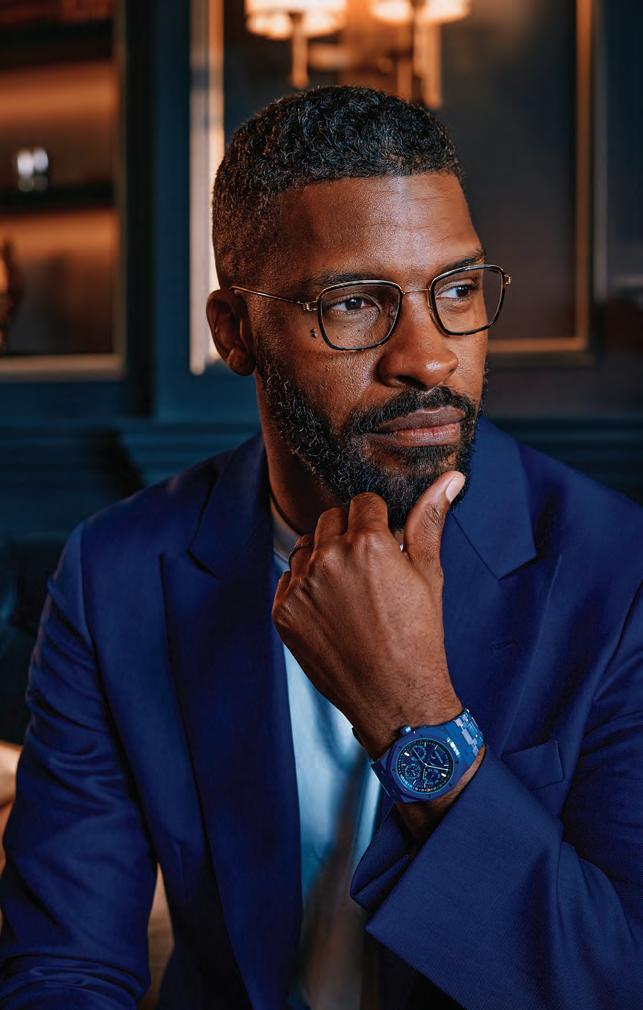
PAUL SMITH, PAULSMITH.COM
WHITE T-SHIRT, £110, SUNSPEL, SUNSPEL.COM
ROYAL OAK PERPETUAL
CALENDAR IN BLUE CERAMIC, APPROX. £120,000 (EXCL. VAT), AUDEMARS PIGUET, AUDEMARSPIGUET.COM
TITANIUM SUNGLASSES, £375, LINDBERG, LINBERG.COM
MADDY WEARS: BLUE VELVET ROLL-NECK, £250, BLUE TROUSERS, £310, BOTH PAUL SMITH, PAULSMITH.COM

LITTLE VELVET BAG, £79, HOME OF HAI, HOMEOFHAI.COM
OLYMPIA BRACELET, POA
OLYMPIA NECKLACE, POA
LADY ARPELS DAY AND NIGHT
WATCH, POA, PALMYRE EARRINGS, POA, ALL VAN CLEEF & ARPELS, VCA.COM
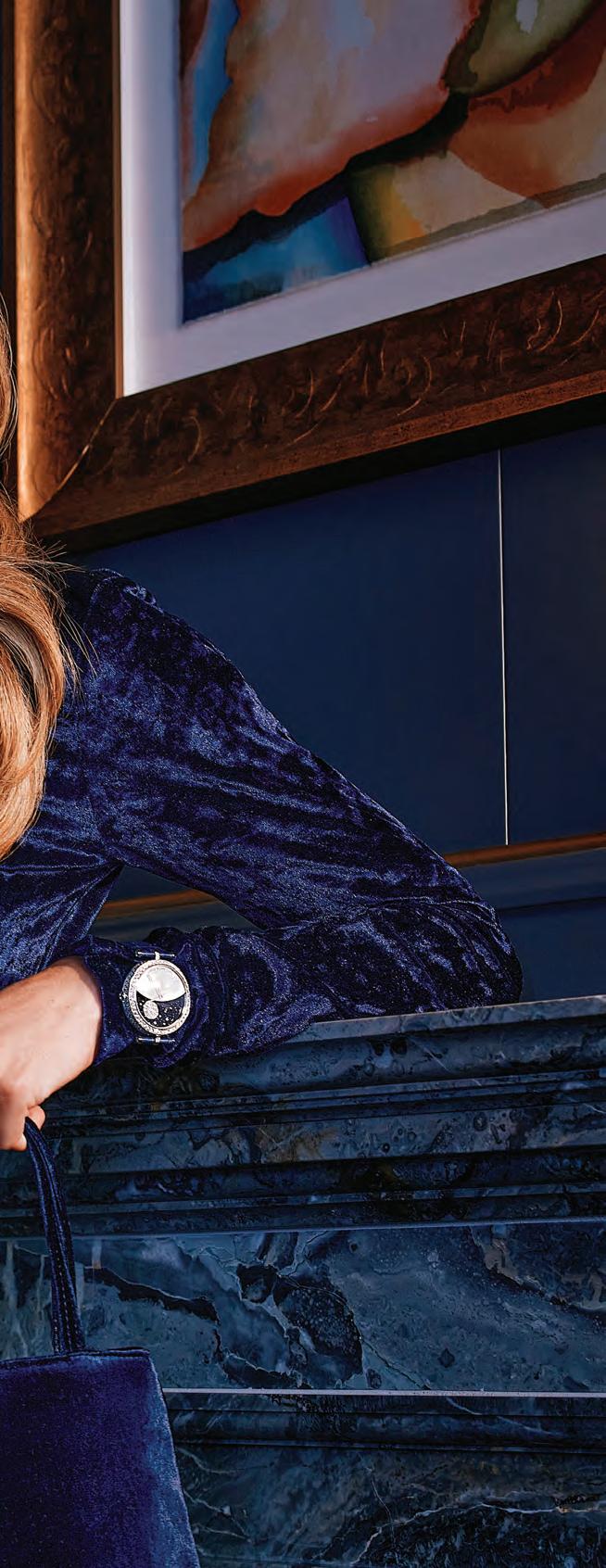
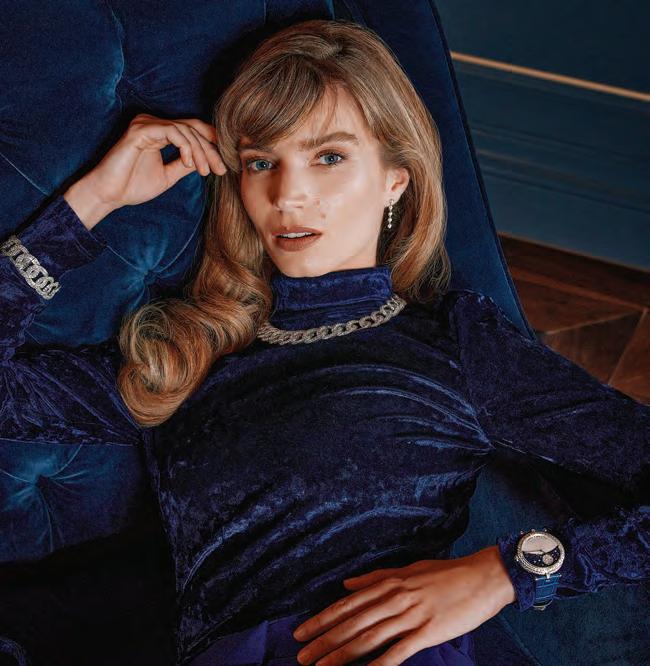

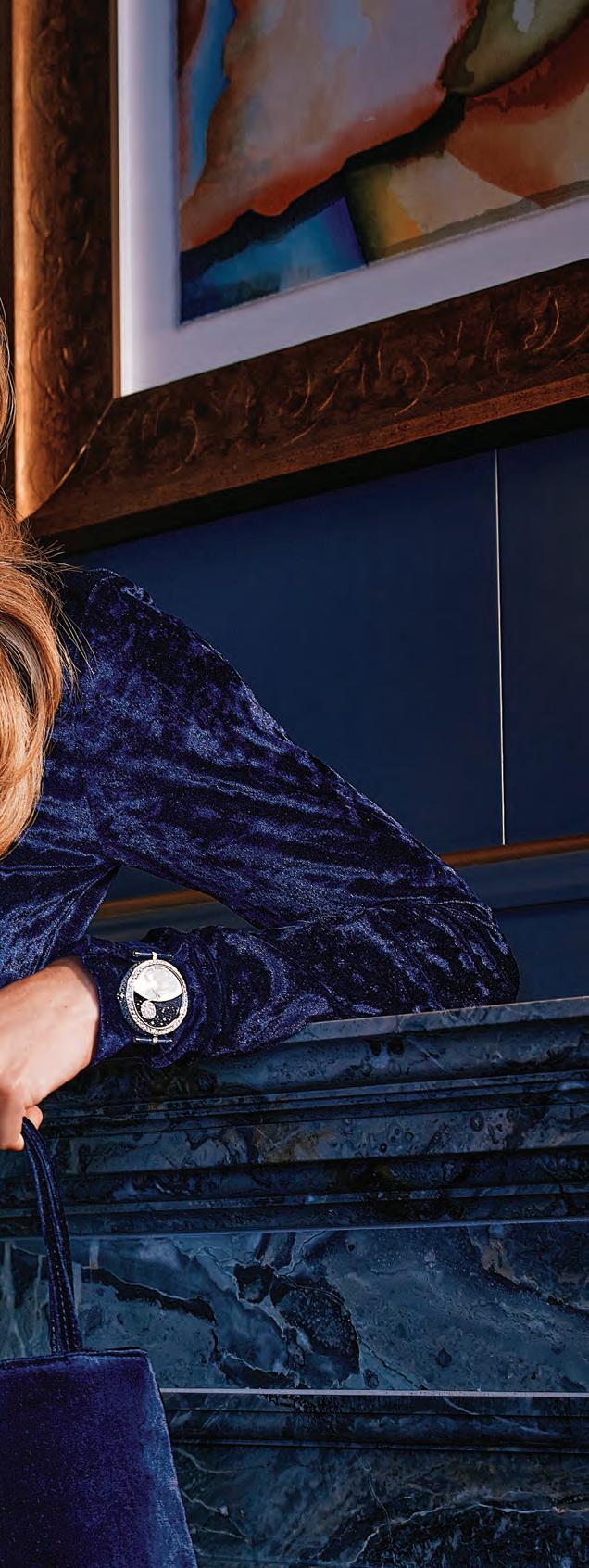


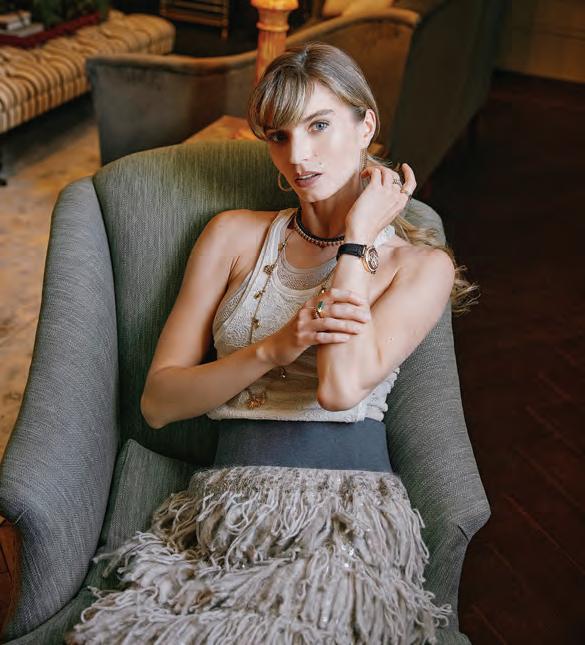

MADDY WEARS: FRINGE MIDI SKIRT, £6,900 DOUBLE-BREASTED BLAZER, £3,150, BOTH BRUNELLO CUCINELLI, BRUNELLOCUCINELLI.COM KNITTED VEST, POA, FENDI, FENDI.COM CLASH DE CARTIER EARRINGS, £8,100, CLASH DE CARTIER RING, £11,700, LOVE RING, £1,860 CLASH DE CARTIER NECKLACE, £84,000, GRAIN DE CAFÉ NECKLACE, £47,800, PASHA DE CARTIER WATCH, £30,400, LES BERLINGOTS DE CARTIER RING, £5,500, CLASH DE CARTIER RING, £3,300, ALL CARTIER, CARTIER.COM
RAASHID WEARS: VELVET BLAZER, £895 VELVET TROUSERS, £395 CHECK SHIRT, £250, ALL RICHARD JAMES, RICHARD-JAMES.COM TANK LOUIS WATCH, £13,000 JUSTE UN CLOU RING, £2,550, BOTH CARTIER, CARTIER.COM
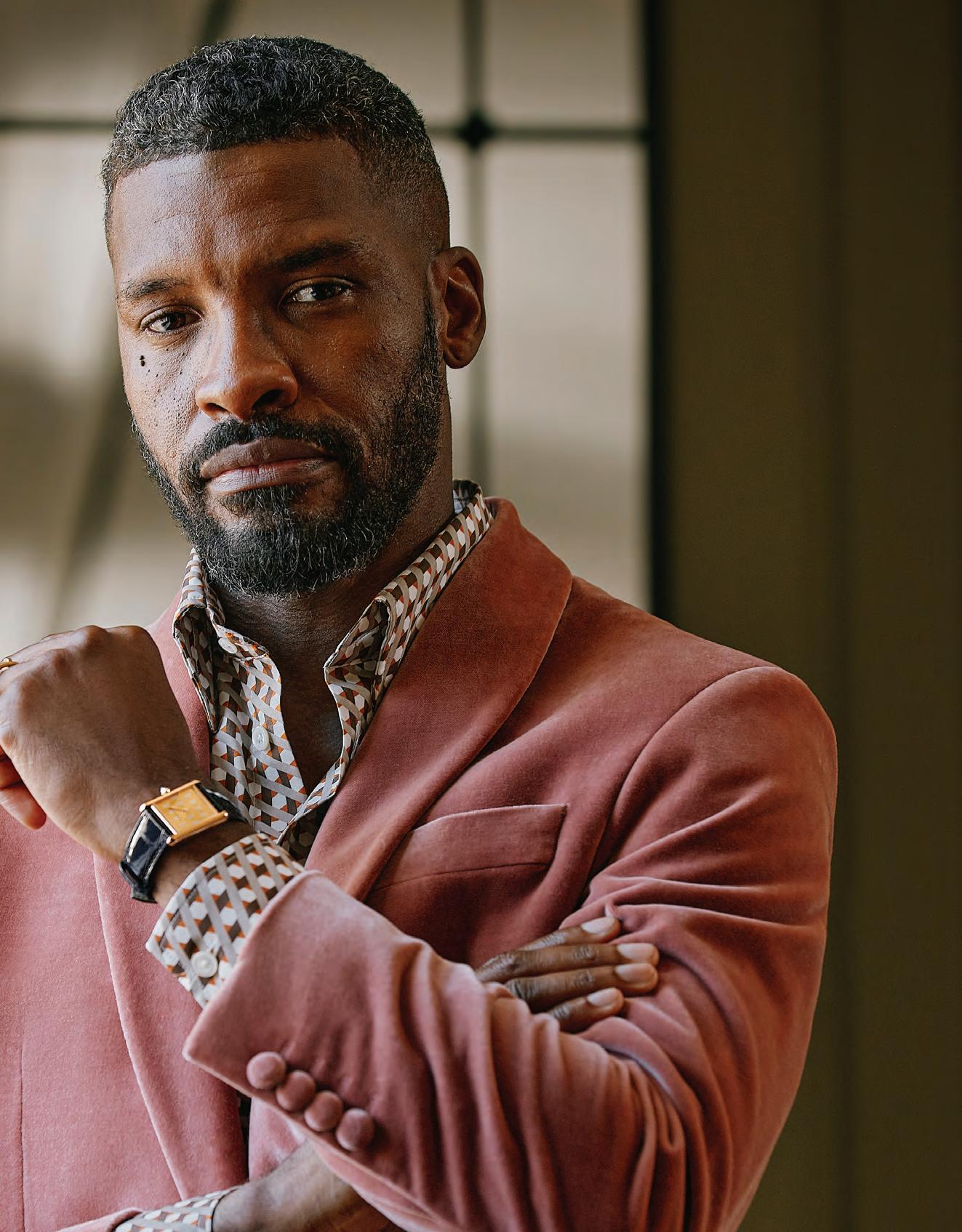
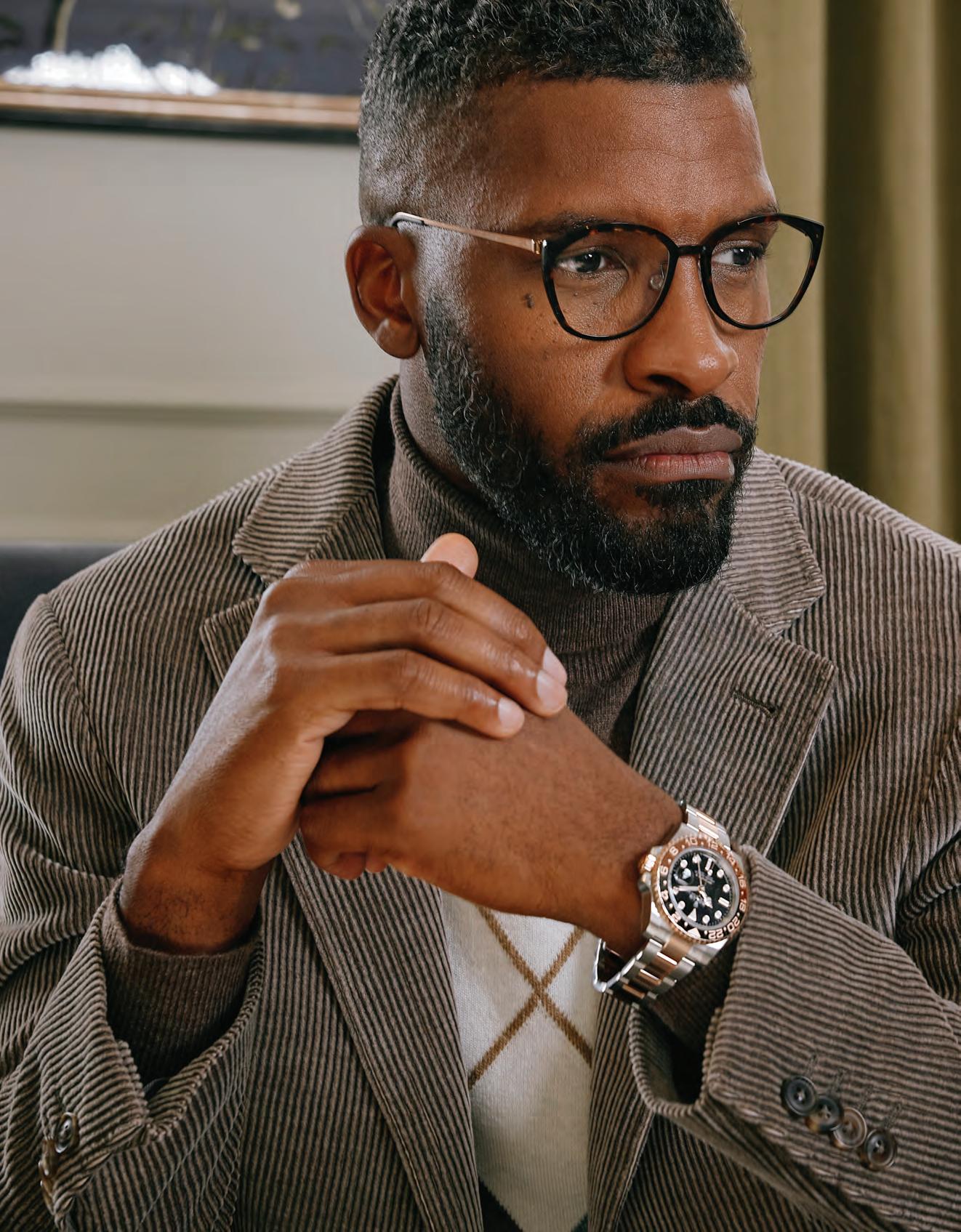
RAASHID WEARS: CORDUROY SUIT AND ROLLNECK, JACKET, £1,990, TURTLENECK, £675, TROUSERS, £850, ALL CANALI, CANALI.COM


GMT MASTER II, £13,600, ROLEX, ROLEX.COM
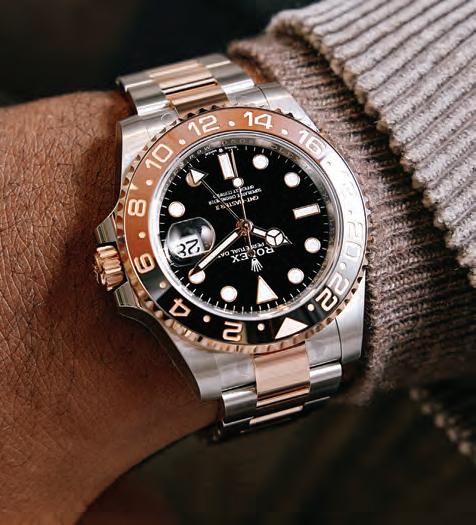
TITANIUM SUNGLASSES, £375, LINDBERG, LINBERG.COM
MADDY WEARS: WOOL CREPE JACKET, £1,645
WOOL TRENCH TUXEDO

TROUSER, £1,090, COTTON PIQUE WAISTCOAT, £1,090, ALL RALPH LAUREN, RALPHLAUREN.CO.UK & SELECT STORES
ROSE DIOR BAGATELLE
BRACELET, POA, ROSE DIOR
BAGATELLE EARRING, £12,300 (SOLD SEPARATELY), ROSE DIOR BAGATELLE NECKLACE, POA ROSE DIOR BAGATELLE RING, £21,400, ALL DIOR JOAILLERIE, DIOR.COM
RAASHID WEARS:
MUSTARD BROWN JACKET, POA, SILK SCARF, £75, BOTH ANDERSON & SHEPPARD, ANDERSON-SHEPPARD.CO.UK
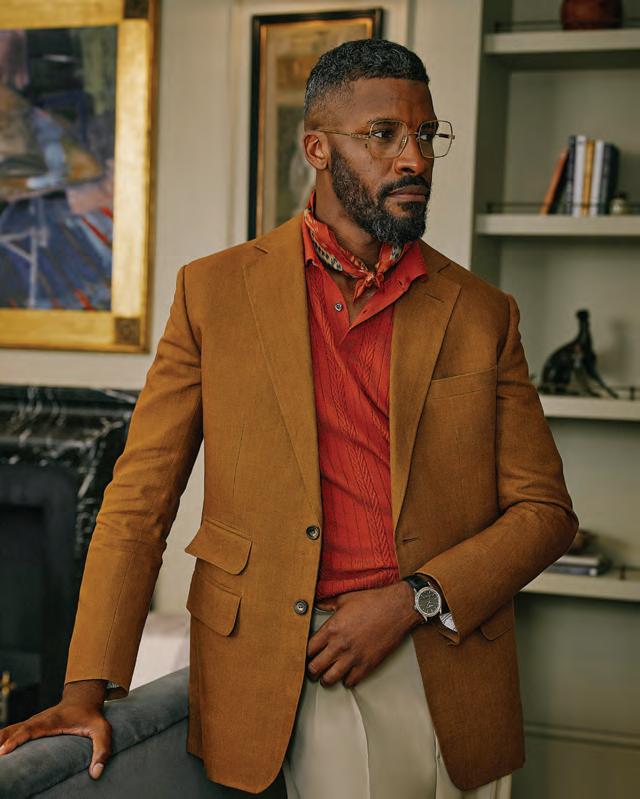
HOFFMAN MARINO WOOL POLO SHIRT, £190, JOHN SMEDLEY, JOHNSMEDLEY.COM
TWILL CHINO TROUSERS, £245, AMI PARIS, AMIPARIS.COM
PATEK PHILIPPE MEN’S CALATRAVA, £25,720, WATCHES OF SWITZERLAND, WATCHES-OF-SWITZERLAND.CO.UK
SQUARE OPTICAL FRAME GLASSES, £340, GUCCI, GUCCI.COM

MADDY WEARS:
LONG PAISLEY SABLE DRESS, £3,240, ETRO, ETRO.COM

NUDO PENDANT EARRINGS, £5,900
NECKLACE NUDO, £2,250, SABBIA NECKLACE, £50,450, ALL POMELLATO, POMELLATO.COM
RED POPPY RING, POA, MÉDINA BRACELET, POA, BOTH VAN CLEEF & ARPELS, VCA.COM
PATEK PHILIPPE LADIES’ TWENTY~4 AUTOMATIC, £40,950, WATCHES OF SWITZERLAND, WATCHES-OF-SWITZERLAND.CO.UK
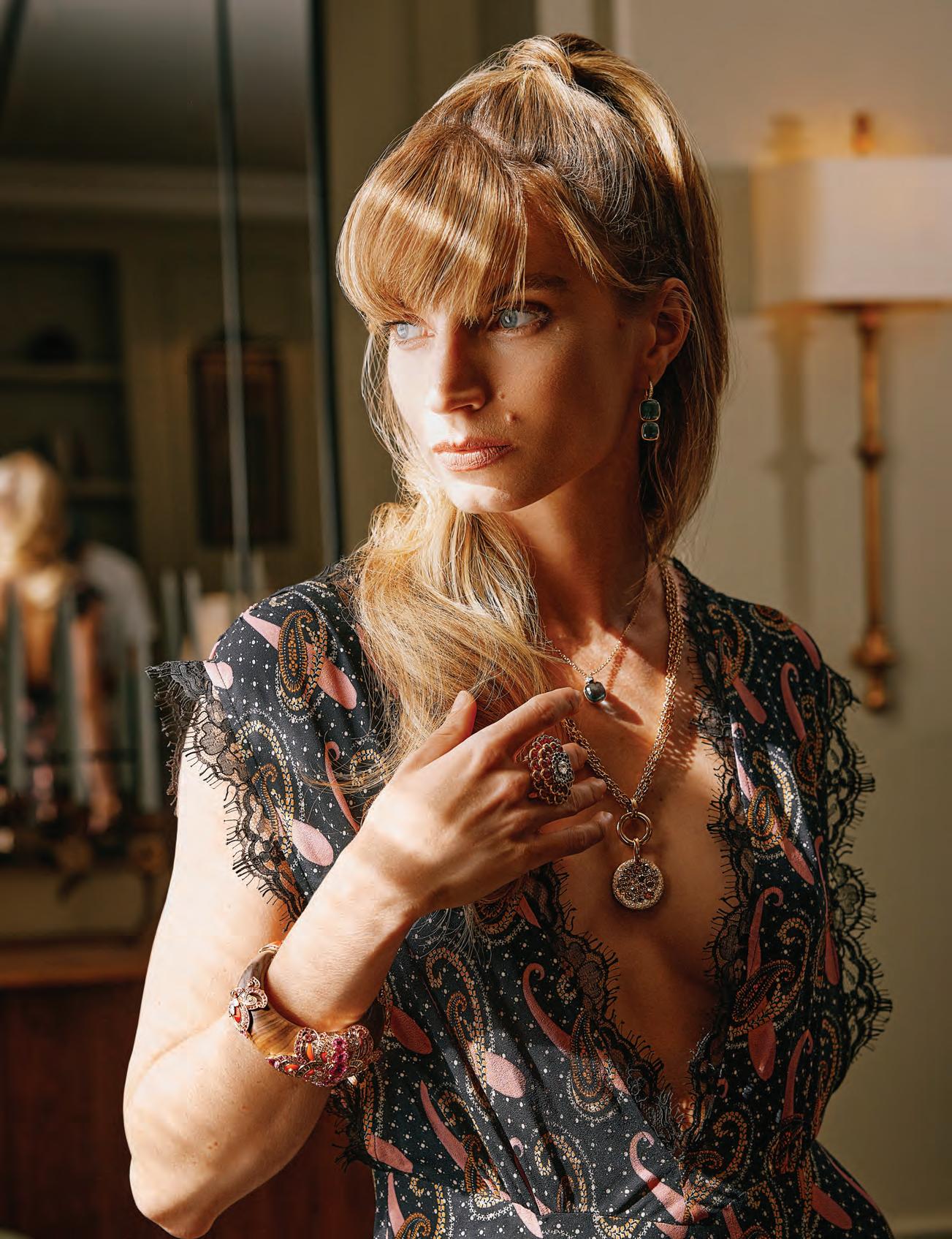
MADDY WEARS:
DUCHESS SATIN DRESS, £2,650, FENDI, FENDI.COM

HEADBAND, POA, ROGER VIVIER, ROGERVIVIER.COM
SILVER CURB CHAIN, £210, SILVER AND GOLD LOCK, £5,000, BOTH MARLA AARON, MARLAAARON.COM
RAASHID WEARS:
RED SILK JACKET, £3,090
BLACK TROUSERS, £1150
BLACK SHIRT, £480, ALL
ALEXANDER MCQUEEN, ALEXANDERMCQUEEN.COM
WITH THANKS TO RAASHID HOOKS
@MODELS1
MADDY TAYLOR
@PREMIER
ASSISTANT STYLIST
BETHANY PARKINSON
MAKEUP
MARIO BROOKSBANK
HAIR
NARAD KUTOWAROO
SHOT ON LOCATION
THE OWO RESIDENCES BY RAFFLES, RESIDENCES FROM £4,000,000, FOR MORE INFORMATION CONTACT
IAN PIDGEON ON +44 (0) 20 7409 8756, SAVILLS.COM
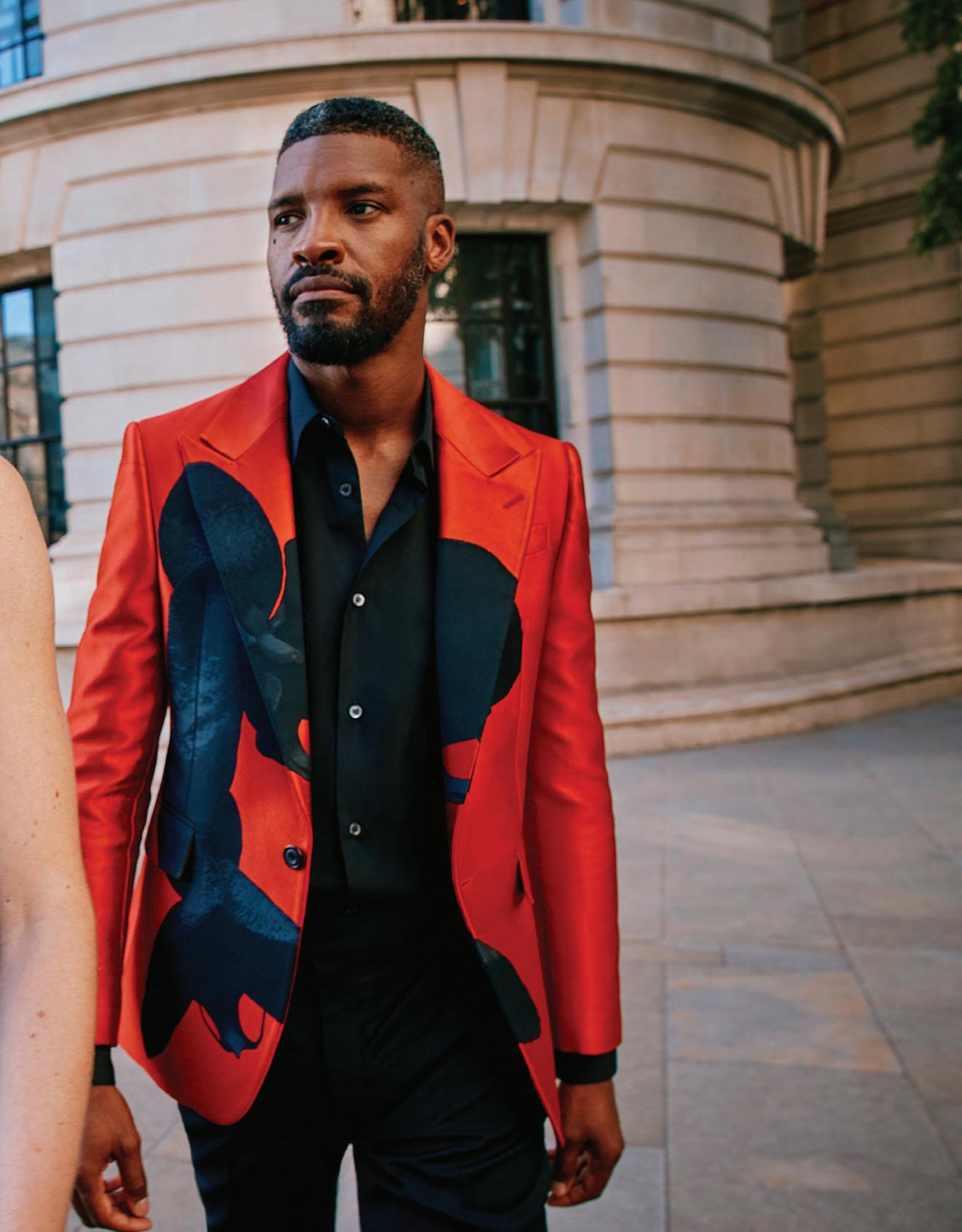
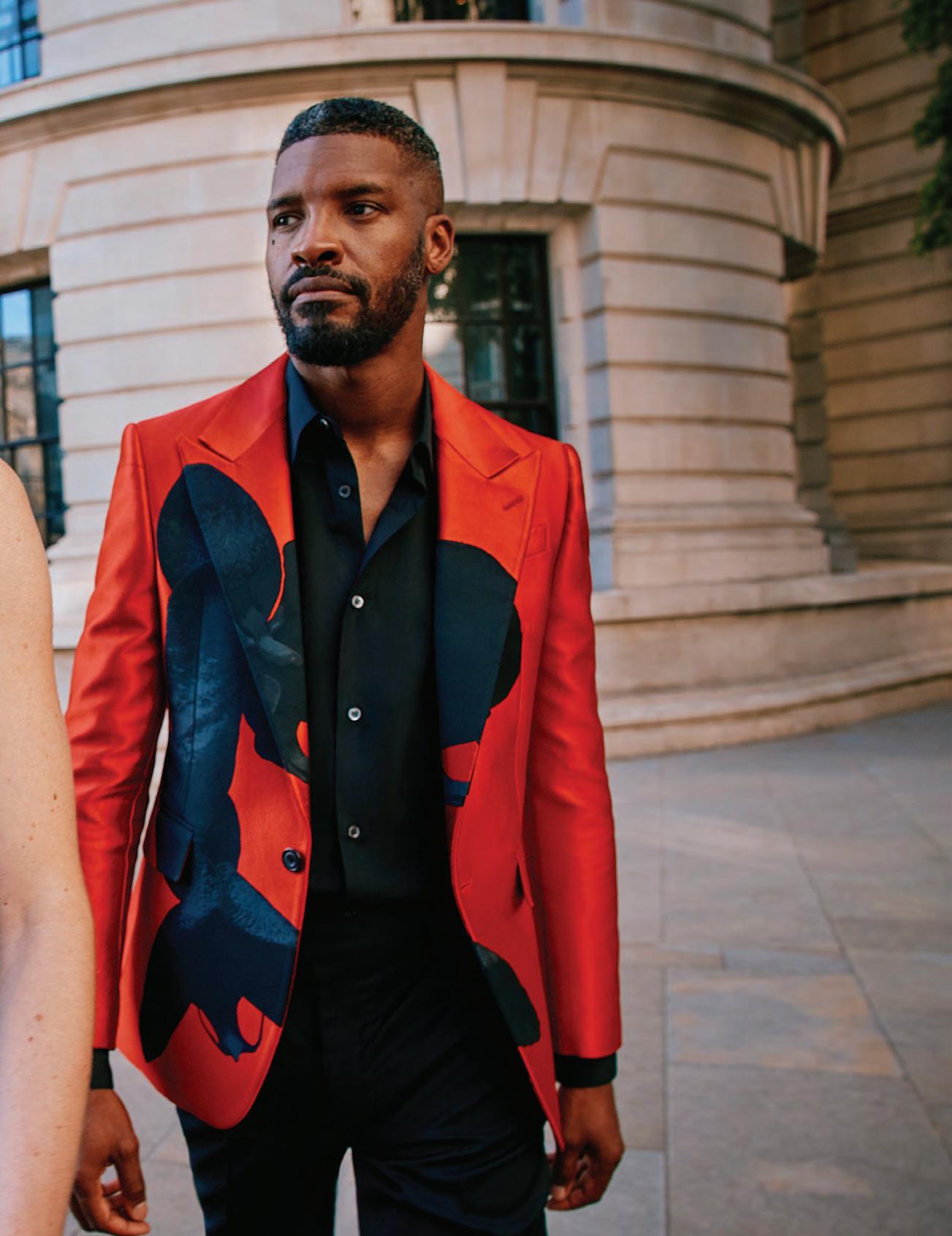
“I wanted to cover women in constellations,” said Gabrielle Chanel in 1932 – and this is just what the jewellery house's Comète collection does. Delicate star motifs, punctuated by tiny diamonds, cascade over one another, giving the impression of a ‘shower of stars’. These are released in conjunction with the Camelia collection, which does the same thing but with intricate flower charms. The layers of the camellia flower lend themselves to jewellery, and the pieces are truly beautiful.
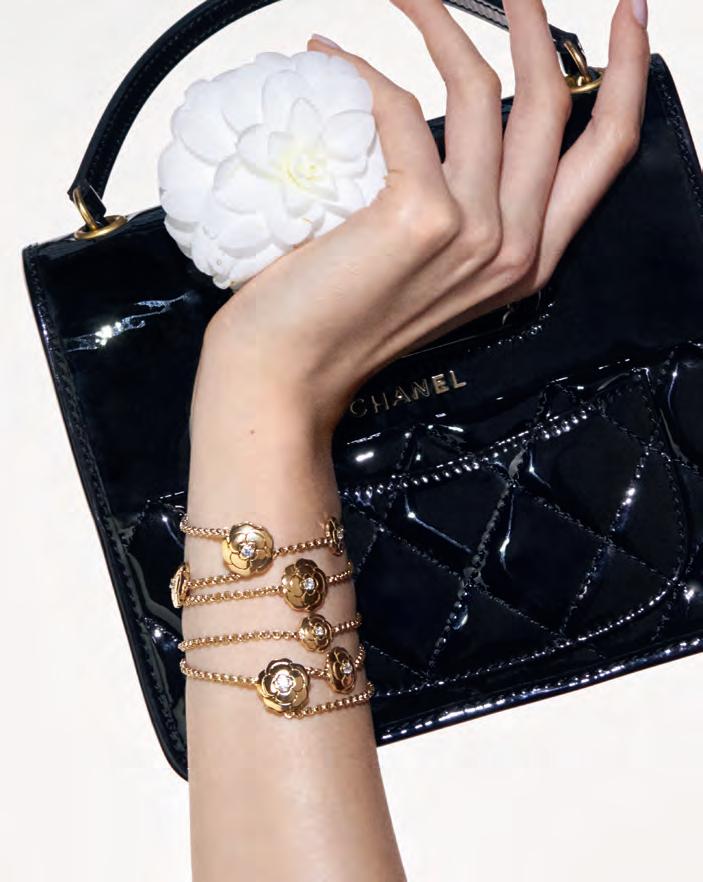
chanel.com
Jewellery
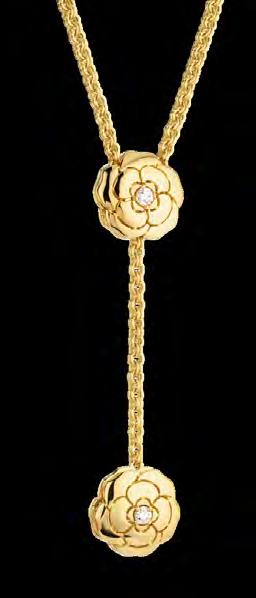 Words: Anna Solomon
Words: Anna Solomon
news
THE MOST DAZZLING HIGH JEWELLERY COLLECTIONS OF THE YEAR SO FAR


TASAKI
ATELIER 6
The Japanese maison introduces Atelier 6, a collection that takes its inspiration from nature and all its diverse forms. The six minicollections within the line explore different phenomena of the natural world: Flourish, Cascade, Swirl, Ocean Light, Splendour and Aurora. The expression of each is captivating, setting the scene for stones as clear as lagoons and as vibrant as the sun. Expect colours of the ocean, rainforest, the night sky, and shapes like those created by water, wind and light.
tasaki-global.com
CARTIER

LOVE COLLCETION
Cartier’s iconic Love collection is an ode to 1970s New York as the capital of free-spirited love – both in the line's urban, pared-back design, and also symbolically: the binding closure and screw motif say permanence, while interpretations of the design represent a unique expression of feeling. The maison recently unveiled a new twist on the Love bracelet, now created with a brushed-gold finish.
cartier.com

28
GEMFIELDS X FABERGÉ
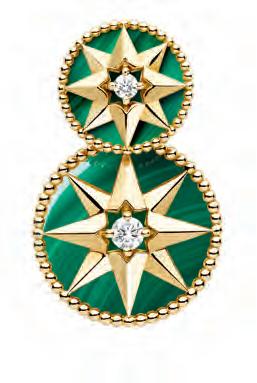
COLOURS OF LOVE
Fabergé recently partnered with colouredstone specialist, Gemfields, to create a line of bracelets, necklaces, rings and more in a spectrum of joyful hues. Pictured is the latest addition, the Rose Gold Rainbow Fluted Choker Necklace.
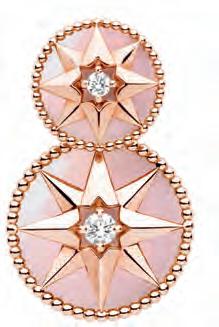

gemfields.com
DIOR
ROSE DES VENTS DE BEERS
De Beers’ genderless RVL collection was a marked departure from usual business, most significantly for the absence of diamonds. In their place: bold silhouettes and androgynous shapes. But look closely, and those De Beers hallmarks are there: the all-important clear gem is nestled into the design, and the company monogram is imprinted into the metal.
debeers.com
SOUL RINGS
With its collection of Soul Rings, Italian fine jeweller FOPE is proposing that the exchange of rings doesn’t have to be reserved for engaged or married couples. The jewellery piece is perhaps the one most associated with love, but, FOPE asks, what sort of love? Why not friendship, a child-parent bond, or any other sacred relationship? The collection is available in white, yellow, or rose gold, and each ring is set with a single precious stone: a pink or blue sapphire, a ruby, an emerald, a black diamond, or a white diamond.
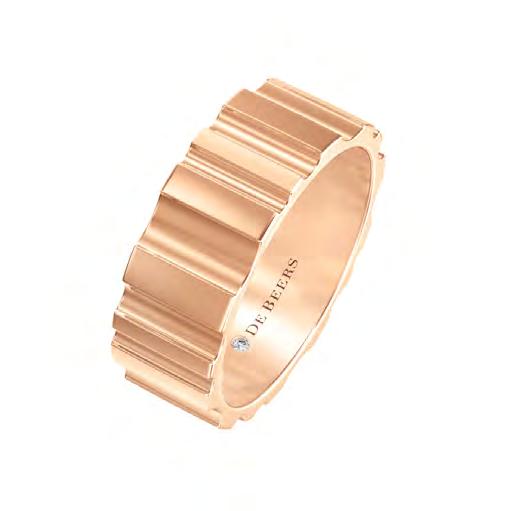
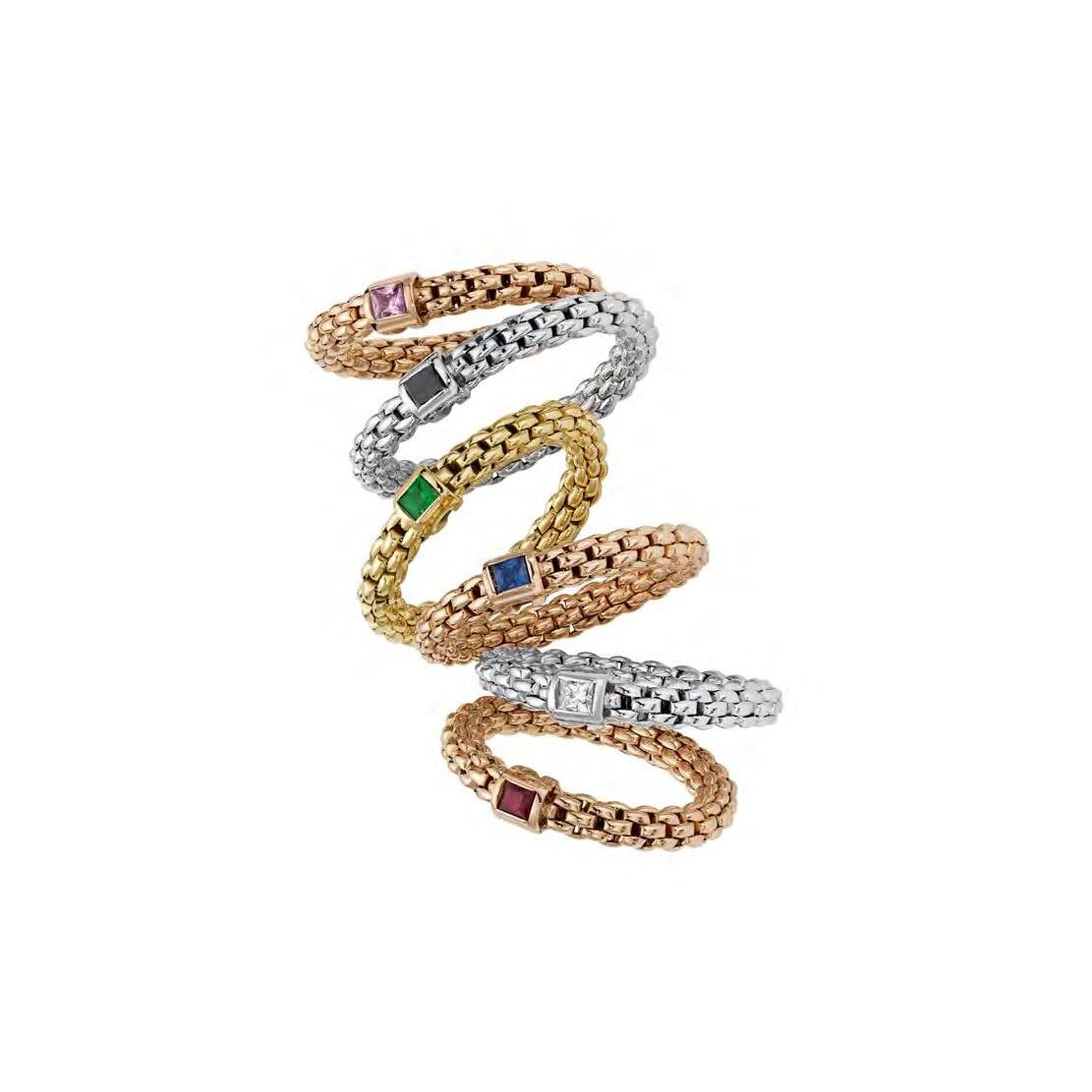
fope.com
The Rose des Vents collection is a modern reinterpretation of the timeless Tribales earrings from Dior – tribal-inspired, asymmetric pieces cast in matte colours with set stones and pearlised finishes. Now, the style is enriched with new models that combine a pastille adorned with a compass rose with a reversible motif composed of either ornamental stones or pavé diamonds. The pieces can be worn alone or together, matching or asymmetrical, and paired with the collection’s choker or open rings. Mix and match as you see fit.
dior.com

WATCHES AND JEWELLERY 2023
RVL COLLECTION
Charles Negre
THE CEO INTERVIEW
JOANNE MILNER, GARRARD

AS THE HEAD OF GARRARD, JOANNE MILNER OVERSEES A COMPANY WITH ALMOST 300 YEARS OF HISTORY; A COMPANY THAT PIONEERED THE CONCEPT OF MODERN JEWELLERY AND ACTED AS THE OFFICIAL CROWN JEWELLER FROM 1843 UNTIL 2007. A FAR CRY, THEN, FROM MILNER’S PREVIOUS ROLE IN CORPORATE FINANCE...
Words: Zoe Gunn
ith a career that’s seen her navigate the hard-nosed worlds of corporate finance and private equity before rising to the highest echelons of the luxury jewellery industry, it would, on paper, be easy to characterise Joanne Milner, CEO of British fine jewellery brand Garrard, as a single-minded, success-at-all-costs businesswoman. Which, I can confidently say after our interview, couldn’t be further from the truth. Yes, Milner is enormously successful, but her achievements have never come at the sacrifice of others – or herself.
Despite heading up one of the most prestigious names in luxury, a company that dates back to 1735 and which was responsible for the upkeep of the British Crown Jewels until 2007, Milner attributes her success to the strength of the team around her. “I think that’s part of why everyone enjoys working at Garrard so much – because every member of the team knows how much they’re valued and what they bring to the organisation.”
Milner’s greatest career highlight, she says, is not an award or promotion or successful advertising campaign, but a letter from an employee she barely knew. It thanked Milner for the way she had guided Garrard through the Covid-19 crisis.
“It’s very rare to receive feedback. The higher you are in an organisation, the less feedback you get. The feedback you do get is just people saying what you want to hear. This was something out of the blue and it came from somebody I wasn’t expecting it from. It really meant a lot.”
If Milner has a personal trait that’s served her particularly well, it is, she muses, her ability to remain entirely herself, despite the prejudices or expectations of others. “I never wanted to be one of the lads,” she says of her early corporate experiences. “I wanted to be who I am, which is feminine. You can be that and still be very good at your job and a good leader.”
Here, Milner talks about the advantages of not thinking too far ahead, the difficulties of completely switching off, and why your best ideas will often strike when you least expect it.
Before you went into corporate finance you studied law. Was that a conscious decision? I didn’t have a specific career path in mind. Growing up I went to my local comprehensive school, I didn’t have a wide network of people and, because I’m incredibly old, there wasn’t social media. The biggest outlet for seeing the world was television so I wanted to do things that I thought looked exciting. I used to watch all the American law programmes and it looked very inciting; they were having a great time and going to these sophisticated bars after work. I thought that was quite cool so I decided to study law.
I would say to anybody that you don’t have to decide what you want to do in 20 years’ time. Just decide what you want to do today. What do you think are the most exciting opportunities in front of you? Don’t try and think too far in advance because, actually, life changes in so many different ways.
What were the hardest challenges you faced at the beginning of your career?
I started with no network of my own. A lot of people in that industry had parents, friends of parents, that worked in the industry and I didn’t have that. I was starting from scratch in an industry where nearly everybody had studied accountancy and I’d studied law. It was also a very male-heavy environment and there were very few female role models. The main challenge was trying to make sure you were taken seriously and that you weren’t overlooked. I think I was probably very focused on doing the right thing and trying to please everybody.
How has the working landscape changed since you started your career?
I think there are more women in senior roles so there are better role models. I also think there’s an understanding of a different skill set. When I started, there was one set of parameters for what people thought made a good leader and that didn’t necessarily fit naturally with the strengths that women brought.
I remember reading an article on the idea of the glass ceiling and there was
W31 WATCHES AND JEWELLERY 2023
a study where men and women had been told to react to an issue in exactly the same way. They said the same words, in the same way, and the outcome from the study group was that the women were harsher and not as fair.
There was a subconscious expectation that women are more caring. I actually think that, in the right way, men have been allowed to become more caring as well. The stereotypes of both genders have changed so much in the past 20 years.
What specific skills or attributes have helped you in business? I don’t try to be the brand. For the brand to be successful, the business has to be successful, and often people are very loyal to the brand, but not necessarily loyal to the business. I’ve always been able to balance that line. There are decisions you could make that might be very good for the business today, but would not be good for the brand in the long term, so it’s always a balancing act.
Me not being too involved in the jewellery industry was positive in a way. I could see things with fresh eyes. I wasn’t ingrained in all the ‘That’s just how we do it.’ I could say, ‘Oh, so why did we do it that way?’ And sometimes it’s because it’s the right way to do it, and sometimes it’s because there’s never been anything different.

How difficult was swapping private equity for high-end jewellery? As soon as I started, I took a gemmology course, but you have to respect that there are people who know more than you. To be successful, you need to surround yourself with the very best people and, actually, it helps to not even remotely pretend to know what they


know. I have the best team around me. They teach me about stones, about jewellery, about the industry, and what I bring they don’t have. I understand business. I know how to make businesses successful. It doesn’t really matter what that business is.
What is the most enjoyable aspect of your job? For me, it’s about seeing people really start to believe in themselves. If they believe in themselves, they’re successful. When somebody’s done something for the first time and you can see that it’s a success and you can see them literally grow tall because of it, it’s a really positive thing.
What’s the most difficult part of your job? The worst part of everybody’s job is those horrible decisions that sometimes you have to make in business. I have a huge loyalty to my team but my responsibility is to the business and sometimes the right decision for the business is hard. You have to make decisions you don’t want to make and have conversations you don’t want to have. I always say you know you’ve been in a job too long if that doesn’t bother you anymore. I still have sleepless nights, but I think that it’s good I find it really hard because it shows I still really care.
What do you think makes a good leader?
To have integrity and to be fair. In life you will always gel more with some people than others but, as a leader, you need to take that out of the equation and look at who’s doing the best job and performing well. It doesn’t matter whether you’re particularly close to them. Keeping that separation is key.
How easily do you switch off? You never really switch off. I think one of the things that happens when you get into a position like mine is that you’re not necessarily doing your best work sitting at your desk. You do your best work walking home from work when you’ve got time to think. I do a lot of Pilates and often in the middle of one of those sessions, I’ll figure out a work problem. When you’re trying to switch off is actually often when you have your biggest breakthroughs. The great thing about having a young child is that, when you’re with them, they’re in your face demanding your attention. That is probably the only time when you’re in a different zone.
What advice would offer a young person at the beginning of their career? Understand the business side of a company. I think a lot of people are excited by what a company does or makes, but a business has lots of elements. We still have a finance team, a logistics team, HR. You can’t be successful in the creative side if you don’t understand what makes a business work.
The reason we have a fantastic creative team at Garrard is because the creative director and design director understand how the business works. They know who they’re designing for, they know the signature designs but they also know what the business needs from them. If you can get that combination of being both creative and commercially-minded, you’ll be gold dust.
garrard.com
32
"In life you will always gel more with some people than others but, as a leader, you need to take that out of the equation"
MUSE EARRINGS FROM GARRARD'S 2023 SOMETHING BORROWED RENTAL COLLECTION
A TIARA FROM GARRARD'S 2023 SOMETHING BORROWED RENTAL COLLECTION

DISCOVER MORE AT OUR LONDON FLAGSHIP BOUTIQUE AT 1A OLD BOND STREETfope.com
FOR ITS LATEST HIGH-JEWELLERY OFFERING, HARRY WINSTON TAKES INSPIRATION FROM THE REGAL GEM COLLECTION OF ITS EPONYMOUS FOUNDER
Words: Louise Cook
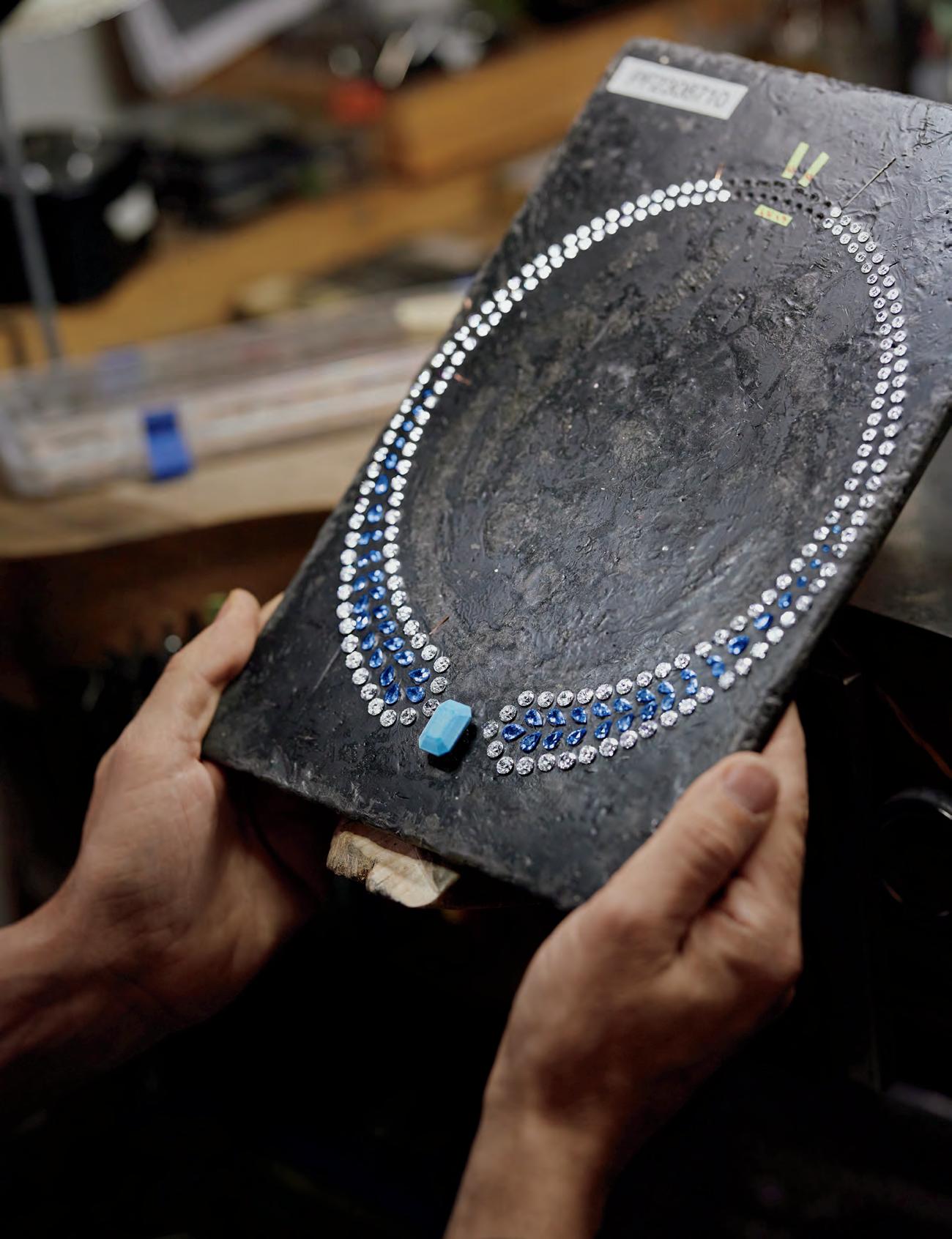
ROYAL CONNECTIONS
THE VISCOUNTESS SUITE PLACES A 25.02 CARAT OCTAGONAL-CUT SAPPHIRE AT THE CENTRE OF A NECKLACE THAT FEATURES AN ADDITIONAL 20.25 CARATS OF ROUND AND PEAR-SHAPED SAPPHIRES
ver since I was young, jewels have fascinated me. I think I must have been born with some knowledge of them.” In 1908, a 12-year-old Harry Winston was browsing a pawn shop when, in a tray of costume jewellery, something caught his eye. Winston picked up the stone and, with a thrill, realised he was holding an emerald. He purchased the piece for 25 cents and, two days later, sold it for $800.
The episode ignited a passion within Winston that would see him amass a collection of gemstones estimated to contain around one third of the world’s most famous precious stones. In 1947, Winston’s legend was sealed when America’s Cosmopolitan magazine described him as ‘King of Diamonds’. By the early 1950s, it was estimated by Life magazine that after the Royal Court of England, Harry Winston’s collection of jewels was the second largest and most important in the world. So, how did the son of Russian Jewish immigrants accrue such a vast and esteemed collection?
After proving he had an eye for spotting profitable jewels, Winston dedicated much of his adult life to scouring the planet for its rarest diamonds. His first major success was a diamond named the Jonker, which, when it was mined in South Africa in 1934, was the fourth-largest uncut gem ever found.
Another significant piece that made it into Winston’s collection was the Idol’s Eye – a blue, 70.21-carat Golconda diamond that was discovered in India in the 17th century before disappearing for almost 300 years. Winston tracked it down shortly after Second World War, after a search that lasted close to a decade.
Additional hero pieces within Winston’s corpus include the Indore Pears, two teardrop-shaped stones originally owned by the Maharaja of Indore and purchased by Winston in 1946; the ‘Catherine the Great’ sapphire, sold by the last Russian Emperor, Czar Nicholas II, to finance a hospital train for the Russian Army during the First World War; and the Westminster Tiara, created in 1930 at the behest of the Duke of Westminster and purchased by Winston in 1959 at Sotheby’s for £110,000 – a price that broke the record for a piece of jewellery sold at auction.
There was one gem, however, that took pride of place among all others: the Hope
Diamond. The size and blue hue of the piece makes it a natural phenomenon – yet it is arguably the diamond’s intriguing backstory that captured the world’s imagination.
Discovered in India earlier in the century, in 1668 the stone was purchased by King Louis XIV of France. The diamond was passed down generations until, in 1792, it was stolen from the French Treasury during the French Revolution. When the Hope Diamond showed up 47 years later, it was sold to British-Dutch gem collector Lord Henry Philip Hope (hence the name), before being purchased by the American socialite Evalyn Walsh McLean. Following her death in 1947, the diamond was put up for sale, with Winston making the successful bid. In 1958, he donated the stone to the Smithsonian Institution.
Of the belief that everyone should be able to experience the world’s greatest gems, in 1949 Winston organised the Court of Jewels, a national travelling exhibition that granted the American public access to the Indore Pears, the Idol’s Eye, the Catherine the Great sapphire and the Hope Diamond.
This year, to celebrate the company’s historic connections with royal families around the world, Harry Winston has created the Royal Adornments collection – a corpus of one-of-a-kind jewellery suites inspired by some of the most famous pieces amassed by

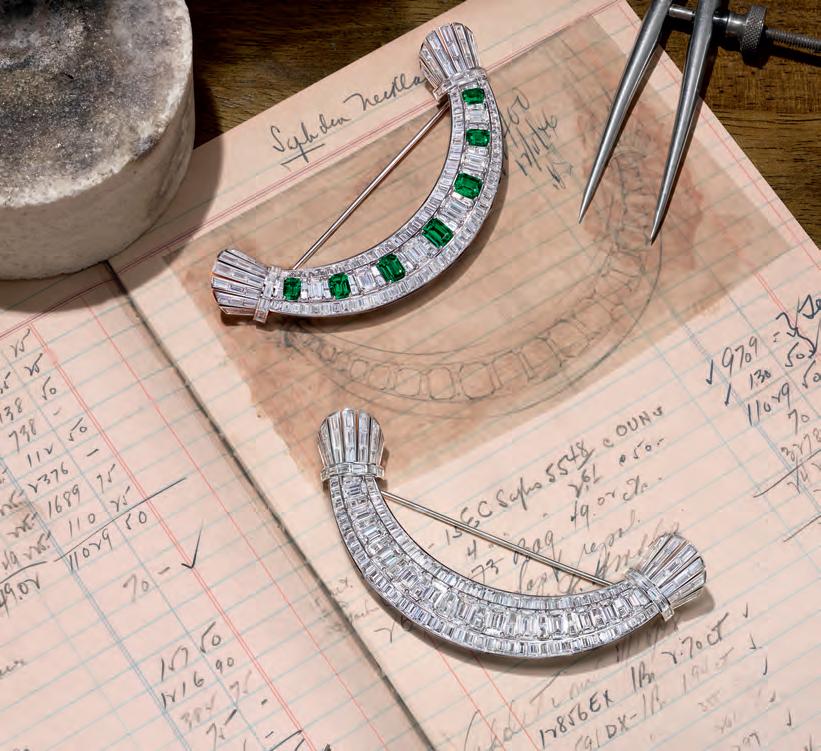
the brand’s globetrotting founder.
Comprising diamonds, rubies, sapphires, emeralds, Paraiba tourmalines and conch pearls, the coloured gemstonedriven collection retells some of the most significant moments in the company’s history by reimagining famous pieces for a contemporary audience.
Suites contain a range of bracelets, brooches, necklaces, rings, earrings and tiaras that draw from important jewels of royal provenance that have passed through the hands of Harry Winston over the course of a century – providing a bridge from the company’s stately present to its majestic past.
harrywinston.com
35
“E
THIS IMAGE THE D-SHAPED KING BROOCHES PAY HOMAGE TO A DESIGN FROM 1947 THAT CELEBRATED HARRY WINSTON'S NEW MONIKER AS THE 'KING OF DIAMONDS' BELOW THE MAIN 5.26-CARAT PEAR-SHAPED RUBY IN THE HEIRESS NECKLACE

170 New Bond Street - 020 3967 3730

68 The Trend Report What you’ll be wearing in the months ahead 72 Priya Ahluwalia Why the Ahluwalia founder will not be pigeonholed 80 Miranda Kerr On founding one of the first celebrity beauty brands 90 Jeremy Hackett Celebrating 40 years of a very British aesthetic
I’m creating a season, I read a lot, I watch a lot of films and I visit exhibitions and galleries. All of that feeds into this bank of research that I have, and I curate projects from that.” Priya Ahluwalia, p.72 CUT FROM A DIFFERENT CLOTH Couture
“When
CHECK

Mate
While preppy style invariably makes a return every time the temperature dips (there’s just nothing chicer than a tartan longline coat), some trends are a mainstay for a reason. What else are you going to wear to frolic in the fallen leaves other than a gingham scarf or plaid sweater vest? In 2023, however, checks are punkier than their predecessors – match classic prints with spikey accessories or a checkerboard tote for a slightly edgier autumn look.
Anna Solomon
SULLY VEST, £480, Molly Goddard, mollygoddard.com
G RHOMBUS COTTON STITCH CARDIGAN, £2,300, Gucci, gucci.com
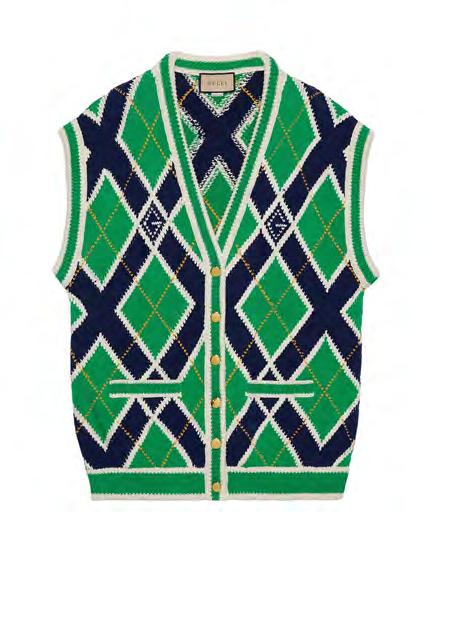

CHECKED LUREX WOOL LONG SKIRT, £830, Alessandra Rich, alessandrarich.com
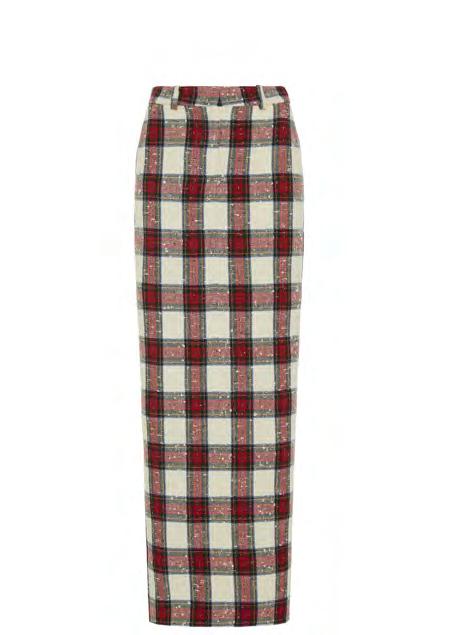

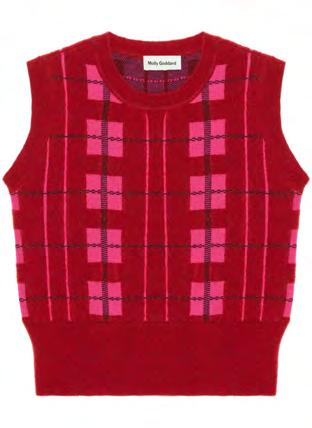
TARTAN HEADBAND WITH SPIKES, £340, Alessandra Rich, alessandrarich.com
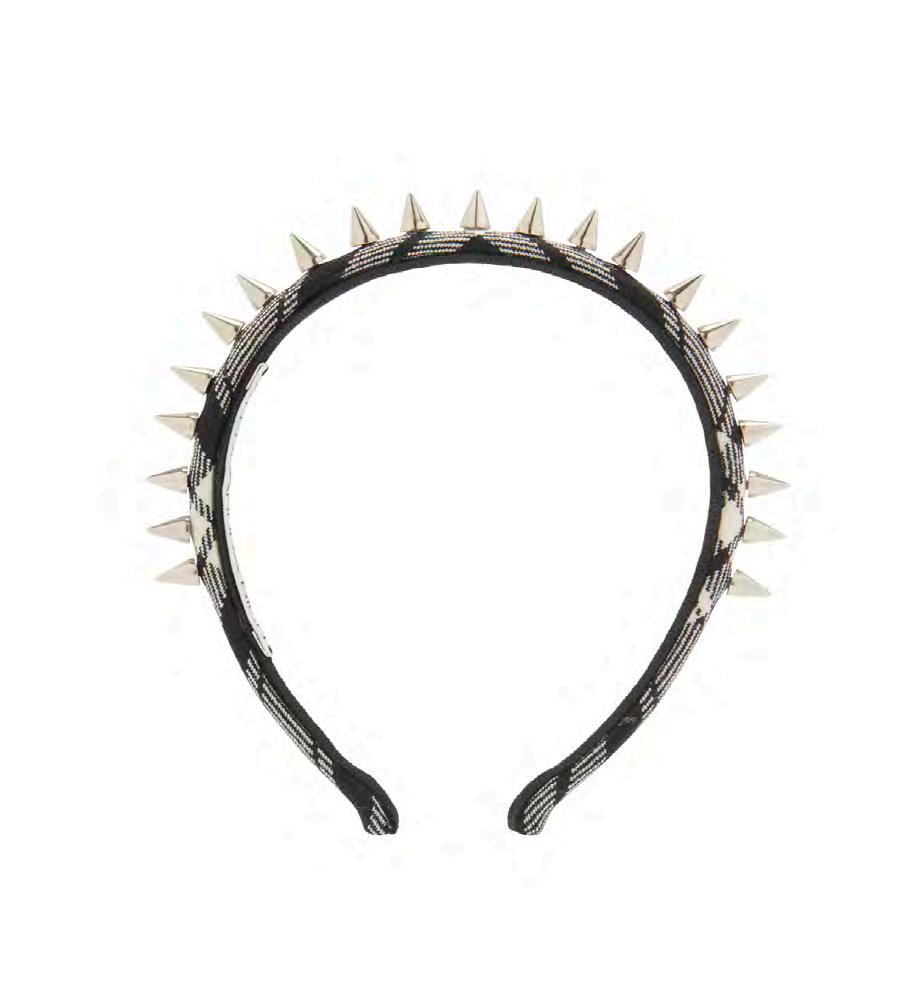 MARKET DIAMOND BAG, £340, Marni, marni.com
Alessandra Rich
MARKET DIAMOND BAG, £340, Marni, marni.com
Alessandra Rich
Leathered UP

Once those first leaves fall, the leather jacket resumes service as the sartorial go-to. But why stop there? The change in weather provides licence for leather skirts, trousers and dresses. Select subtle styles in brown and blue, and you could go head-to-toe without looking like a Hells Angel. If you wanted to, that is.

 Edited by: Anna Solomon
Edited by: Anna Solomon
EDA DRESS IN LEATHER, £4,390, Gabriela Hearst, net-a-porter.com
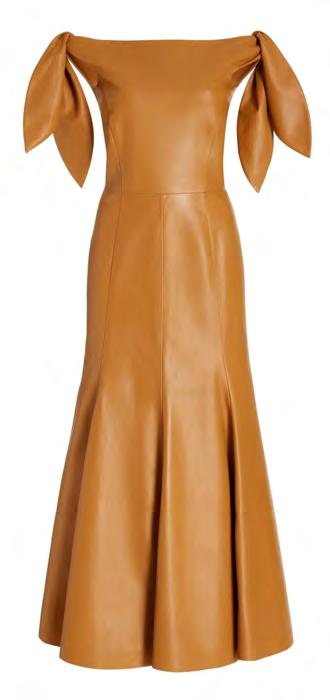
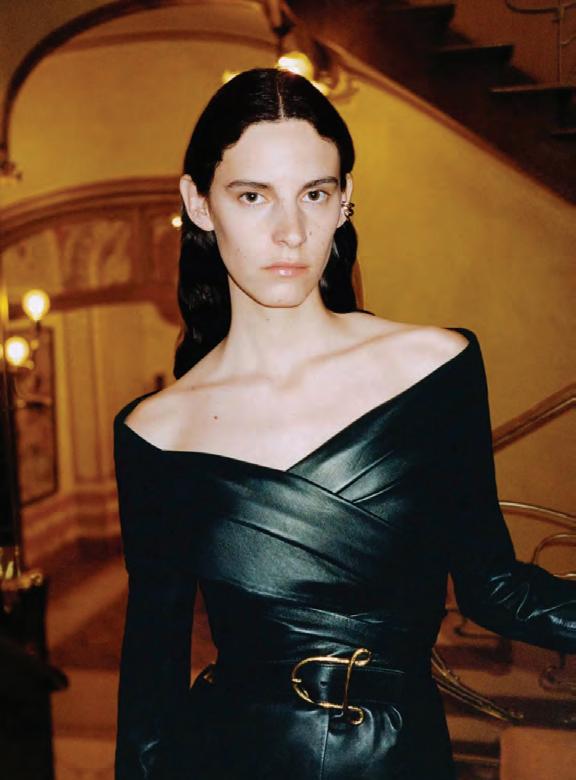
SMALL MONY TOTE BAG, £1,690, Chloé, chloe.com

SMALL TESS BAG, £1,390, Chloé, chloe.com

LUXURY LONDON COUTURE LUXURYLONDON.CO.UK
LEATHER MOTO JACKET, £639, Ralph Lauren,
Nanushka, nanushka.com
Altuzarra
STRETCHADOXA BOOT, £1,075, Christian Louboutin, christianlouboutin.com
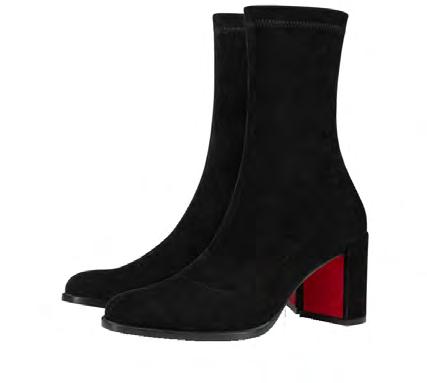
BLAKE KNEE BOOT 85, £7,000, Jimmy Choo, jimmychoo.com
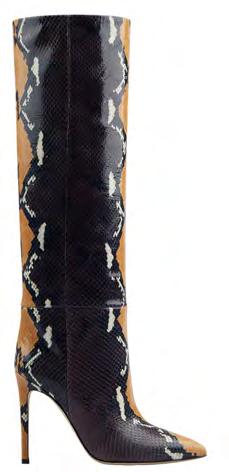
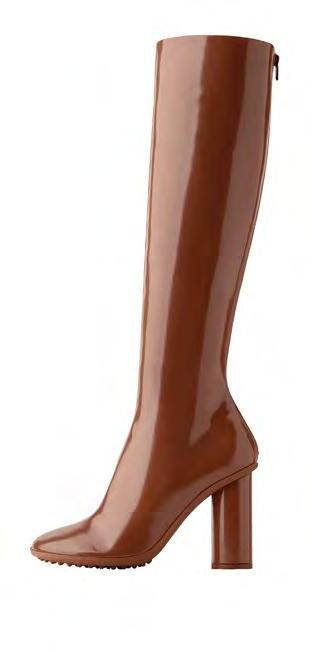
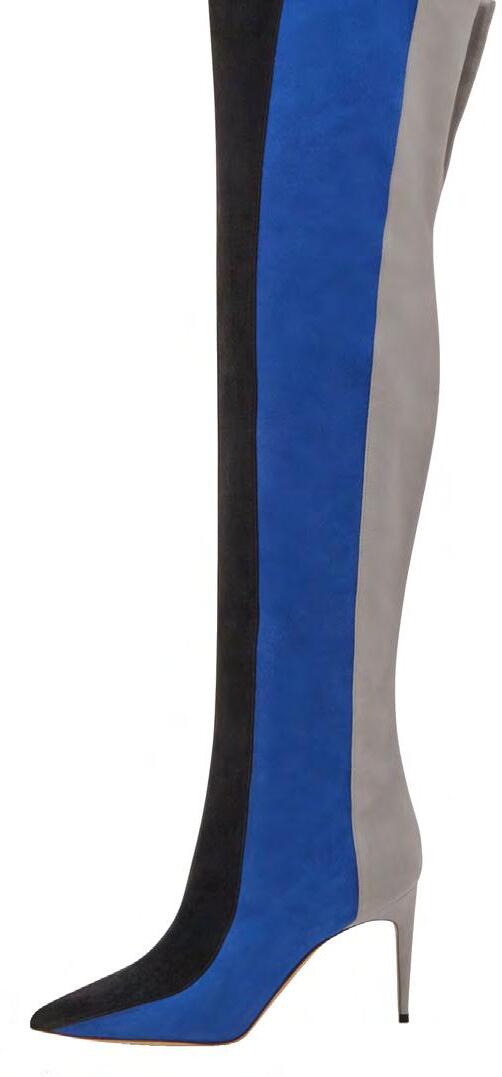

RIRIA SUEDE BOOTS, £990, Isabel Marant, isabelmarant.com
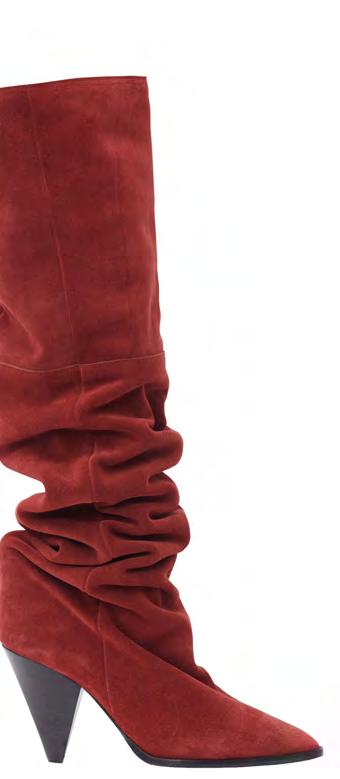
WALKING MADE FOR

As any fashionista knows, shoes are not an afterthought, but the heart of a look, capable of making or breaking an outfit. And now, after months of humidity ruling out those suede knee-lengths or leather stilettos, it’s finally time to utilise the boot to its full potential.
Edited by: Anna Solomon
STILETTO BOOT, £680, Paris Texas, paristexasbrand.com
CHICUYUHI BOOT, £1,475, Manolo Blahnik, manoloblahnik.com
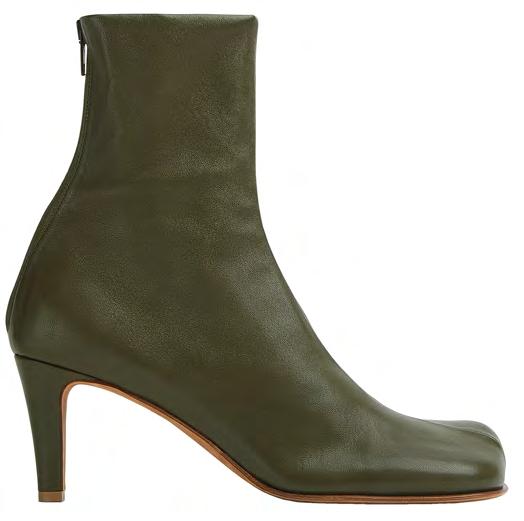
BLOC ANKLE BOOT, £990, Bottega Veneta, bottegaveneta.com
ATOMIC BOOT, £1,350, Bottega Veneta, bottegaveneta.com
STYLE
GLOW ON
NOBLE PANACEA’S HIGH-TECH FACE OILS AIM TO ADD LUMINOSITY TO YOUR SKIN BY USING A GROUND-BREAKING NEW HYDRATING FORMULA
There’s no denying the rewards of adopting a thoughtful skincare regime – and few beauty products pay greater dividends than a great face oil. But they can be daunting. After all, didn’t we spend our entire youth trying to rid our complexions of excess oil? But forget notions of teenage breakouts and oily T-zones. We’re talking face oils specifically created to nourish the skin. Oils that, with the right formula, can lead to an immediate healthy glow, as well as supple skin in the long run. Of course, not all oils are created equal. Enter Noble Panacea’s new hydrating face oils.

While most face oils can help moisturise your skin, they don’t tend to hydrate – merely sealing in moisture from previously applied products. Not so at Noble Panacea, whose experts have created two new face oils that deliver proven hydration.
As with all Noble Panacea products, the secret here is in the ground-breaking OSMV encapsulation technology, developed by founder and Nobel Prize-winner Sir Fraser Stoddart, which delivers timed releases of active ingredients to the skin,
Face oils are traditionally crafted from pure oils without water and work by reducing Trans Epidermal Water Loss (TEWL). They retain water and moisture that’s already in the skin, but do not add extra hydration. The first of their kind, Noble Panacea’s newly-launched high-tech face oils use OSMV technology to
encapsulate water-soluble hyaluronic acid (a holy grail skincare ingredient) and incorporate it into a pure oil formula. This is then released into the skin over an extended period of time, resulting in long-term hydration, up to 10 times greater efficacy, and an immediate glow.
Hydration is essential for all skin types. However, differing skin concerns require different products. Happily, Noble Panacea’s revolutionary face oils come with options. If you’re looking to nourish, restore and repair your skin while reducing TEWL, pick The Absolute Nourishing Lift Oil. Crafted with restorative hero ingredients, including hyaluronic acid, squalene, retinol, sea fennel extract and hazelnut seed oil, it boosts collagen and elastin production, and replenishes the lipid barrier while hydrating and softening the skin.
Then there’s The Brilliant Glow Hydration Oil, designed to create plump skin that is truly luminous. Rich in plum kernel seed oil, saw palmetto extract and raspberry seed oil, in addition to hyaluronic acid, it regulates sebum production and provides a healthy glow for supple skin.
Never considered yourself a face oil person? Take the leap and include Noble Panacea’s revolutionary oils into your everyday skincare routine. We’re confident you’ll never look back.
Shop the full collection at noblepanacea.com
71 LUXURYLONDON.CO.UK LUXURY LONDON PROMOTION

THE REAL THING
WHEN PRIYA AHLUWALIA LAUNCHED HER LABEL IN 2018, HER IDIOSYNCRATIC DESIGNS, INFORMED BY HER DUAL HERITAGE, AND HER USE OF SECONDHAND MATERIALS QUICKLY ELEVATED HER TO FASHION ROYALTY. YET, SAYS THE INDIAN-NIGERIAN STYLE MOGUL, HEAVY IS THE HEAD THAT WEARS THE CROWN
Words: Anna Solomon
riya Ahluwalia is not a people-pleaser. She possesses an insouciant freedom from the conventions of polite conversation that I imagine is probably quite liberating – she doesn’t coax or encourage, doesn’t ‘mmm’ and ‘yeah’. She didn’t even turn on her video during our Zoom call, citing technical issues. She’s amiable, sure. Just not the sort of person who offers it all up on a plate.
Which, after years of doing interviews with people ‘in fashion’, I can tell you is rare. Usually, you give a spokesperson a soapbox and they’ll regurgitate their entire press pack. Ahluwalia is the polar opposite. She’s not going to pitch for you. She won’t rerun the same old soundbites. Far from it.
“I was just so bored of everyone talking about [sustainability],” Ahluwalia told GQ in 2020. Which is not the sort of thing you typically hear from the mouth of a high-profile designer – especially one that was named ‘Environmental Leader of Change’ at the British Fashion Awards in 2021; someone whose label has been known since its 2018 inception for working with deadstock materials.
Looking through any given collection, you can feel it: the quirky, multilayered, slightly frenetic style that comes with scouring warehouses for recycled offcuts. “I like things with depth,” says Ahluwalia, “and that really comes with using deadstock, because when you don’t have enough material to make a full garment you start to patch things together. That’s rubbed off on my aesthetics – even with a really slick piece, there’s always depth to it.”
Naturally, I’m keen to find out how she reconciles this approach with her comments: “The reason I sometimes get frustrated is not because I don’t think [sustainability] is important, but I think it takes away from the fact that I’m a designer and a creative and I’m good at my job,” she says. “It makes people just want to talk to me about, like, organic materials, and that’s a fraction of it.”
It’s an unconventional position, to be sure, but refreshing. On the other end of the spectrum, you have brands touting their green credentials until they’re blue in the face, even if they don’t really have any. But here’s a designer who actually does do the sustainability thing, declining to comment
on it. Is Ahluwalia the anti-greenwasher, providing a much-needed antidote to virtue-signalling labels?
“[Greenwashing] is not something that happens among my peers. We are trying our best, and I think that’s all that you can do,” she says. “We need to ask these questions to people that can make systemic change, because everything I’m doing is a blip in the ocean; it’s a speck in the universe. But there are companies that could shift the needle, and that’s where the sustainability conversation needs to be focused.”
My question on diversity – a huge buzz-topic in the industry right now, with debates raging around plus-size models, age representation, and the number of non-white designers at Fashion Week –ricochets in a similar fashion. As a designer of black and South Asian descent (her mother is Indian; her father is Nigerian), I thought that Ahluwalia might have something to say on the matter. She did, of course – just not what I expected.
“I don’t want to come across as rude. But this question, it’s quite funny to me, because I’m obviously not a part of the problem. I have a team of 10 people; there are nine women, one man, 90 per cent of us are black or brown or a mixture of both. So, like, I don’t have a diversity issue in my business. That’s not an issue that I perpetuate. So I don’t really know.” She offhandedly cites “white supremacy” and the “fetishisation of youth”, but it’s clear we won’t be chowing down on any meaty sociopolitical issues today.
Just as Ahluwalia refuses to be pigeonholed as a ‘sustainable designer’, she doesn’t want to be lumped into a non-white ‘box’. Unlike when she was growing up in the 1990s and ’00s, there is now a substantial cohort of POC-owned labels rising through the ranks – Mowalola, Wales Bonner and Saul Nash, to name just a few. “These designers, they’re showing their authentic representation of what it is to be black or brown – there isn’t a onedimensional representation of it, because that’s not life,” says Ahluwalia. “All our creativity is different. I don’t like to be reduced to being just a black or brown designer, because there’s a multitude of things that means for different people.”
The more I nudge Ahluwalia towards the soap box, the more it becomes clear that she doesn’t
P
“There are companies that could shift the needle, and that’s where the sustainability conversation needs to be focused”

BEHIND THE SCENES AT AHLUWALIA’S AW23 SHOW, HELD AT THE CHURCH AT JOHN’S
WESTMINSTER
SMITH SQUARE,
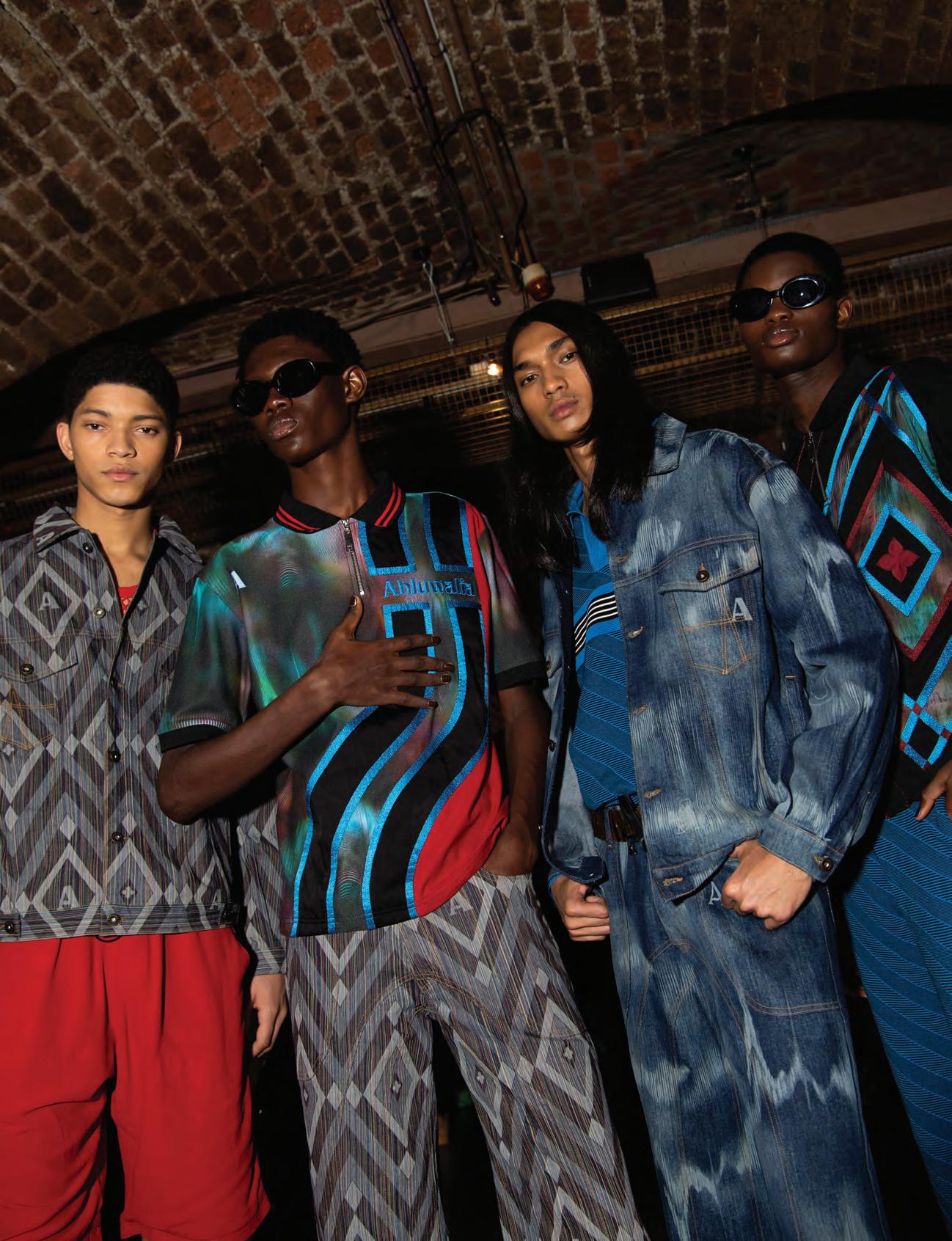 BEHIND THE SCENES AT AHLUWALIA’S AW23 SHOW, HELD AT THE CHURCH AT JOHN’S SMITH SQUARE, WESTMINSTER
BEHIND THE SCENES AT AHLUWALIA’S AW23 SHOW, HELD AT THE CHURCH AT JOHN’S SMITH SQUARE, WESTMINSTER
want to go there. Is it important for the creation of a well-adjusted society that people are exposed to different cultures, I wonder, dangling the bait? She ignores it. “I don’t want to answer. I don’t know. I don’t really understand why it’s up to me to discuss what other people need to be doing to be wellrounded, to be honest.”
OK. Enough of politics. Enough social issues. Enough probing for preachy soundbites that Ahluwalia is clearly loath to give. Who is she as a designer, away from buzzwords and box-ticking? She is a designer whose memories of her home countries inform her ideas – she takes cues from Indian embroidery and the streetwear of Lagos: “Everything that I have grown up with is naturally going to influence my work. The music I have listened to, Nollywood and Bollywood cinema, family photos, artefacts...”
London, Ahluwalia’s hometown, is another source of inspiration: “It’s a melting pot and that influences the way I look at things. I like syncretism.”
The designer’s Tooting upbringing directly informed one collaboration with Clarks, in fact, which spoke to a collective experience of London kids: traipsing to the shop to get their school shoes. “Those sort of moments define your taste forever, right?”
Ahluwalia started as a menswear label (the company has only been doing women’s collections since 2021), once again taking cues from a patchwork of sources: Indian and Nigerian street style, male celebs like Donald Glover and ASAP Rocky, Savile Row tailoring. The designer was drawn to men’s clothing for the simple fact that, traditionally, the category has been so much more limited than women’s – Ahluwalia wanted to see whether she could mix it up. “Men have been wearing pretty similar things for the past 50 years. I liked the idea of having the opportunity to push those boundaries – to play around with the codes of menswear.”
What else? She is a designer who loves to use mixed media: “When I’m creating a season, I read a lot, I watch a lot of films, and I visit exhibitions and galleries. All of that feeds into this bank of research that I have, and I curate projects from that.”
Ahluwalia’s latest ready-to-wear collection, Symphony, is inspired by the music that has shaped her life, including artists like Sade, Lauryn Hill and
Mobb Deep, with a dose of Prince and Queen, and a sprinkling of Punjabi and Nigerian beats. In 2020, Ahluwalia participated in GucciFest, where she created a short film called Joy; she fell in love with filmmaking and, at the end of last year, was signed to Black Dog Films.
What about Ahluwalia the person? She loves getting dressed up, and her nails are always immaculate. “The way that I like to accessorise and look, I’m definitely like a London girl,” she says. “That said, there is definitely time for a tracksuit. I mean, I wear a tracksuit to work.”
When I ask Ahluwalia about her favourite music artists, something shifts – for the first time, she relaxes and enthuses: “Oh God, it’s so difficult. I don’t know how to answer because I just love so much stuff. Okay, I’m gonna say Sade.”
The matter of her favourite film is equally torturous – maybe 1998 Hindi musical Kuch Kuch Hota Hai – but she settles on Homegoing by Yaa Gyasi (a historical fiction about slavery) as the book that has changed her life. On the subject of books, Ahluwalia’s SS24 collection was shown at the British Library, which she says “speaks to [her] love of literature”. She keeps a notepad by her bed, and writes something every day.
Ahluwalia says she’s a party girl trapped in a homebody, conceding that she’d rather be out on a Friday night, but usually stays in. She loves the food that her Indian nana cooks, rivalled only by goat suya (a Nigerian kebab). “This is the tricky thing about being mixed race,” she laughs. Her favourite person in the world is her mum.
“Black and brown people should just be able to have joy,” says Ahluwalia towards the end of our interview. “I think that I should be able to just enjoy putting nice things out without having to be some sort of representative to fix the whole world.”
Suddenly, her reticence makes sense – it must be exhausting, constantly politicising your existence. And I saw how she came alive when she was allowed to talk about her passions, rather than having to hash out the whole fashion world’s ills. Here is a complex, multi-layered individual – not a mouthpiece. She doesn’t have all the answers, and has never claimed as much.
“Everyone thinks I’m some sort of political spokesperson,” says Ahluwalia. “I just represent an authentic experience.”
77 LUXURY LONDON COUTURE LUXURYLONDON.CO.UK
ahluwalia.world
“Men have been wearing pretty similar things for the past 50 years. I liked the idea of having the opportunity to push those boundaries”



CHAPTER The next
MIRANDA KERR WAS ONE OF THE MOST RECOGNISABLE FACES OF THE 2010 s NOW, THE FORMER SUPERMODEL HAS LEFT FASHION BEHIND AND EMBARKED ON A MISSION TO COMMUNICATE THE BENEFITS OF ‘CLEAN BEAUTY’
Words: Anna Solomon

When Miranda Kerr burst onto the scene as one of Victoria’s Secret’s ‘Angels’ in 2007, Ed Razek, then chief marketing officer at parent company, L Brands, described her as having “the cheeks of a chipmunk, the smile of an angel and the body of the devil”. Given the former executive’s resignation in 2019, having been accused of creating a culture of misogyny and harassment, the depiction is slightly toe-curling – but it goes some way to explaining Kerr’s appeal at the time. Fresh-faced and doe-eyed, she was the ultimate girl-next-door.
Razek’s comments also shed light on how models were viewed back then (read: objectified). It was tough, says Kerr, now 40, and the ruthless scrutiny of her appearance took its toll – inevitably, perhaps, for someone who started modelling aged just 13. Kerr was living in a small town in New South Wales when her friend entered her into a modelling competition for a teenage magazine.
The Aussie native was then cast in a number of national campaigns, before moving to New York where she signed a career-boosting contract with Maybelline. It was at this point that Kerr was signed by Razek, joining the likes of Adriana Lima, Alessandra Ambrosio and Heidi Klum. The work kept coming – as well as Victoria’s Secret, Kerr has walked for Prada, Chanel and Dior; since 2008, she has consistently ranked on the Forbes list of highestearning models. In 2010, she married Orlando Bloom, cementing her place in the cultural landscape of that decade.
In the midst of all this, in 2009, Kerr launched her organic beauty brand, Kora Organics – something she had wanted to do since her mother was diagnosed with cancer when the younger Kerr was 16. She has been navigating life as a model-businesswomanentrepreneur-philanthropist ever since. Oh, and she’s also a mother of three children – one of whom she shares with Bloom, the two others with her current husband, Snapchat CEO Evan Spiegel (the couple are currently expecting their third).
Here, Kerr discusses her beginnings in the modelling industry, running a successful business, and what a typical day looks like for a veteran model-turned-beauty-mogul.
Did you ever imagine life as a model before your friend entered you into the Dolly competition? No. I grew up in a small town riding horses, climbing trees, and swimming in the river. I was a tomboy, completely removed from the fashion world. I never thought my modelling career would last as long as it has – I still get shocked when I get a modelling offer!
What was it like being the first Australian Victoria’s Secret model? I remember, before my first VS casting, I was so nervous. I was playing Eminem’s Lose Yourself to try and shake off some of the nerves! I’ll never forget one of my first trips for Victoria’s Secret. I met a bunch of the Angels… Adriana [Lima], Alessandra [Ambrosio], Gisele [Bündchen]. I was blown away, not just by their beauty but also their energy. I remember thinking, what am I doing here? All these women are absolutely stunning.
We were a really tight group of girls… we were like a little family. The shows were so much fun and the energy was electric backstage. Those are some of my best modelling memories.
You were the first pregnant model to be photographed for Vogue. Now you have Rihanna doing high-fashion maternity shoots that celebrate pregnancy. Did you feel that your shoot was somehow important for representation at the time? Oh, absolutely. It’s wonderful to see the progression in the industry towards celebrating pregnancy and motherhood. When I had the Vogue opportunity, I was nervous but grateful to capture such a beautiful and transformative experience. It’s heart warming to see figures like Rihanna continuing this movement, reaffirming that every stage of life is a time to feel empowered. I hope that these kinds of shoots continue to inspire women to embrace their changing bodies and cherish the incredible journey of motherhood.
Did you ever find working in an environment where you were constantly scrutinised for your appearance difficult? I did. There’s a lot of rejection at first in modelling. The fashion and beauty industry is demanding, and the pressure to meet certain standards will take a toll on anyone’s self-esteem. When you’re immersed in that world it’s easy to become overly critical of yourself.
Saying that, I’ve always believed in the importance of inner beauty – it’s about recognising that beauty comes in many forms and that our uniqueness is what makes us special. I’ve used these experiences to promote a more balanced and holistic view of beauty – one that’s not solely defined by external appearances.
81 LUXURY LONDON COUTURE LUXURYLONDON.CO.UK
How would you describe your personal style? For me, fashion is a creative outlet. My style is about feeling comfortable, confident and true to myself –I would describe it as feminine chic. I love timeless pieces that exude sophistication, but also those with a touch of free spirit – flowing dresses, floral prints, and accessories that add a bit of playfulness and romance.
What is your go-to fashion item? A well-fitted pair of jeans. They’re so versatile! I love how effortlessly you can dress them up or down – and practicality is key as a busy mum.
What are the accessories that you couldn’t live without? My wedding ring! I’m also known to carry my handbag with me everywhere I go… including at home.
Who, in your opinion, is the most iconic supermodel of all time? I’m not sure if you’ll let me get away with this as she wasn’t solely a supermodel, but Audrey Hepburn. She carried herself with so much grace and her beauty shone through her soul.
Let’s talk about your skincare brand. Kora’s ethos is to ‘encourage people to be the healthiest version of themselves’. How do you do that, personally? What works for one person may not work for another, but I find it’s really important that I take time to exercise, spend time with my family and close friends, meditate, eat healthy food, read books that uplift me, and do my skincare rituals morning and night. Crystals, aromatherapy, mindfulness and positive affirmations have helped me so much, too, and I meditate for 15-20 minutes every morning to set my intentions for the day.
What sets Kora Organics apart from other celebrityassociated skincare brands? When I first started Kora Organics, no one else was doing certified organic skincare that was results-driven, so I knew that I was on to something. Back then, ‘clean beauty’ wasn’t a thing. Being certified organic is what sets us apart – there are a lot of brands that claim to be clean or natural when in fact they might only be using one natural ingredient amongst many toxic ones.
Also, there has always been a misconception that I’m just the face of the brand, but I built Kora from the ground up, with my own money. This is not a licensing deal – I created [Kora] out of my love for health and wellness, and I’m across all of the day-to-day running of the business.
How can the products we use impact our health? When my mum was diagnosed [with cancer] it encouraged my family to look more closely into what we were putting into and on our bodies. Through that process we learned that a lot of the everyday products we were using contained chemicals that were potentially detrimental to our health – it was shocking to see how toxic and potentially carcinogenic certain readily-available products can be.
What is your number one beauty hack? Always wash your face before bed. My mum taught me this when I was young and it stuck with me.
What does a typical morning look like for you? I wake up between 5 and 5.30am, do a quick workout, meditate, and do my morning self-care routine before the kids wake up around 7am. I drink a litre of cold-pressed celery juice on an empty stomach every morning. Then, I’ll have a heavymetal detox smoothie, adding the Kora Organics Noni Glow Skinfood powder. I also take probiotics: lemon balm, Vitamin B12, Vitamin C, and Nadovim supplements every day. At about 7am, my boys wake up and we do their morning routines and get them ready for school. Then, after I drop them at school, I start work for the day.
How do you practise self-care? My wellbeing rituals consist of a well-balanced diet, daily exercise, meditation, and my skincare routines. Like most mothers and business owners, every day is different, and there are times where I can’t fit everything in. But I try to take a moment for myself each day – even if I only manage a 10-20-minute meditation, this really helps. Once a week I love to have a bath and put a rose quartz crystal at the base of the tub, adding a few pumps of my Kora Organics Noni Glow Body Oil. I make a cup of lemon balm tea with honey, tie my hair up, dim the lights, light a few candles, burn palo santo to clear the space, and play some relaxing music.
What is your favourite way to spend a Saturday night? A home-cooked meal with my husband and three boys.
Where is your favourite place in the world? Wherever my family is. Being with my husband and boys is my favourite place in the whole world.
koraorganics.com
“I wake up between 5 and 5.30am, do a quick workout, meditate, and do my morning self-care routine before the kids wake up”

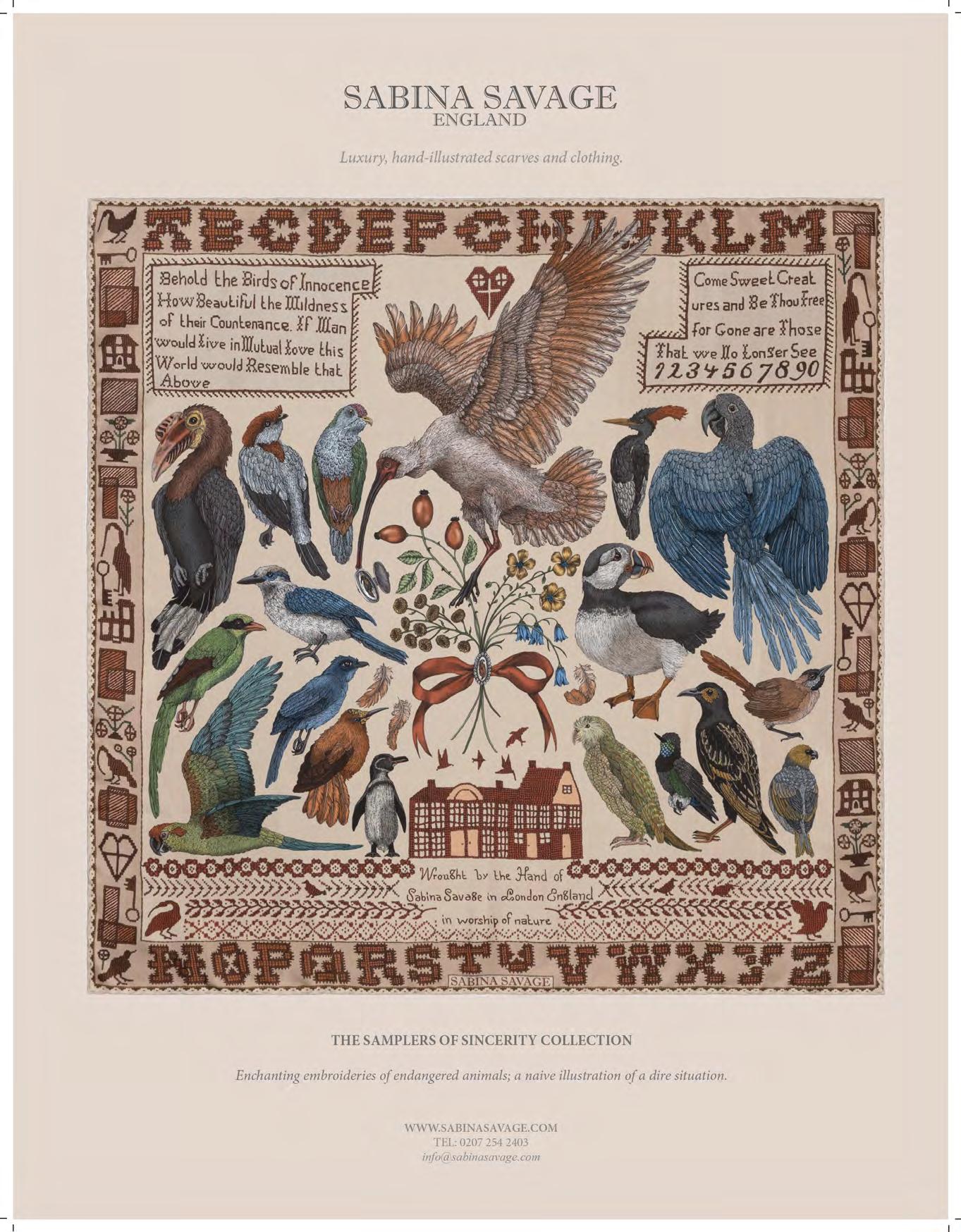
Planning AHEAD
Is there any greater joy than ticking off your daily to-do list, or circling days with exciting events in a diary? We don’t believe there is. While tracking plans and meetings on a Google calendar might seem like an easier alternative, a truly great diary can inspire and motivate us to a much greater degree than a screen ever could.
Steeped in history, Frank Smythson opened the doors of his first store on London’s New Bond Street at number 133 in 1887. Its present-day flagship store is just next door, now at 131-132. For over 130 years, Smythson has been creating pieces that capture life’s unfolding narrative and its diary collection is no exception.
Putting pen to paper is a habit that can be highly rewarding; a cathartic, meditative process that can slow down the world and help us understand our place within it. For 2024, the British luxury leather and stationery brand had some bright ideas for its new diary collection. As vibrant as the lives destined to fill them,

each style comes in an array of striking shades – from Eucalyptus and Watermelon to Forest Green and Peony. With something to suit every planning persona, the new season includes both daily and weekly page layouts. Packed with Smythson’s signature pale blue Featherweight paper, the pages are edged with handpainted gilding in gold or silver.
Bound in a choice of Smythson’s three signature leathers – Panama, Ludlow and Mara – finishing details include ‘2024’ delicately marked on most front covers and grosgrain Navy Blue page markers inside. A selection of diaries also features neat slide closures and handy pencil slots.
To help make each diary unique to its owner, Smythson offers a personalisation service, providing a range of lettering and motif options in a variety of colourful foil finishes.
After all, what’s more individual than a personal diary?
From £55, smythson.com

85 LUXURYLONDON.CO.UK
PROMOTION
INDULGE IN A QUALITY DIARY FROM SMYTHSON AND GET A HEAD-START ON MAKING THE MOST OF 2024
GET THE BEST OF LUXURY LONDON

AT YOUR FINGERTIPS WITH A DIGITAL PLATFORM DEDICATED TO BRINGING YOU THE LATEST IN LIFESTYLE , CULTURE , FASHION AND TRAVEL
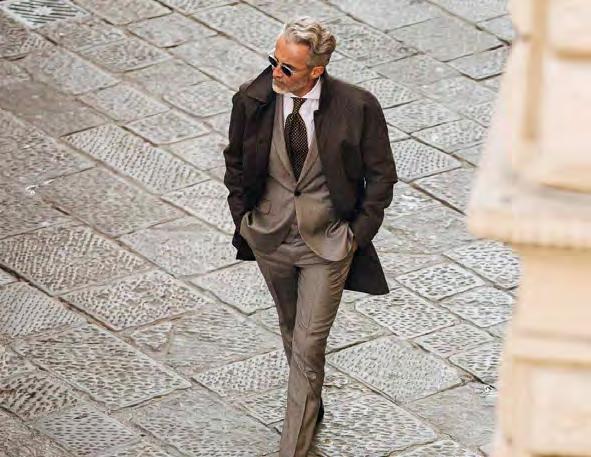






86 LUXURY LONDON FEATURE LUXURYLONDON.CO.UK LUXURYLONDON.CO.UK
LUXURYLONDONOFFICIALLUXURYLONDONOFFICIALTHEOFFICIALLL LUXURYLONDONMEDIA
HERRINGBONE BAKERBOY CAP, £225, Lock & Co Hatters, lockhatters.com

DOGTOOTH POCKET SQUARE, £55, Bigi, trunkclothiers.com

FIELD COAT IN NAILHEAD TWEED, £895, Oliver Brown, oliverbrown.org.uk
STRAIGHT-LEG WOOL TROUSERS, £1,100, Brunello Cucinelli, brunellocucinelli.com
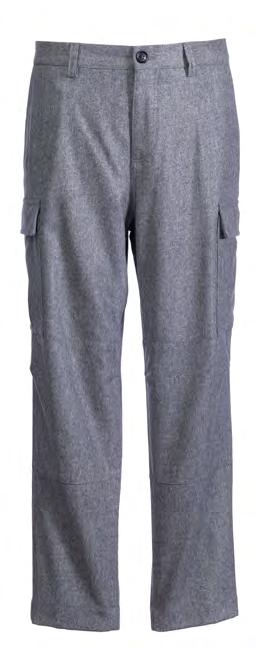
LIVING Country
Edited by: Richard Brown

This autumn, escape the city in style. By which we mean with a pair of Goodyear-welted boots, a tailored field jacket, and with a weekend bag brimming with tweed, suede and lambswool

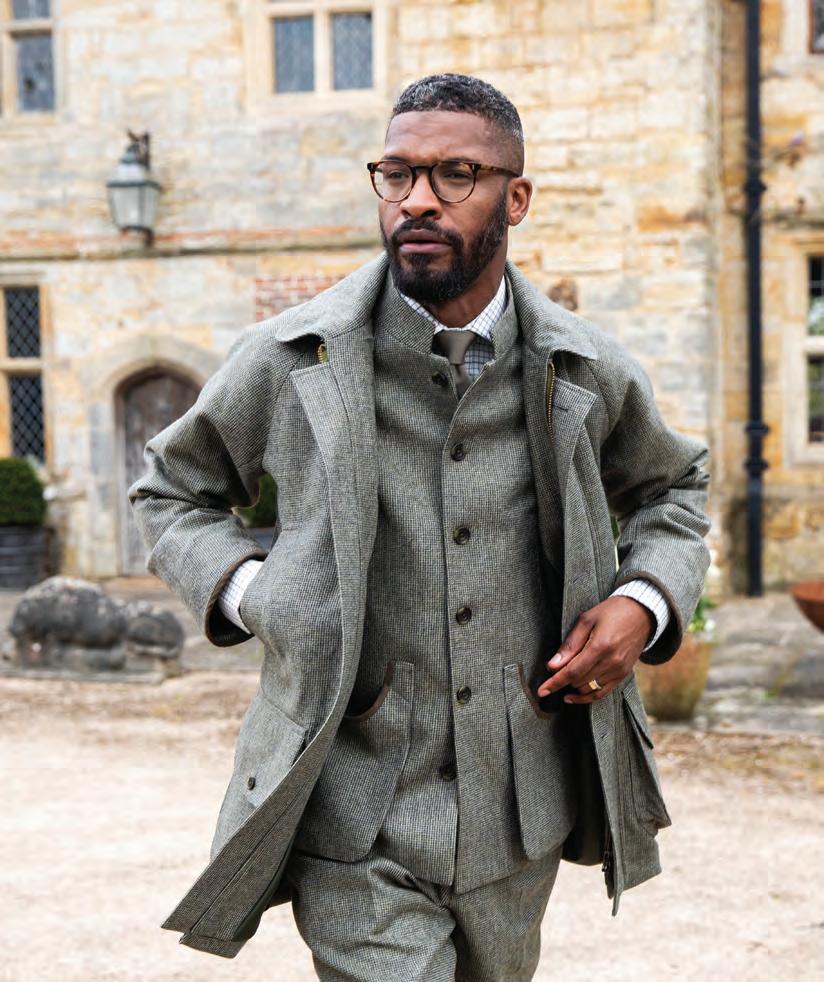
SUEDE WEEKENDER, £1,750, Bennett Winch, bennettwinch.com
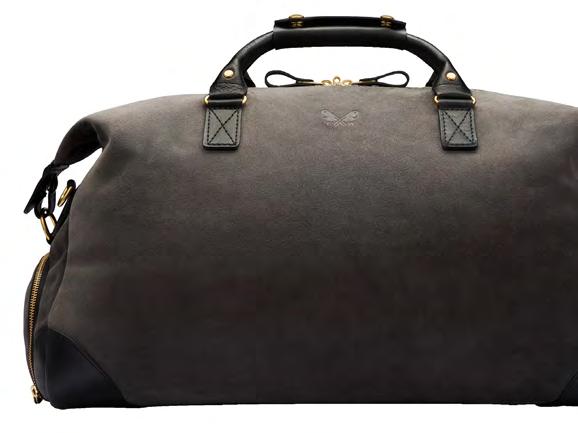
PURDEY GV BUCKSHOT DERBY BROGUE BOOT, £475, Joseph Cheaney & Sons, cheaney.co.uk

87 LUXURYLONDON.CO.UK
DARK BROWN CASHMERE SILK RESORT SHIRT, £450, Colhay’s, colhays.com
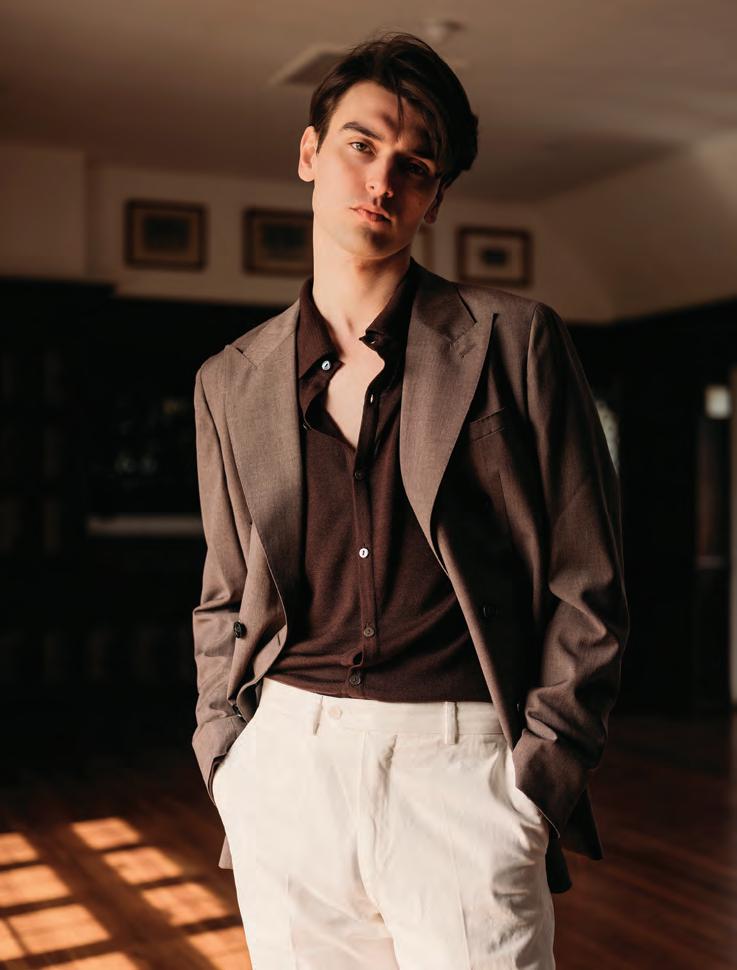
TERRACOTTA WAFFLE KNIT POLO, £85, Sirplus, sirplus.co.uk

DARK TURTLE 1402 SQUARE SUNGLASSES, £385, Cutler & Gross, cutlerandgross.com
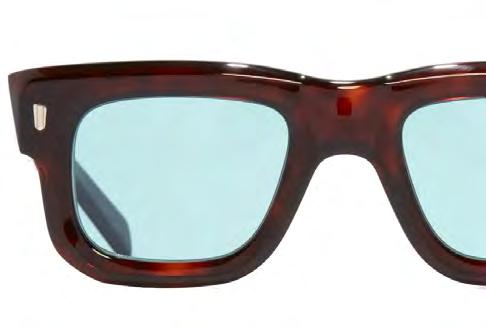
Get REDDY
Winter’s coming. Before then, make the most of warmer temperatures by channelling your inner Alain Delon (circa Purple Noon) with waffle-knit polos, flannel bomber jackets and tortoiseshell sunglasses
Edited by: Richard Brown

TAN HICKORY SOLID STICK UMBRELLA, £280, London Undercover londonundercover.com
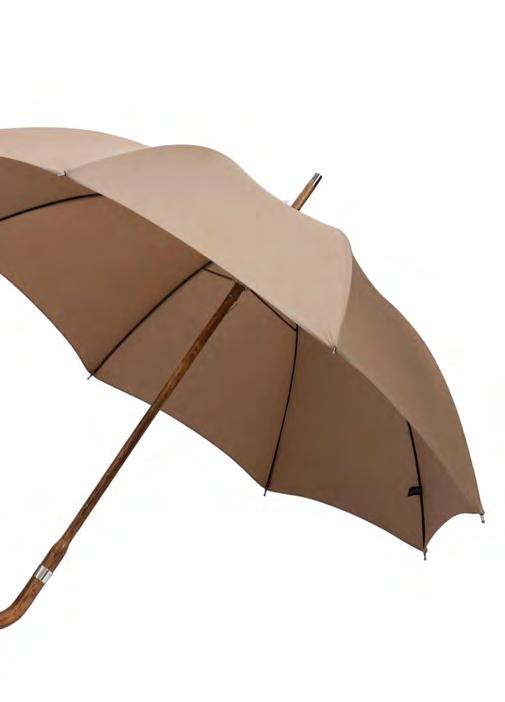
PEMBROKE DERBY SHOE, £540, Crockett & Jones, crockettandjones.com
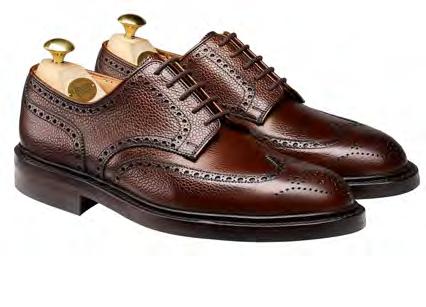
THE FLANNEL BOMBER JACKET, £219, Mr Marvis, mrmarvis.com

BLUE
COLLAR
Lean back into layering with a late-summer palette of blues and beiges. Think loose-fitting, workwear-inspired pieces in mid-weight cottons and lightweight linens
Edited by: Richard Brown

COSMICS LINEN TROUSERS, £119, Mr Marvis, mrmarvis.com
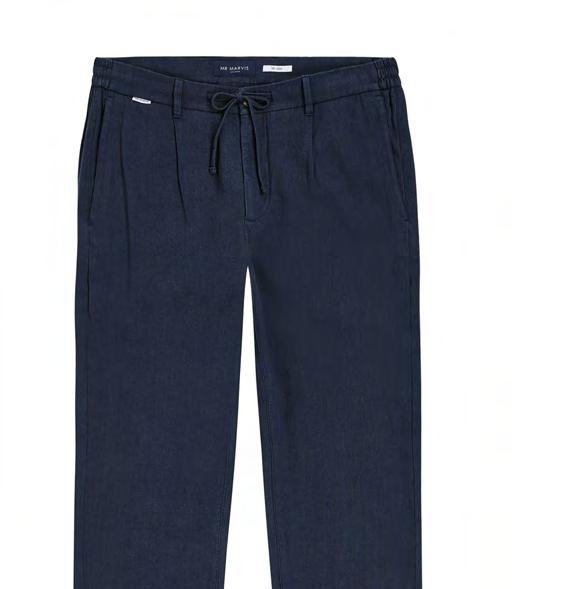
BOBBLE HAT, £60, OVERSHIRT, £195, OVERCOAT, £595, ALL TOAST, TOA.ST
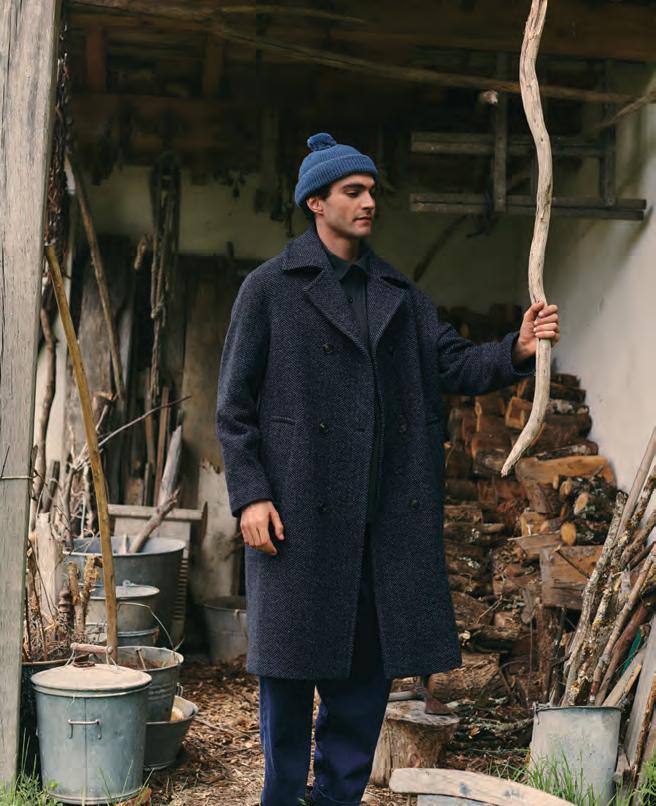
SLOC CANVAS CHUKKA BOOT, £145, Moonstar, trunkclothiers.com
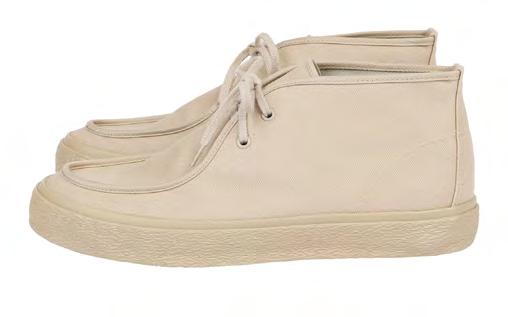
FRAPOLA CRUNA CHINA
SWEATER, £455, Barena Venezia, barenavenezia.com

PORTOFINO AUTOMATIC, £4,450, IWC, IWC.COM

STRIPED RIBBED
COTTON-BLEND SOCKS, £13, Nudie Jeans, mrporter.com

89 LUXURYLONDON.CO.UK
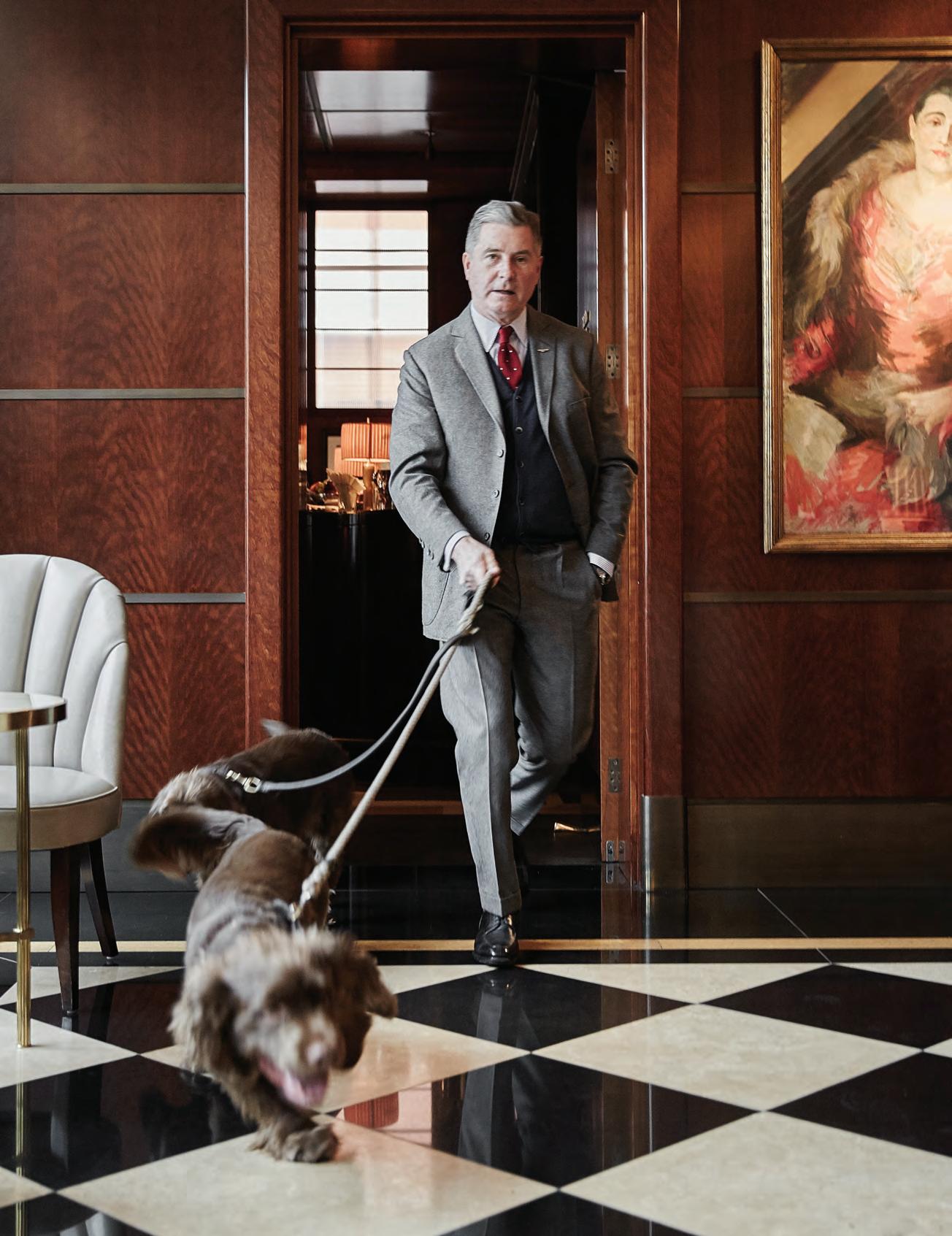
JEREMY HACKETT SHOT BY NICK TYDEMAN IN THE BEAUMONT HOTEL
The INFLUENCER ORIGINAL
FORTY YEARS AGO, JEREMY HACKETT CREATED A BRAND THAT TAPPED INTO A ROMANTICISED VISION OF TRADITIONAL ENGLISH DRESSING, OFFERING A HOMEGROWN VERSION OF WHAT RALPH LAUREN WAS DOING OVER THE POND. AS THE SHARP-SUITED ENTREPRENEUR-DESIGNER TURNS 70, HIS EPONYMOUS BRAND CONTINUES TO RESONATE AS MUCH ON THE FOOTBALL TERRACES AS IT DOES ON THE POLO PITCH
Words: Josh Sims
eremy Hackett had his first bespoke suit made for his first Holy Communion. Despite being only seven years old, he can recall asking for a ticket pocket to be sewn into his jacket to match the one he’d noticed on the suit of the tailor measuring him up. “I still have a ticket pocket sewn into all of my suits for that very reason,” says the Bristolborn entrepreneur-fashion-designer. He also managed to convince his parents that the heavy, grey worsted wool they’d chosen for the service wasn’t the way to go. “In the end, I went for a grey Donegal tweed,” says Hackett. “What can I say? I was a very precocious child”.
How time has flown. This year, not only did Hackett turn 70, but the company he co-created with his business partner, Ashley Lloyd-Jennings, turned 40. Hackett the company is marking the occasion with a ‘1983’ capsule collection, as well as with the creation of a special tweed cloth, some snazzy argyle sweaters and the return of some uniquely British plus-fours.
Hackett the man, meanwhile, says he’s still riding high from the 2019 launch of J.P. Hackett, a four-storey, made-to-measure and bespoke Savile Row store that returned the brand to its tailoringoriented origins. Today, Hackett operates in
more than 150 stores around the world, counting Aston Martin, the Henley Royal Regatta, Williams Racing and the British Army Polo team among the institutions with which it’s collaborated. It’s a far cry from the founding partner’s humble beginnings –buying and selling second-hand suits from a stall on Portobello Road to a generation of men who might have had Savile Row in their blood, but didn’t quite have Savile Row money in their pockets.
“We went through a lot of dead men’s wardrobes,” laughs Hackett. “We’d get old ladies coming to tell us that their husbands had died and asking if we could clean out their closets. But we weren’t really selling ‘vintage’ as fashion then, not as it’s widely sold now, anyway. We were selling to young City guys who saw more sense in buying a good-quality second-hand suit than buying a new one for the same price from a high street retailer like Marks & Spencer.”
Demand soon started to outstrip supply. So –“with no business plan, no marketing plan and no money” – Hackett and Lloyd-Jennings began manufacturing their own suits. “It could have gone badly wrong,” says Hackett, “but, to our surprise, it all took off very quickly. Not long after we got going, I went to a market where there was this rail of tweed jackets. Among them I spotted a Hackett. It was much more expensive than all the others, so I asked the guy why. He turned to me and said, ‘well, it’s Hackett, you know?’ That’s when I knew that perhaps we’d arrived at something.”
What Ralph Lauren did with Ivy League style, Hackett did with a not-too-dissimilar, quintessentially British, upper-class aesthetic –selling a hyper-real “romanticised” sartorial vision of Britishness as Britons wanted to see themselves. Hackett was refined, aristocratic – a brand that rode the Sloane Ranger wave of the late 1980s, making referential nods to polo and rowing, classic cars and country estates.
“There was a time when everyone who came into the shop was wearing a broken-down pair of Gucci loafers,” says Hackett. “Everyone who worked there seemed to have a hyphenated surname. All we did was offer, as we called it, ‘essential British kit’. For us, it had nothing to do with fashion. Some men are just not very good at wearing clothes, but they liked Hackett because, like English style in general, it was straightforward.”
Preppy and romanticised like Ralph Lauren, yet less stiff and a whole lot quirkier, it was Hackett that
J
What Ralph Lauren did with Ivy League style, Hackett did with a not-too-dissimilar, quintessentially British, upper-class aesthetic

© NICK TYDEMAN
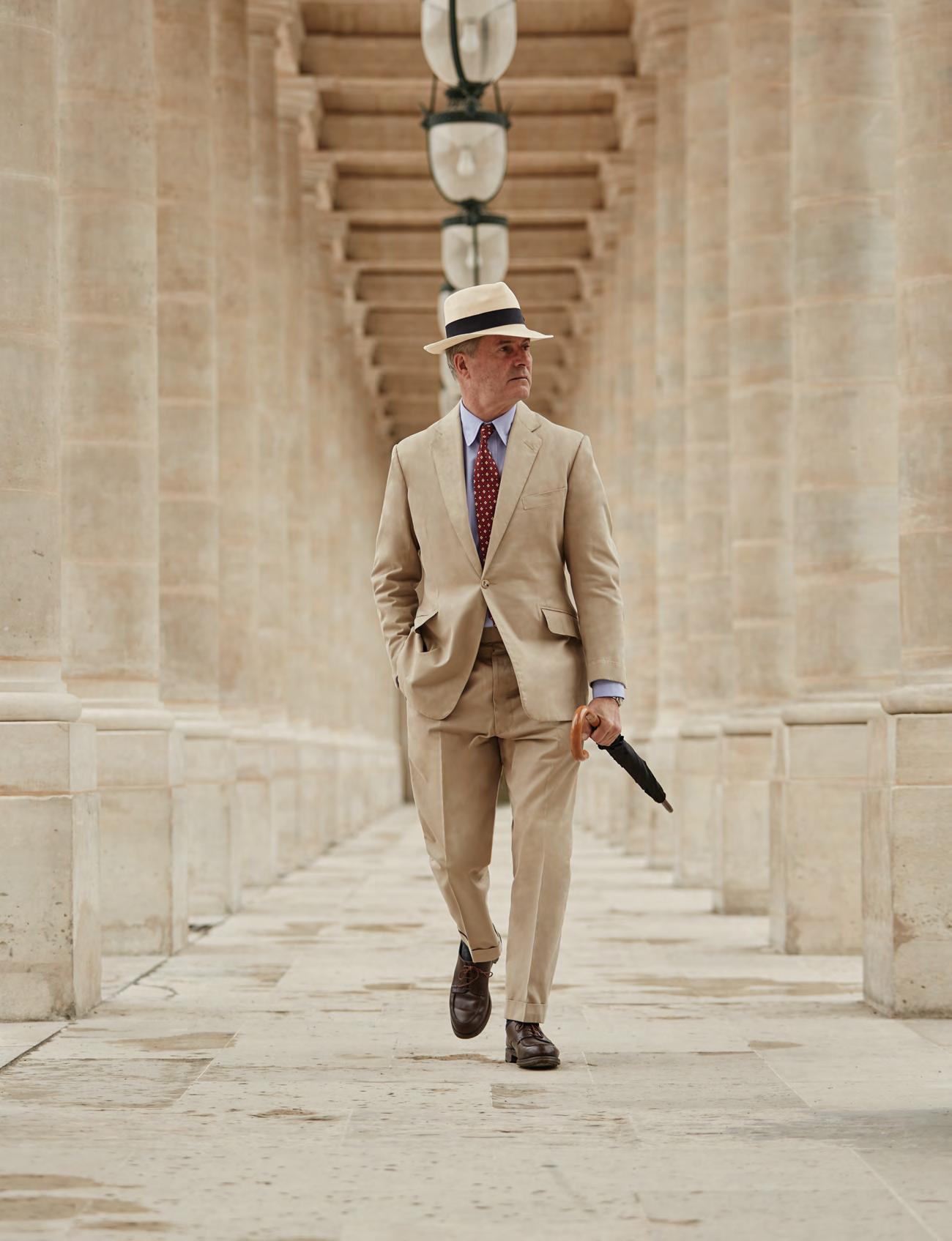
© NICK TYDEMAN
resonated more, in the beginning at least, on the continent than the yuppie American brand. Hackett – who now counts Mr Ralph Lauren as a customer –opened his first European store in Madrid in 1989, followed by a flagship on Paris’ Rive Gauche in 1994. It is Italians, however, who Hackett believes “remain the best-dressed Englishmen.”
“A couple of years ago, I was invited to Naples to give a talk to a gentleman’s club,” he says. “There were about 60 guys all dressed in a way that was far more British than I was. But you could still tell they were Italians because they were too good at it. They put their dress together with consideration. Brits tend to just throw it on and then wear their clothes until they’re falling apart.”
Italians may be famous for their ‘sprezzatura’ way of dressing, but these days it is the English, says Hackett, that have perfected that supposedly carelessly-elegant aesthetic. “We are a little freer,” says Hackett, “a little more at ease with how we dress. The other day I was with David Hockney, who is perhaps the embodiment of that look, he always looks thrown together but always looks brilliant. He came into the shop years ago and did a little doodle on a Post-It Note before he left. Unfortunately I lost it – that could have been my pension.”
Personally, Hackett has far simpler tastes than his eccentric artist friend. “It’s the simple aesthetic of things that I’m really interested in. Watches, for example. I like the look of them but I’ve no idea about all the mechanical stuff. It’s the same with cars. If something has character, if it’s put together well, that’s enough for me.” The details matter, though. “I don’t mean simple as in no character. With any product, there’s a fine line between simple and boring. There has to be something that makes it interesting. But it only needs to be a little touch.”
Sartorial whims have, of course, evolved
considerably since Hackett started out 40 years ago. The brand has sold polo shirts since the 90s –adopted as much by football fans as by polo players themselves – and these days sells everything from gilets and puffer jackets to swim shorts and sports holdalls. The company even does a pair of tailored jogging bottoms. Hackett is, however, aware that too much change would be anathema to many of his customers’ traditional sense of ‘national dress’.
When the company dropped its bowler-hatand-crossed-umbrellas logo a few years ago, for example, a flurry of customer complaints saw the decision quickly reversed. This is, after all, a brand – and Hackett is quick to point out that he hates that word – that people often think is much older than its 40 years.
“Clients are always surprised when I tell them the company wasn’t founded by my grandfather,” he laughs. “Some people have this preconceived idea about the ‘brand’, as they do about me. At home, I’m more likely to be found in a sweater and jeans. Somehow, though, they imagine me sitting there in a smoking jacket, tartan trousers and monogrammed velvet slippers. I suppose you have to live up to the image a little bit – perhaps it’s best that I don’t dispel that picture.” Perhaps.
14 Savile Row, W1S 3JN, hackett.com
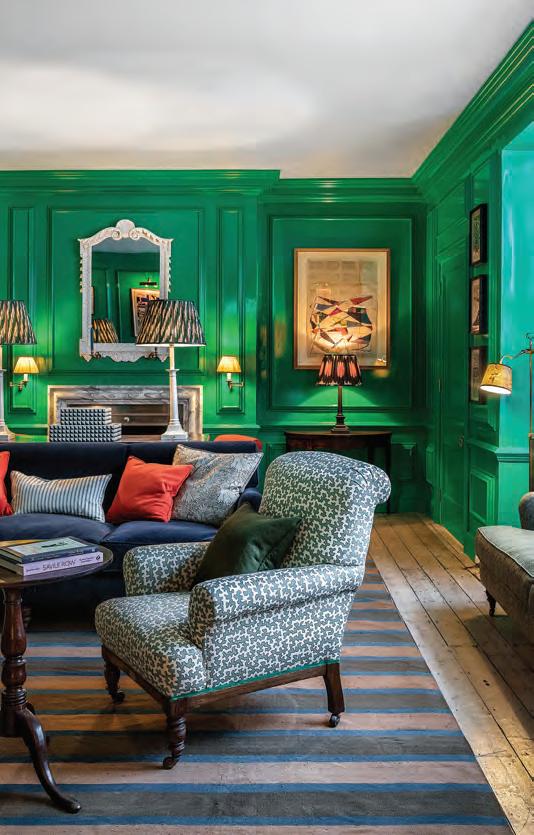
95 LUXURY LONDON COUTURE LUXURYLONDON.CO.UK
When the company dropped its bowler-hat-and-crossedumbrellas logo a few years ago, a flurry of customer complaints saw the decision quickly reversed

www.indian-ocean.co.uk 020 8675 4808 BALHAM - HARRODS - HAMPSTEAD
TO STRIVE, TO SEEK, TO FIND...
Escape
98 Undiscovered Bali For a honeymoon unlike any other make for the Indonesian rainforest 106 Blissed Out There’s a diminutive Caribbean island that punches far above its weight 114 Sevillian Surprise The secluded 17th-century palace-hotel with plenty of charm

 Hoshinoya Bali is constructed on the side of a ravine, meaning that ‘relaxation pods’ seem to float in the trees, p.98
Hoshinoya Bali is constructed on the side of a ravine, meaning that ‘relaxation pods’ seem to float in the trees, p.98
WELCOME TO THE JUNGLE
WHEN ON HONEYMOON YOU NEED TO HEAD TO THE BEACH, RIGHT? WRONG. PACK YOUR BAGS FOR THE UBUD RAINFOREST, WHERE SHARED HINDU BLESSINGS, GREEN PATCHWORKS OF RICE PADDIES AND SKETCHY MOPED RIDES AWAIT...
Words: Hannah Lemon



THE HOLY SPRINGS AT THE PURA GUNUNG KAWI SEBATU TEMPLE
cemetery isn’t where I was expecting to spend my honeymoon. In front of me, three cow effigies are on fire. The 12-foot flames are licking gold embellishments and palm leaf blessings up to the sky. Behind me, two small explosions pop in the air as more coffins are set alight. It’s my first hypnotic, if not slightly disconcerting, experience of a Hindu cremation.
Let’s go back to how I ended up here. My husband and I got married four days ago in the Northamptonshire countryside, and decided to leave soggy Britain ASAP. So we booked a trip to the much-hyped Indonesian island of Bali.
To avoid the tourists, we nestled in the rich rainforest at Hoshinoya Bali, set away from the bustling downtown of Ubud in the north. It’s an ideal place to decompress after a 17-hour flight from London and a long weekend with the extended family.
I’ve been to several Hoshinoya hotels before. The Japanese brand has a refreshing knack of incorporating local landscape into its designs. In Kyoto, you sail down the Katsura River on a traditional yakatabune boat to check in; at Mount Fuji you’re cleverly hoodwinked into thinking your glamping in a pine forest.
Their soul sister in Bali does not disappoint. The resort is artfully built on one side of a leafy ravine. Relaxation pods seem to float in the trees, where you can take in the views of the adjacent towering palms with a glass of ice white tea. Rushing torrents of the Pakerisan River below filter up as a soft hum. The bedrooms are set back into the hillside, each one joined to a 70-metre central pool that meanders past the balconies like a lazy river.

Our villa, one of 30, is neat and precise, a signature style of Hoshinoya’s Japanese aesthetic. The bed is raised off the floor by only a small wooden platform, and floor-to-ceiling windows wrap around the whole building, with wooden panes reminiscent of traditional koushi-do woodwork.
All we can bear to do on that first afternoon is recline like Antony and Cleopatra on our outdoor gazebo underneath the alang-alang grass thatched roof. Butterflies the size of my palm flitter past and we spot the odd lizard scuttling up a tree.
Green rice fields, piled on top of each other like neat layers of cake, have become a tourist sensation in Bali. If you head to the more popular destinations, like the Ceking Rice Terrace, you’ll be swamped by influencers snapping selfies on swings while farmers are hard at work.
Bedrooms are set back into the hillside, each one joined to a 70-metre central pool that meanders past the balconies like a lazy river
THE POOL AT HOSHINOYA BALI
A

THE PURA GUNUNG KAWI SEBATU TEMPLE
To avoid them, we take up the hotel’s complimentary offer of a more intimate tour of local farms. The viridescent shade of the rice is almost unbelievable. Blades of grass poke out of the water, 20 centimetres apart, like flecks of green highlighter. Farmers, ankle-deep, wave as we walk past. They sow the rice by hand into regimented lines and then harvest it with a scythe when it’s ready after around three months. Later, we see a group of women sifting debris from sun-dried grains using handwoven baskets, chucking the rice into the air like a pancake.
As we meander through the system of waterways, we hear bells and cymbols merrily tinkle in the distance. Our guide tells us that it’s coming from the cemetery. The local villagers will be performing a Hindu cremation tomorrow – it only happens every five years and everyone is welcome. Including us.
At one o’clock the following day, we follow a small crowd onto the street at the entrance of the cemetery. Women are wearing their Sunday best – a lace kebaya top, a kamben (sarong), and a bright sash around the waist – and are busy making offerings of palm leaves filled with flowers, rice,
fruit and incense. The men play instruments or carry and swirl large coffins to the cremation site. These handmade coffins take the shape of cows, bulls or lions set in a wooden tower, each one only as elaborately dressed as the family caste dictates. Bodies of relatives that have already been buried are exhumed, no matter how recently, and their bones washed. The bones are then wrapped in a white cloth and placed inside the family’s coffin. Blessings are placed on top, and then the whole thing is burnt to set the spirit free. Eventually, families gather up the ashes and sprinkle them into the ocean.
Far from a morbid British funeral, a Hindu cremation seems like a great chance to catch up with friends and family. People chat, eat steamed corn on the cob, or buy freshly-cooked chicken from one-man vendors that have suddenly popped up. We buy some noodles and watch the ashes decorate the sky like confetti.
With an invigorated interest in Hindu culture, we decide to explore further afield that afternoon. The best way to get around Ubud, if you dare, is by motorbike. Cars end up in traffic for hours and there’s little public transport. Hoshinoya organises

ABOVE
A GUESTROOM AT HOSHINOYA BALI RIGHT THE HOTEL’S RESTAURANT SERVES A MIX OF FRENCH, BALINESE AND JAPANESE CUISINE FAR RIGHT THE SPA AT THE HOTEL IS SET BETWEEN THE PAKERISAN RIVER AND THE JUNGLE
a bike hire for us, and before you know it, I’m clinging to my husband on the back of a dinky Honda Scoopy.
Our first temple stop is the large complex of Tirta Empul, filled with tourists waiting for a blessing. We pass a group of American students wrapped in green robes up to their waste in holy water, hoping for a miracle. The second, Gunung Kawi, is even more impressive. After you reach the bottom of more than 300 steps, there’s a clearing where 10 shrines have been carved into a rockface. It’s like setting foot in Indiana Jones.
Back at Hoshinoya, we fill our rumbling bellies with Japanese and Indonesian dishes. At breakfast, the Indonesian choice is by far the most exciting. It comes on a tray with rice congee (porridge), tum ayam (chicken cooked in banana leaf), a pot of broth and nine condiments. We tinker away mixing our ingredients into bowls like mad scientists; a dash of spring onion here, a boiled egg there.
Most evenings, we venture the half hour into downtown Ubud to find different Balinese restaurants. A firm favourite is the 35-cover Sacred Rice, perched next to a rice field and hidden away from the bustling streets. This intimate setting serves up affordable fine dining, with giant jumbo prawns and tamarind Balinese pork. There’s also Café Wayan & Bakery, which started out as a little bamboo food stall back in the 80s and is now 10 times the size. Nasi goreng is a must here. It’s a herbed rice dish served with chicken, vegetables and a fried egg on top – and it’s all
anyone eats. We wash it down with a bottle of the local Bintang beer.
The most romantic dinner, however, is a 10-course set menu in one of Hoshinoya’s floating gazebos. Plates are filled with bite-size pizzazz, from a Borrowers -sized bowl of fragrant tomato gazpacho to delicate slices of seared tuna in a rich charcoal and mustard sauce. Surrounded only by candles and jungle, it’s hard to beat.
Of course, you should leave plenty of time to disappear into a spa. Bali and massages are synonymous. At Hoshinoya, the spa is at the bottom of the verdant hillside, only accessible by a clunky funicular. An unnecessary addition, but a quirky touch that we try a few times, even without a reservation. A flower-strewn post-massage bath is mandatory, particularly with the real-life wallpaper of the rainforest facing you.

While most people spend their honeymoon sipping mai tais in the Maldives, we pack in jungle adventure. We’re up at 7am saluting the sun at the complimentary yoga session or sampling tropical spices at the wedang tea station. Then there’s traditional dancing to try, Batik dying to do, or a workshop on Balinese crafts. But the highlight for me is waking up each morning to see the sun rise up from behind Mount Batur in a soft, orange haze. It’s a pretty spectacular way to start married life.
Stay at Hoshinoya Bali from 9,800,000 IDR (approx. £500) per room per night (two sharing, room-only), hoshinoya.com

103 LUXURY LONDON LUXURYLONDON.CO.UK ESCAPE
A flower-strewn post-massage bath is mandatory, particularly with the real-life wallpaper of the rainforest facing you
CELEBRATE A NEW ERA OF LUXURY

SEVEN SEAS GRANDEUR™
A Heritage of Perfection
Decades of experience and masterful craftsmanship, married with the finest materials and stunning designs, deliver elegant comfort and style for the very best of luxury cruising. Experience this Heritage of Perfection for yourself on a voyage you’ll never forget.
START YOUR TRULY ALL-INCLUSIVE JOURNEY AT RSSC.COM CALL 023 8082 1378 OR CONTACT YOUR TRAVEL ADVISOR



AD231101_Grandeur_LuxLon_DPS TO LEARN MORE AND START YOUR JOURNEY, SCAN THE QR CODE CALL 023 8082 1378 VISIT RSSC.COM/ORDER-BROCHURE OR CONTACT YOUR TRAVEL ADVISOR
SMALL WONDER
NESTLED BETWEEN ANTIGUA AND PUERTO RICO, NEVIS IS THE TINY CARIBBEAN ISLAND WITH A LARGER-THAN-LIFE SOUL
Words: Rob Crossan

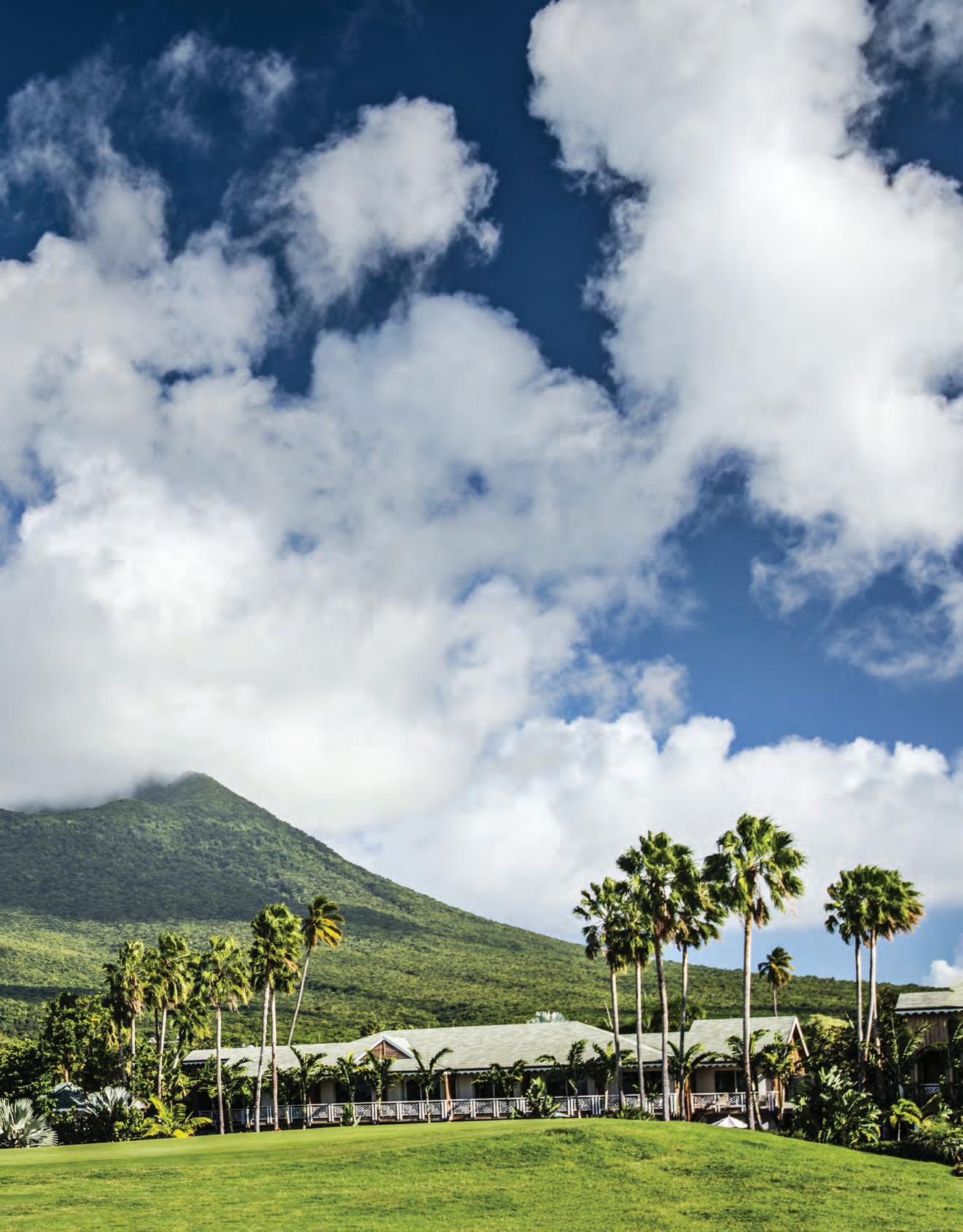
NEVIS PEAK, AN INACTIVE VOLCANO THAT LAST ERUPTED MORE THAN 100,000 YEARS AGO
hen historical accuracy loses the battle with creative license, what’s sacrificed in the name of a good story, painting, movie or, in this case, musical, can have unexpected consequences.
Such is the fate of Nevis (pronounced Nee-vis). If you haven’t heard of the island, don’t admonish yourself. As the sister island of St. Kitts, this Leeward Isles duo make up the tiniest nation in the Western Hemisphere. Shrouded in obscurity compared to its more resort- and charter-flight-friendly neighbours – Barbados and Jamaica, among them – the tale of Nevis is a story of what might have been. Specifically, what might have been if Lin-Manuel Miranda had only found more words to rhyme with ‘Nevis’.
This satsuma-shaped island, home to barely 10,000 people, is all but smothered with ferns, orchards and calabash trees, which yawn outward to the sea. There are also the ugly remnants of sugar and cotton mills; a slowly vanishing physical reminder of the island’s dark history as a slave colony.
It was into this environment that Alexander Hamilton came into being, either in 1755 or 1757, depending on which encyclopaedia you consult. Born out of wedlock to Rachel Faucett and James A. Hamilton, the failure of his half-Huguenot mother and Scottish father to marry (caused, in part, by Hamilton Snr’s subsequent desertion and the desire by Rachel’s Danish husband to have her imprisoned for adultery) meant that young Alexander was shunned by the bien pensants of Nevis.
By the age of eight, mother and son had moved to St Croix in what is now the US Virgin Islands, where the precocious child began his first steps towards a career that would see him serve the presidency of George Washington as the inaugural First Secretary of the Treasury.
Posthumous fame may have been assured in the States – Hamilton’s face adorns the $10 bill, after all. Yet it was the songwriter-playwright LinManuel Miranda that broadcast Hamilton’s legend through a global megaphone. Fusing R&B, hiphop and rap, his eponymous musical about the mercantile pioneer gave the story of Hamilton the most unlikely of revivals; as the hero of the most celebrated musical of this century.
Lin, however, failed to mention Nevis even
Wonce in his show – an omission that continues to grate on locals, even over a decade after the show’s Broadway debut. Feelings of resentment for depriving Nevis of the limelight might linger, but on this six-by-eight-mile island there’s one geographical feature whose resurgence is even less likely than that of Hamilton’s legend.
ww Unlike neighbouring Montserrat, whose own volcano blew in the 1990s, causing two thirds of the island to be abandoned, there is no threat from this peak anytime soon. The only pain and peril promised by this volcano will target the shins and thighs of anyone who attempts to climb it.
Dear Reader, I am 13 stone, walk two miles a day and haven’t drunk a can of Coke or eaten oven chips since the 1990s. But the peak defeated me and my moderate fitness levels around two thirds of the way up its 3,232 feet.
It started so gracefully; trekking through rough paths, hacked out of a riotous tangle of mosscoated tree trunks, ferns and orchids with nothing but my guide, Devito, the insistent trilling of tree frogs and the occasional scurry of green vervet monkeys for company.
Then came the ropes. Tethered to tree trunks, gripping these slippery lengths was the only way to haul myself up some ludicrously steep gradients, while what was merely soft, black soil in the lower part of the peak gave way to mud the colour and texture of sticky toffee pudding.
I groaned. I sweated. I strained myself up well over three dozen of these roped ascents until I could take no more and, after two hours of the most physically arduous exertion I have done since walking the perimeter of the Glastonbury Festival looking for my girlfriend’s car in 2013, I collapsed into some bushes a mere 30 minutes’ walk, according to Devito, from the summit.
Still, the view from my point of failure was sensational. A break in the melange of jungle and cloud cover revealed a vista stretching out over the parish of the island known as Gingerland; a bucolic stretch of tin-roofed cottages, speckled like sea-smoothed pebbles among the sprouting, verdant greenery of ancient sugar plantations that suddenly scissor-cut into the green and cerulean blue of the ‘Narrows’, the stretch of Caribbean Sea that divides Nevis from St. Kitts.
Respite from my failed attempt to conquer Nevis Peak came in the form of the Golden Rock Inn.
Nevis Peak is a foliage-drenched volcano that last blew its top more than 100,000 years ago

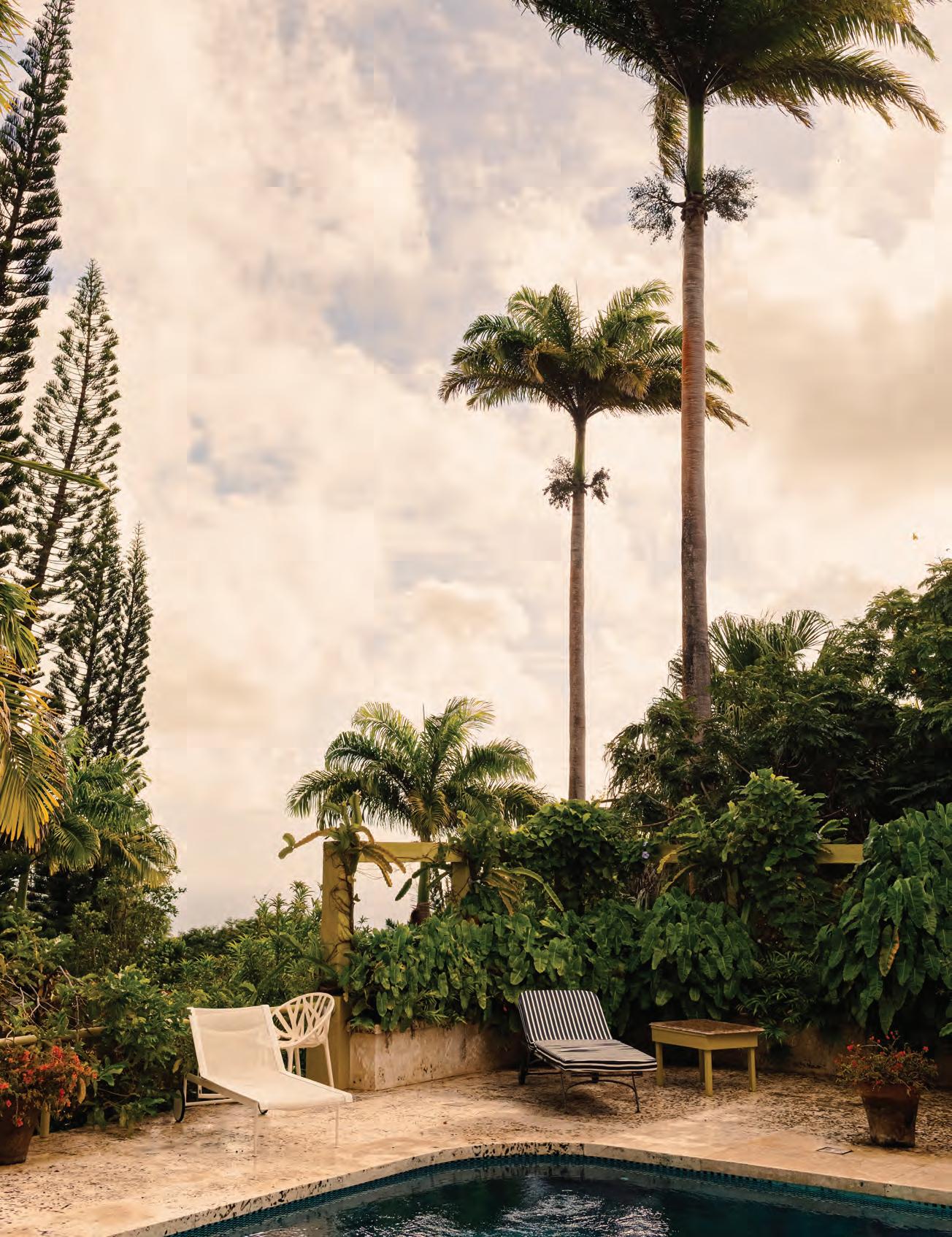
Buried deep in the lower folds of the mountain, this is a boutique hotel built around the remnants of one of the island’s many sugar mills, this one constructed in 1801.
Narrow footpaths wind through a bricolage of cacti and succulents. Only the occasional lizard, scurrying across the grass, gives any indication that anyone or anything defers from the national motto: ‘rush, slowly’. The cottages themselves, just 11 of them, are hidden amid this Lilliputian wilderness along with a large, shaded swimming pool and a restaurant in the main building of the old mill. It serves gargantuan fresh lobster sandwiches at lunch and more piscine pleasures, including grilled snapper and mahi-mahi, come evening.
Amid the quietude, there is one small spot on Nevis where the pace does ratchet a few notches above the permanently somnambulant. Located on a stretch of beach next to the Four Seasons resort (the only genuinely large hotel on the island), Sunshine’s is known throughout the Caribbean for its ebullient owner, Sunshine himself, and his rum punch cocktail, known as the Killer Bee.
As tracks by Toots and the Maytals and Gregory Isaacs filter through the al fresco, mostly wooden bar, festooned in red, green and yellow, the cocktail itself is a delusive creation in the extreme. Heavy on the lime juice and grenadine, it goes down with alarming speed.
Yet, as all Nevisians know, to drink more than two
Killer Bees is to risk a hangover fiercer than a passing hurricane in rainy season. Nobody knows exactly how much rum goes into Sunshine’s cocktails but, after finishing my second Bee, I began to realise that I’d drunk enough rum to begin throwing shapes on the makeshift wooden dancefloor and caring not a jot how ridiculous I looked.
The locals, it seems, have seen visitors react in similar ways many times before. And the tide of collective good feeling at being lucky enough to either live on, or to visit, one of the last Caribbean islands not entirely beholden to large cruise ship traffic is easy to detect.
“Yeah, we know about the Hamilton musical,” one local tells me while, sensibly, sipping a Carib beer as the magenta sun dips steadily into the sea. “He did a lot of amazing things. His only mistake was leaving Nevis,” he jokes. “I’m not planning on leaving anytime soon.”
I wish I wasn’t either. Nevis may have failed to make it into the Hamilton musical, but the island should bleep on the radar of anyone interested in experiencing a slice of genuine, small-scale Caribbean soul. I, for one, am happy for Miranda’s oversight.
Doubles at the Golden Rock Inn from £308 per night, goldenrocknevis.com; British Airways is the only airline that flies direct from London to St. Kitts, return fares from £455, ba.com. Nevis is a 10-minute water taxi from St. Kitts, book tickets at nevisisland.com

111 LUXURYLONDON.CO.UK
Only the occasional lizard, scurrying across the grass, gives any indication that anyone or anything defers from the national motto: ‘rush, slowly’
 Amanbagh, Rajasthan, India
Amanbagh, Rajasthan, India
How you choose to see the world creates the world you see. Why merely see it when you can experience the best of it?
In the hands of exceptional people, your sojourns will be sensational, your escapades flawless. We harness the power of travel to enable you and the communities you visit to live extraordinary and fulfilled lives. Use our time to save yours and let us introduce you to experiences and people that will enhance your world-view and ignite your passions in places that will leave you lost for words.
carrier.co.uk
@carrierluxuryholidays

Frying the Out of Pan
IN WHITE-HOT SEVILLE, A LOVINGLYRESTORED CASA PALACIO OFFERS

REFUGE FROM THE SCORCHING HEAT
Words: Richard Brown

 THE ROOFTOP WALK ABOVE THE METROPOL PARASOL, A LATTICEWORK OF WOOD THAT COVERS A MARKET, RESTAURANTS AND ARCHAEOLOGICAL MUSEUM
THE ROOFTOP WALK ABOVE THE METROPOL PARASOL, A LATTICEWORK OF WOOD THAT COVERS A MARKET, RESTAURANTS AND ARCHAEOLOGICAL MUSEUM
S
teaming Seville, the Andalusian capital, Spain’s fourth largest metropolis and the country’s second most attractive city – Granada topped it, narrowly, in a recent poll by online travel site Telling History – looks like the setting of a film. Because it is.
Most recently, Seville’s Royal Alcázar, a 14thcentury Christian palace constructed over an even older Islamic castle, served as the Water Gardens of the House of Martell in Game of Thrones. The same citadel served as Sir Ridley Scott’s Jerusalem Palace in 2005’s Kingdom of Heaven, a film that elsewhere made use of another of Seville’s spectacular palaces, the 16th-century Casa de Pilatos. When George Lucas was looking for an otherworldly setting for the phantasmagorical Theed city in 2002’s Star Wars: Attack of the Clones, he settled on Seville’s Plaza de España, a vast semi-circular arcade of arches and alcoves built in 1928 for the Ibero-American Exhibition of 1929. Seville has been acting as a film set as far back as 1962’s Lawrence of Arabia.
It’s a scorching backlot that data suggests is only getting hotter. Last year, the city, which lays at the bottom of a valley 80 kilometres away from the cooling effect of the ocean, became the first in the world to start naming extreme heatwaves, in the same way that the rest of the planet names hurricanes.
The first, Zoe, arrived in July 2022, with temperatures peaking at 43°C. The second, Yago, landed in June 2023, nudging the mercury to 43.9°C. That was a regional record. The hottest part of the day is between 5pm to 7pm. The summer months have become so hot that even the locals leave. They make for Cadiz, down on the coast. We visited Seville in the last week of February. It was averaging 21°C even then. Seville is great for winter sun. It’s far closer than the Maldives.
Less than a 10-minute walk from the city’s twisting UNESCO-protected Old Town – one of the largest in Europe – is a cobbled street called Corral del Rey. Behind a heavy-studded Moorish door is the low-key reception of a splendid little hotel of the same name. A former ‘casa palacio’, or palace home, the thick-set 17th-century building has been tastefully transformed into a soothing 17-bedroom bolthole that boasts many
of its original features, including marble columns, Mudéjar-style doors and ancient timber beams. Anything that isn’t exceptionally old has been discerningly handpicked by Kuky Mora-Figueroa to complement everything that is.
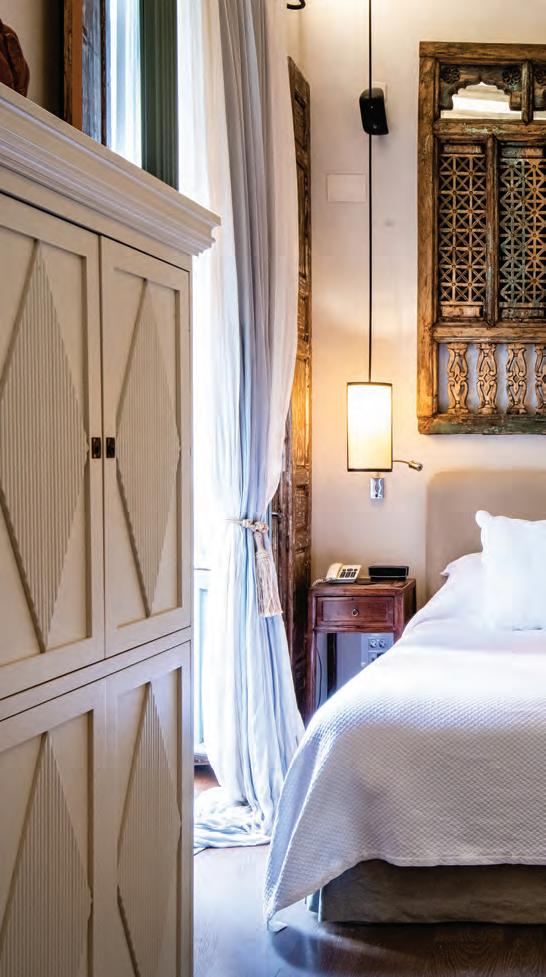
Mora-Figueroa, a free-spirited descendant of one of Andalucía’s most well-heeled families, travelled around India and Asia before returning to Spain to marry Englishman Tim Reid, a hotelier who’d worked for Mandarin Oriental and the ShangriLa Group. In 1992, the couple opened Hacienda de San Rafael, an 18th-century olive-mill-turnedguesthouse on an idyllic patch of countryside 45 minutes outside of Seville.
Just as she’d done at Hacienda, when the couple opened Corral del Rey in 2007, MoraFigueroa occupied the hotel with curios from her extensive travels. Rugs from Morocco, antiques from Asia, restored fabrics from France. On the walls, and for sale, are pieces by Henry John and Enrique Vara – indicative, perhaps, of the hotel’s Anglo-Spanish heritage.
When the couple opened Corral del Rey, Mora-Figueroa occupied the hotel with curios from her extensive travels. Rugs from Morocco, antiques from Asia, restored fabrics from France
From the main building Corral del Rey expanded into another former noble house across the street, as well as into an adjacent annex. In total, however, there remain only 17 rooms. Each is a quirky mix of natural textures – stone, wood, marble – individual furniture and high-tech mod cons. Our room had a rainfall shower in the bathroom and a standalone bath not too close to the end of the bed.
The hotel is now in the hands of Kuky and Tim’s sons; Anthony, who gained his hospitality experience while working for a members’ club in Mayfair, and Patrick, previously of luxury tour operator Abercrombie & Kent. The pair preside over a small place with a big personality. A low-key, high-minded hideaway from the breath-taking furnace outside.


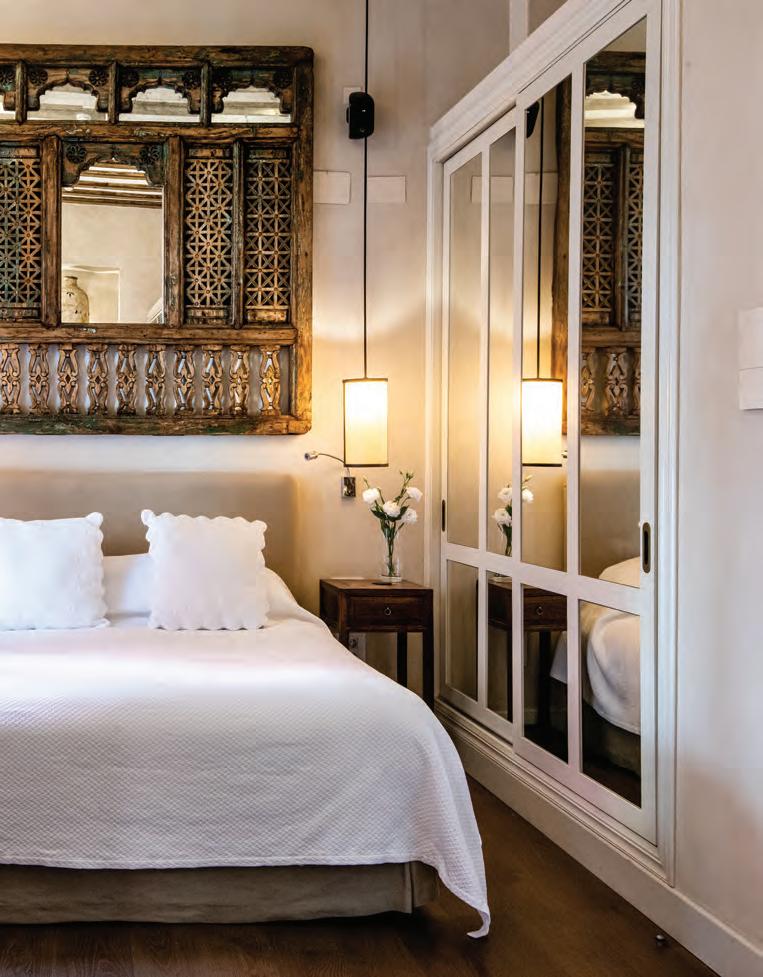
From £260 per night, corraldelrey.com

117 LUXURYLONDON.CO.UK
Each room is a quirky mix of natural textures – stone, wood, marble –individual furniture and high-tech mod cons
The NEW Office Party
DON’T LET YOUR BOSS GET AWAY WITH A BORING CHRISTMAS DO THIS YEAR. TELL THEM TO TRY ELECTRIC XMAS, INSTEAD

Let’s be honest, work parties can be a drag. Cheesy music, drooping paper hats, microwaved party food becoming staler by the second… But no more. This year, pass on the tinsel and let the professionals at Smart Parties help. Kick off the festive period with a bang rather than a whimper at Electric Xmas – the hottest Christmas party in town.
Electric Xmas will take place at Magazine London, the 19,994 sq m purpose-built destination for parties – and the largest event space of its kind in the capital. It’s also conveniently located, about 10 minutes from London Bridge tube station.

Allow us to take you on a tour. Enter into an urban, neon-clad wonderland, with towering ceilings and panoramic views of the River Thames, Canary Wharf and the City beyond. A live orchestra plays chilled-out electro beats as you sip your welcome drink and sample hot and cold canapés. As the evening progresses, the music intensifies, and you make your way to the dining room –
a super-chic space adorned with neon installations. The food offering at Electric Xmas is a key part of what will make this evening so memorable – a lavish three-course banquet by Magazine London’s in-house caterer, with accompanying wines, champagne and beers. When dinner is finished, the evening can really begin; enjoy live musical entertainment, including a beatbox trio, a pianist and a 12-piece orchestra.
At around 10pm, the DJ takes to the decks and it’s high time to take yourself to the dance floor – but don’t worry, you’ll retain your table for the entire night, so you’ll always have a base from which to give your feet a rest. The night starts to wind down at 12.30am, with coaches departing 30 minutes later (we recommend working from home the next day).
It’s the sort of night that blows party poppers and lukewarm wine out of the water, right?
smartparties.co.uk
A ROOM WITH A VIEW
LAUNCHED IN 2021, THE APARTMENTS AT NEWFOUNDLAND REPRESENT THE PINNACLE OF MODERN DESIGN. ASCEND TO THE 58 TH LEVEL, AND YOU’LL FIND SOMETHING EXTRA-SPECIAL…

HOT PROPERTY
If you are a renter with a thing for spectacular views, you’ll be hard pressed to find better in London.
Newfoundland, Canary Wharf’s built-to-rent skyscraper, is officially home to the highest leasable apartments in the capital.
Newfoundland – which is managed by Canary Wharf’s leasing arm, Vertus – is an engineering feat. The structure, designed by Horden Cherry Lee Architects, soars to 58 stories, with its distinctive diagrid design reshaping the London skyline.
All of the building’s 636 apartments are gorgeous, but if you have that aforementioned penchant for heights, look no further than the Penthouse Collection. These 10 homes reside on the top floor of Newfoundland, and it’s here, 220 metres above the ground, that we find this issue’s Hot Property (or properties).
Vertus launched the Penthouse Collection in 2022: the group comprises one- and two-bedroom apartments, as well as three-bedroom properties of 1,788 square feet. The homes yield mesmerising views eastward over Canary Wharf and the Docklands, and westward towards The City and the rest of London, through floor-to-ceiling windows.

Yet it’s not all about what’s on the outside. Inside, penthouse interiors, curated by David Phillips, are just as arresting, albeit in a different way. Rooms are light, bright and breezy, as you’d want from spaces blessed with as much natural light as these. Tones are mostly neutral, to let the brilliant skies speak for themselves, but when they’re not, colours are playful; perfectly-pitched to lift interiors without distracting from the scenes outside.
Elsewhere, residents of Newfoundland enjoy access to a host of in-building amenities: there’s a games room, a west-facing terrace with a barbecue, an outdoor children’s play area, a ‘kidult’ zone, and a lounge which fully supports a work/life balance, featuring both a bean-to-cup coffee machine and a wine dispenser.
Newfoundland also boasts a gym with two studios, a private dining room, and a screening room with

a wide-screen TV and games consoles. Meanwhile, a 24-hour concierge is in place to assist with, well, anything. Penthouse residents also benefit from membership of Vertus+, which grants access to an exclusive programme of events organised by a dedicated in-house team, as well as spaces for the 9-to-5 that come alive after hours, and partner perks from brands across the Canary Wharf Estate. The amenity offering here is akin to what you’d expect from a five-star hotel.
Finally, this building is placed within one of the most up-and-coming hubs in London: Canary Wharf. If you’ve not lived here before, dispel all preconceptions – the Estate has changed a lot in recent years, now a dining, shopping and culture destination, with Londoners flocking to the spot via convenient transport links including the Elizabeth Line. Newfoundland is within walking distance of a range of new openings including the new padel courts on Bank Street.
This is just one example of the luxury quirks that elevate life at Newfoundland in more ways than just the literal. With the building achieving full occupancy at the turn of 2022/23, view-seekers had better move fast. Visit
121 LUXURY LONDON PROMOTION LUXURYLONDON.CO.UK
thisisvertus.com or contact the Leasing team on +44 (0)20 7418 2600
Rooms are light, bright and breezy, as you’d want from spaces blessed with as much natural light as these
BEHIND
SCENES the
FOR THIS ISSUE’S FASHION SHOOT, LUXURY LONDON WENT BEHIND THE CURTAIN OF THE CAPITAL’S LATEST LANDMARK, THE OWO RESIDENCES BY RAFFLES
Words: Richard Brown
Where better to host a photoshoot intended to showcase AW23’s sharpest tailoring, chicest dresses, finest watches and most spectacular high-jewellery collections than 57 Whitehall?
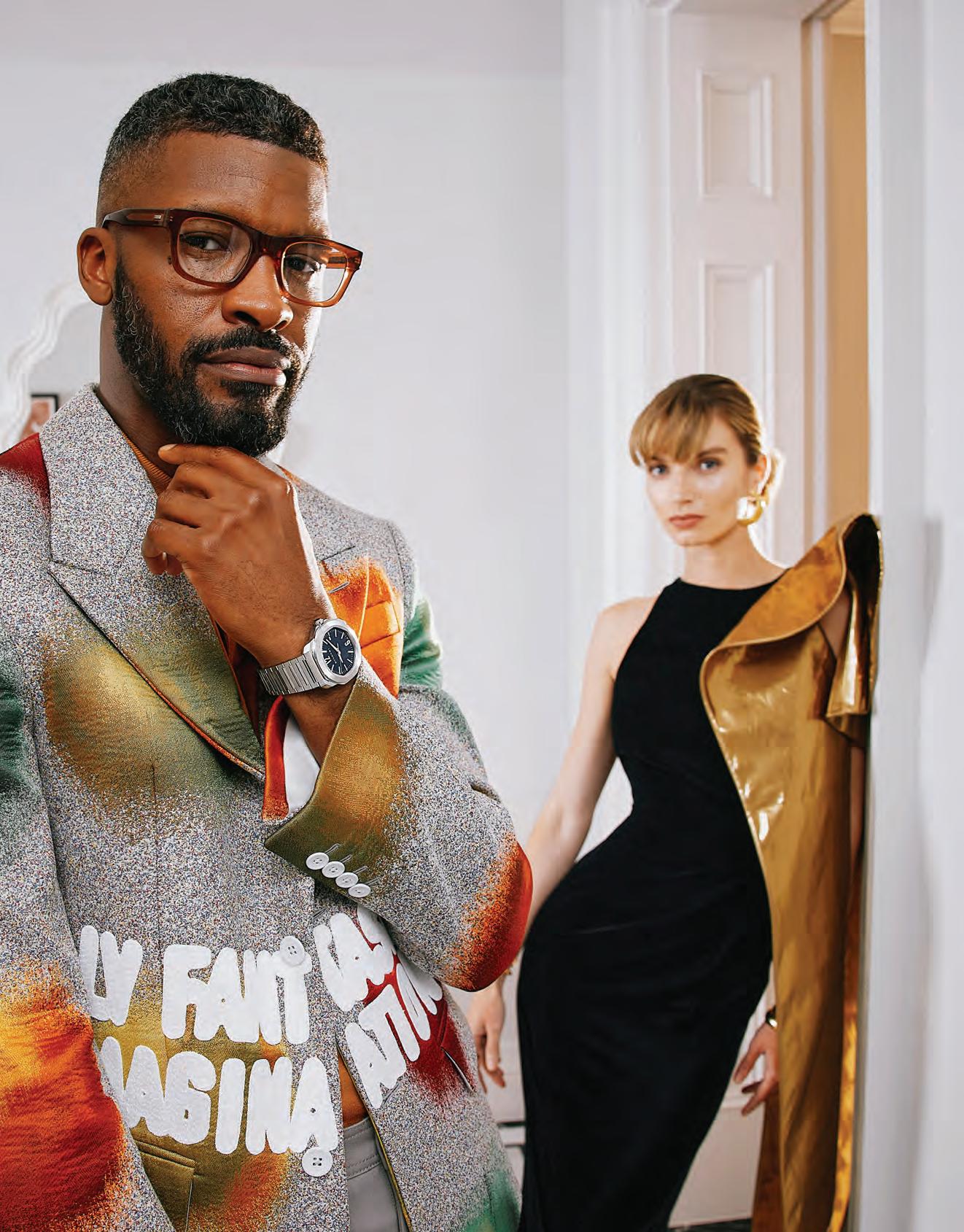
AKA The OWO Residences by Raffles. AKA London’s new most prestigious address.
After a seven-year refurbishment, the first inhabitants have already moved into the 85 residences created out of The Old War Office in Westminster. When we learnt that the longawaited adjoining hotel – Europe’s first Raffles – was set to open in the same week our autumn issue was due to drop, we reached out to our friends at Savills to see if they could help make the magic happen. As you can see on page 16 of our Watches & Jewellery supplement, they were more than happy to wave their wand.
We’ve organised our fair share of fashion shoots over the years, in some truly special locations. But The OWO Residences might just top the lot. Behind the Portland stone façade, interior design studio 1508 London has created a world of hand-laid mosaic floors, painfully-restored period features, ornate plasterwork, tastefully-done chandeliers and oceans and oceans of marble. We could have photographed the entire shoot in the bespoke Smallbone kitchens. Surprisingly, residences are still available. You can get a taste of what lies through the keyhole at the neighbouring Raffles hotel. We’ll see you at the bar.
Apartments from £4,000,000, savills.com

Discover the collection in-store and online at moltonbrown.co.uk NEW Wild Mint & Lavandin
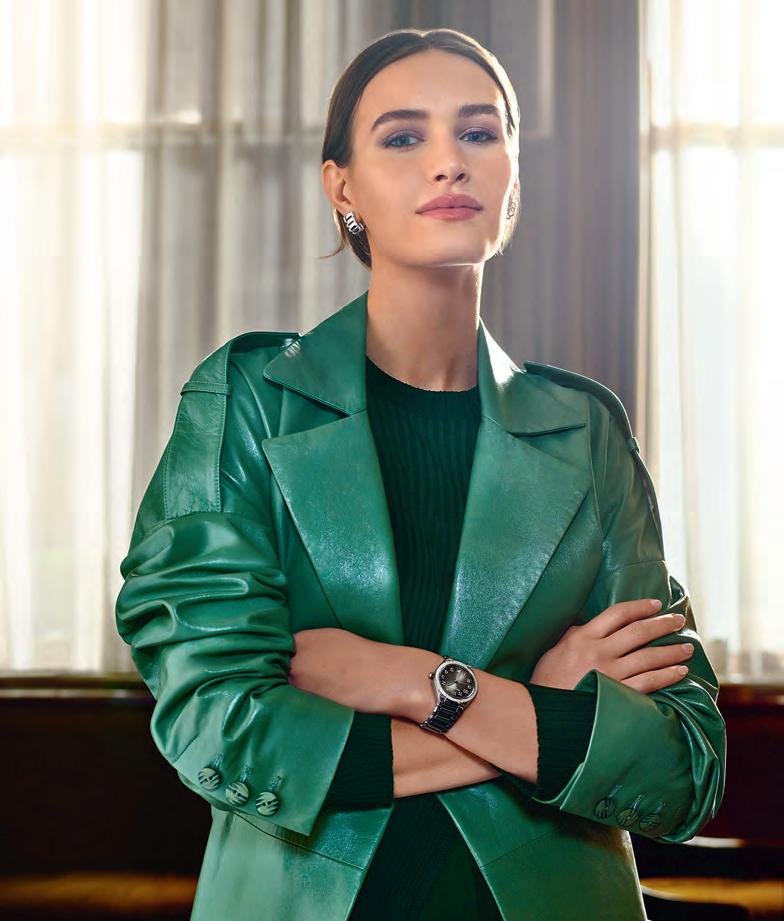






































 Gabrielle Chanel. Fashion Manifesto is on until 25 February 2024, tickets £24, vam.ac.uk
Gabrielle Chanel. Fashion Manifesto is on until 25 February 2024, tickets £24, vam.ac.uk





































 JUDY CHICAGO, IMMOLATION FROM WOMAN AND SMOKE, 1972
JUDY CHICAGO, IMMOLATION FROM WOMAN AND SMOKE, 1972














 Words: Rory FH Smith
Words: Rory FH Smith









 BY HAND & HEART SINCE 1763
BY HAND & HEART SINCE 1763





















































 PHOTOGRAPHER ADAM FUSSELL STYLIST SARAH ANN MURRAY
PHOTOGRAPHER ADAM FUSSELL STYLIST SARAH ANN MURRAY
























 Words: Anna Solomon
Words: Anna Solomon

























 MARKET DIAMOND BAG, £340, Marni, marni.com
Alessandra Rich
MARKET DIAMOND BAG, £340, Marni, marni.com
Alessandra Rich


 Edited by: Anna Solomon
Edited by: Anna Solomon















 BEHIND THE SCENES AT AHLUWALIA’S AW23 SHOW, HELD AT THE CHURCH AT JOHN’S SMITH SQUARE, WESTMINSTER
BEHIND THE SCENES AT AHLUWALIA’S AW23 SHOW, HELD AT THE CHURCH AT JOHN’S SMITH SQUARE, WESTMINSTER





































 Hoshinoya Bali is constructed on the side of a ravine, meaning that ‘relaxation pods’ seem to float in the trees, p.98
Hoshinoya Bali is constructed on the side of a ravine, meaning that ‘relaxation pods’ seem to float in the trees, p.98















 Amanbagh, Rajasthan, India
Amanbagh, Rajasthan, India


 THE ROOFTOP WALK ABOVE THE METROPOL PARASOL, A LATTICEWORK OF WOOD THAT COVERS A MARKET, RESTAURANTS AND ARCHAEOLOGICAL MUSEUM
THE ROOFTOP WALK ABOVE THE METROPOL PARASOL, A LATTICEWORK OF WOOD THAT COVERS A MARKET, RESTAURANTS AND ARCHAEOLOGICAL MUSEUM













